WINE CRITIC EMERGES IN THE PRIVATE CLUB INDUSTRY
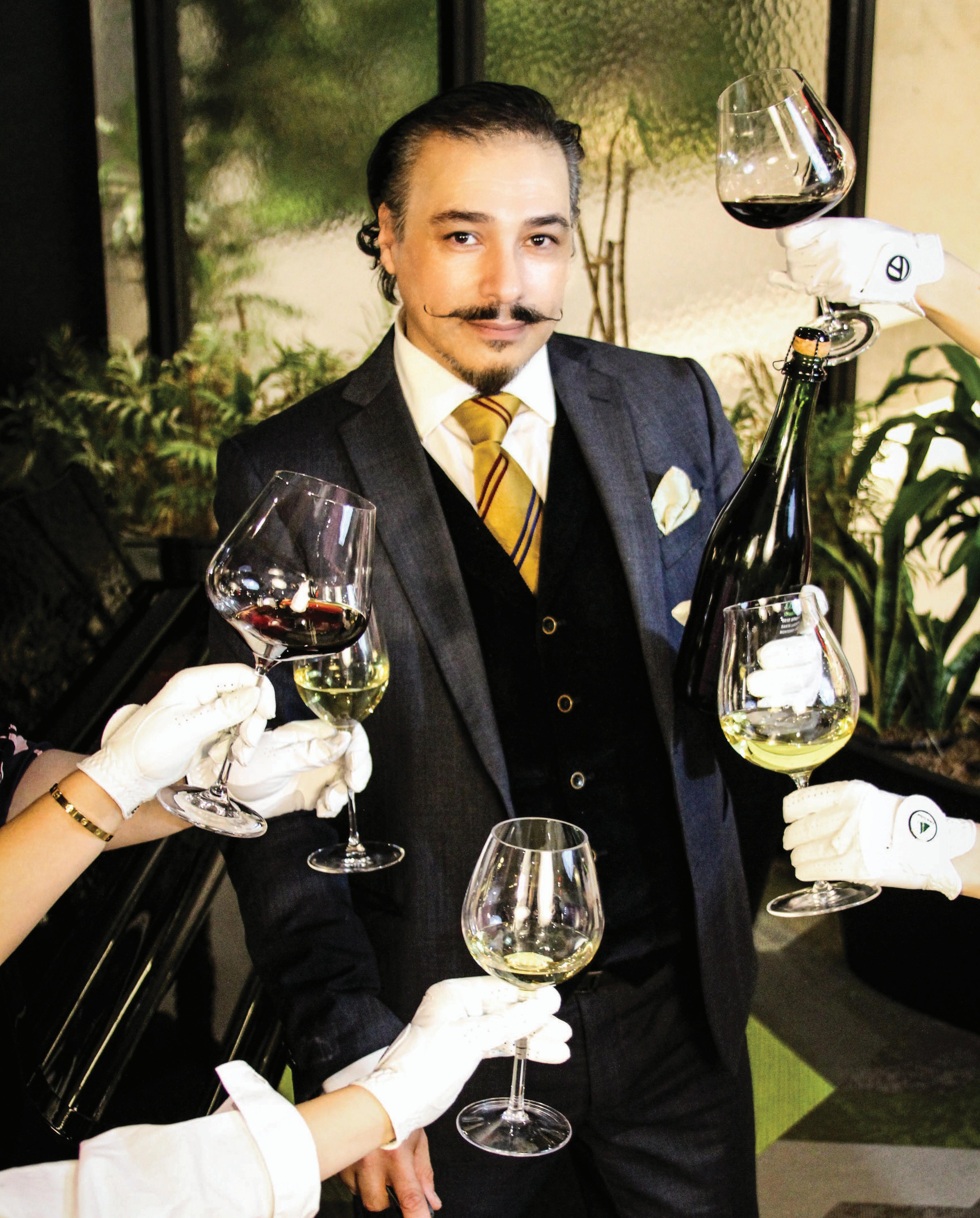
WES TYLER EXECUTIVE CHEF AT THE CLUB AT CARLTON WOODS
CLUBHOUSE COCKTAILS
SHAWN OLAH EXECUTIVE CHEF AT HIGHLANDS FALLS COUNTRY CLUB

ROB LABRITZ SHARES HIS NUTRITION TIPS BEFORE, DURING AND AFTER GOLF

ZOUHAIR BELLOUT A MOROCCAN CHEF WITH INTERNATIONAL APPEAL AT REYNOLDS LAKE OCONEE
A FRESH LOOK AT BARDSTOWN BOURBON
TEN TOP CLUB CHEFS 40 ANd UNdER
www.GolfKitchen.com March - August 2022
n ational g o l f cour s e r e s tauran t a s sociati o n







NGCRA
Proud Sponsors of the Golf Kitchen Culinary Excellence Awards and Invitational at GlenArbor Golf Club
Bedford Hills, New York
September 8th, 2022
www.NGCRA.com
Inquires:

Tory Eulenfeld
National Director of Member Services and Programs
Tory@NGCRA.com
Golf Kitchen Magazine is a biannual publication of Golf Kitchen LLC. Copyright 2022. Print subscriptions are available at www.golfkitchen.com for $59.99 per year.
All rights reserved in all countries. Contents may not be reproduced in any manner without written permission of Golf Kitchen LLC. Golf Kitchen LLC does not necessarily agree with the viewpoints expressed by our contributing writers of articles and advertising copy.
For advertising opportunities please email us at info@golfkitchen.com
Golf Kitchen welcomes letters to the editor at info@golfkitchen.com
The Golf Kitchen Wine Program award is selected and presented at the Golf Kitchen Culinary Excellence Awards annually and determined by an independent team of wine judges based in New York, led by Fernando Silva, Sommelier, Wine Critic, and Wine Educator.
GK Wine Reviews are a unique sales tool for winemakers globally and assist in private clubs becoming aware of your brand. Wine reviews are an outstanding sales and educational tool to improve the wine program at your club.
For more details please email: info@GolfKitchen.com
GOLF KITCHEN Magazine
Let us take care of you the way we take care of our reputation.
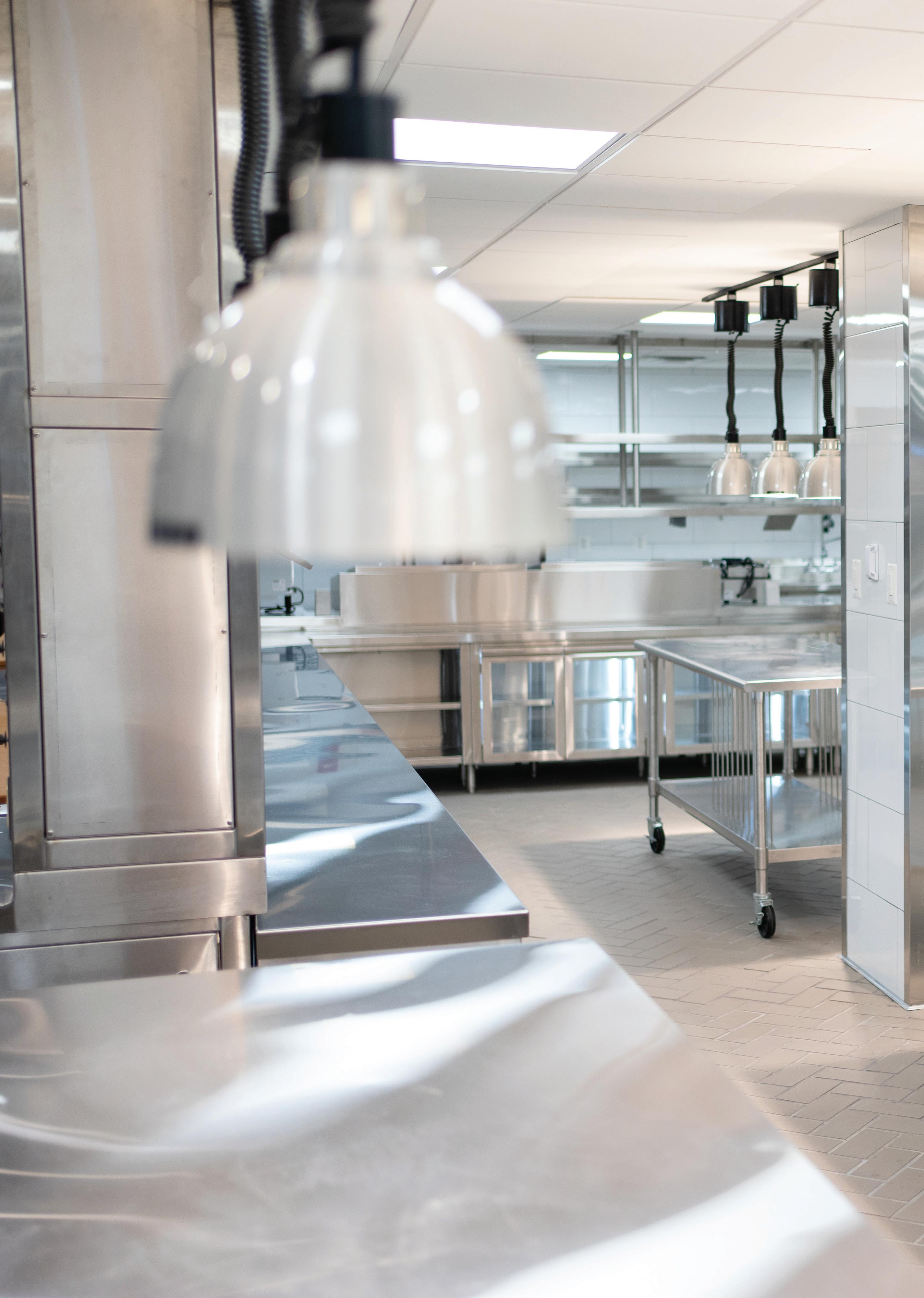
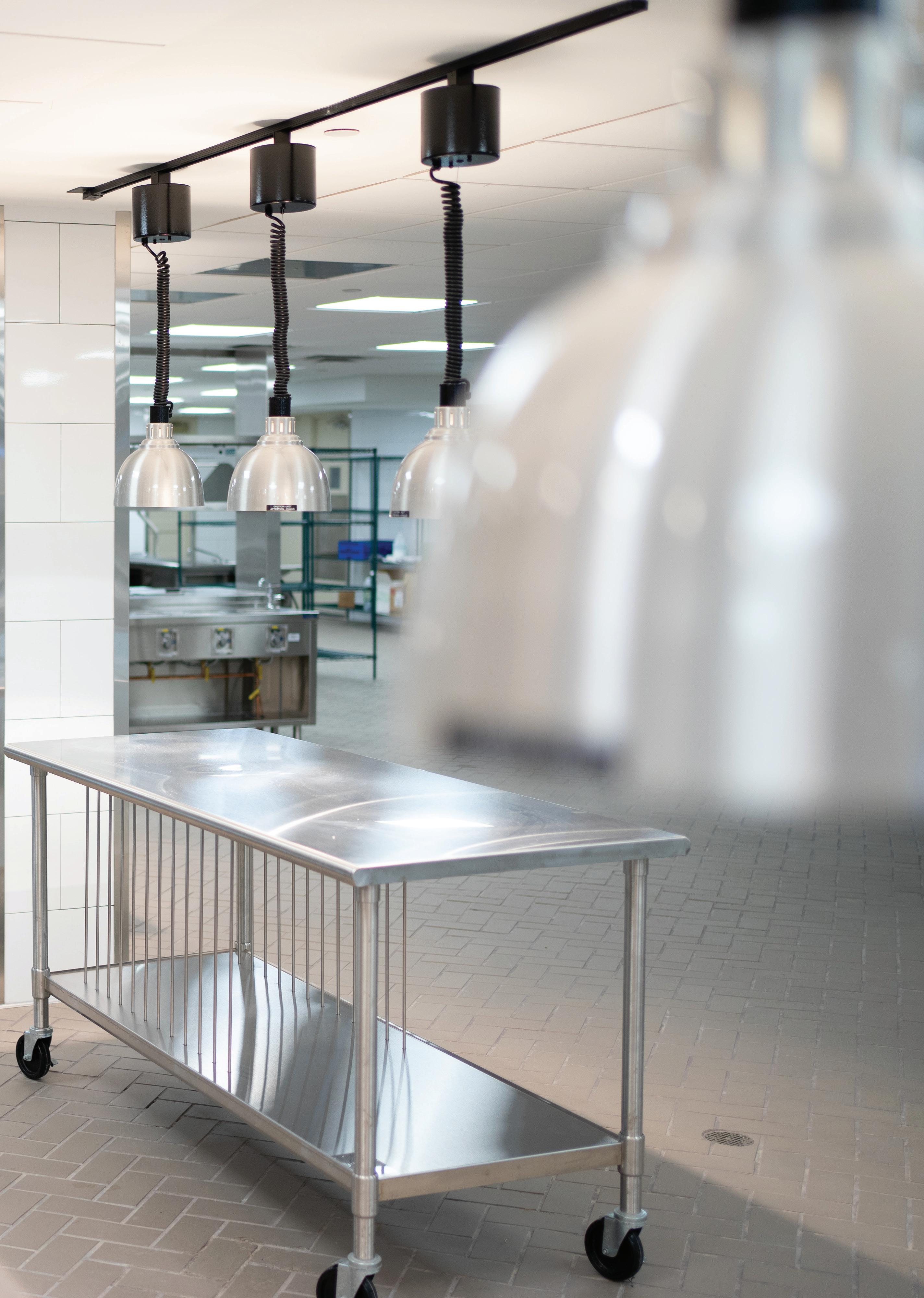





41 CONTENTS MARCH 2022 | AUGUST 2022 88 ROB LABRITZ’ NUTRITION TIPS BEFORE, DURING AND AFTER GOLF 46 COVER STORY: WINE CRITIC EMERGES IN THE PRIVATE CLUB INDUSTRY 14 SHAWN OLAH EXECUTIVE CHEF AT HIGHLANDS FALLS COUNTRY CLUB 52 WES TYLER EXECUTIVE CHEF AT THE CLUB AT CARLTON WOODS 88 52 14







At its core, VENÜ Magazine offers you insight to Art, Design, Architecture, Fine Wine, Gastronomy, Yachting, Technology, Fashion, Travel, and Well-Being, delivering a narrative that informs and inspires the cultured reader... Visit VenuMagazine.com and join our Ü-LIST to receive our digital magazine prior to our printed edition release, exclusive invitations to signature events, and our monthly newsletter. CONTEMPORARY CULTURE Issue_42 CONTEMPORARY CULTURE Issue_38 CONTEMPORARY CULTURE 46 CONTEMPORARY CULTURE Issue_45 In print and virtually everywhere... CONTEMPORARY CULTURE Issue_47 VenuMagazine.com
Data Management Redefined

More than 80 percent of enterprise data is scattered across multiple locations on-premises and in public clouds, trapped in infrastructure silos, and buried unseen in long forgotten storage systems, making it almost impossible for IT to control – still less exploit for business advantage.


Cohesity eliminates this mass data fragmentation problem with a web-scale, data management platform that radically simplifies the way companies protect, control and extract value from their data. This software-defined platform spans across clouds and data centers, can be managed from a single GUI, and enables independent apps to run in the same environmentjust like the smartphone.

414
Learn more about Cohesity at cohesity.com. © 2020 Cohesity, Inc. All rights reserved. Cohesity, the Cohesity logo, SnapTree, SpanFS, DataPlatform, DataProtect, Helios, and other Cohesity marks are trademarks or registered trademarks of Cohesity, Inc. in the US and/or internationally. Other company and product names may be trademarks of the respective companies with which they are associated. This material (a) is intended to provide you information about Cohesity and our business and products; (b) was believed to be true and accurate at the time it was written, but is subject to change without notice; and (c) is provided on an “AS IS” basis. Cohesity disclaims all express or implied conditions, representations, warranties of any kind. Run Apps One UI One Platform
“Cohesity is committed to continuous innovation, consolidating and simplifying the management of data centers and clouds. That’s how we are going to help change the world.”
MOHIT ARON, CEO
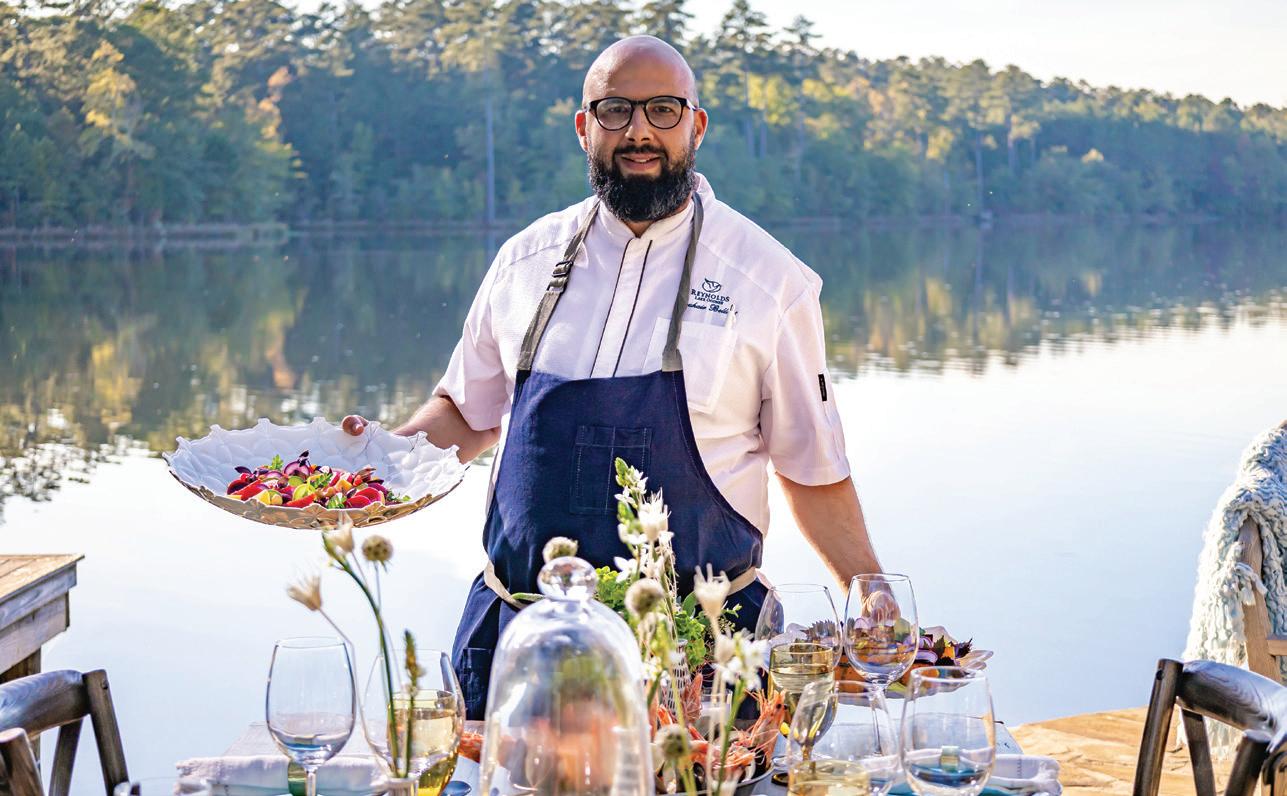
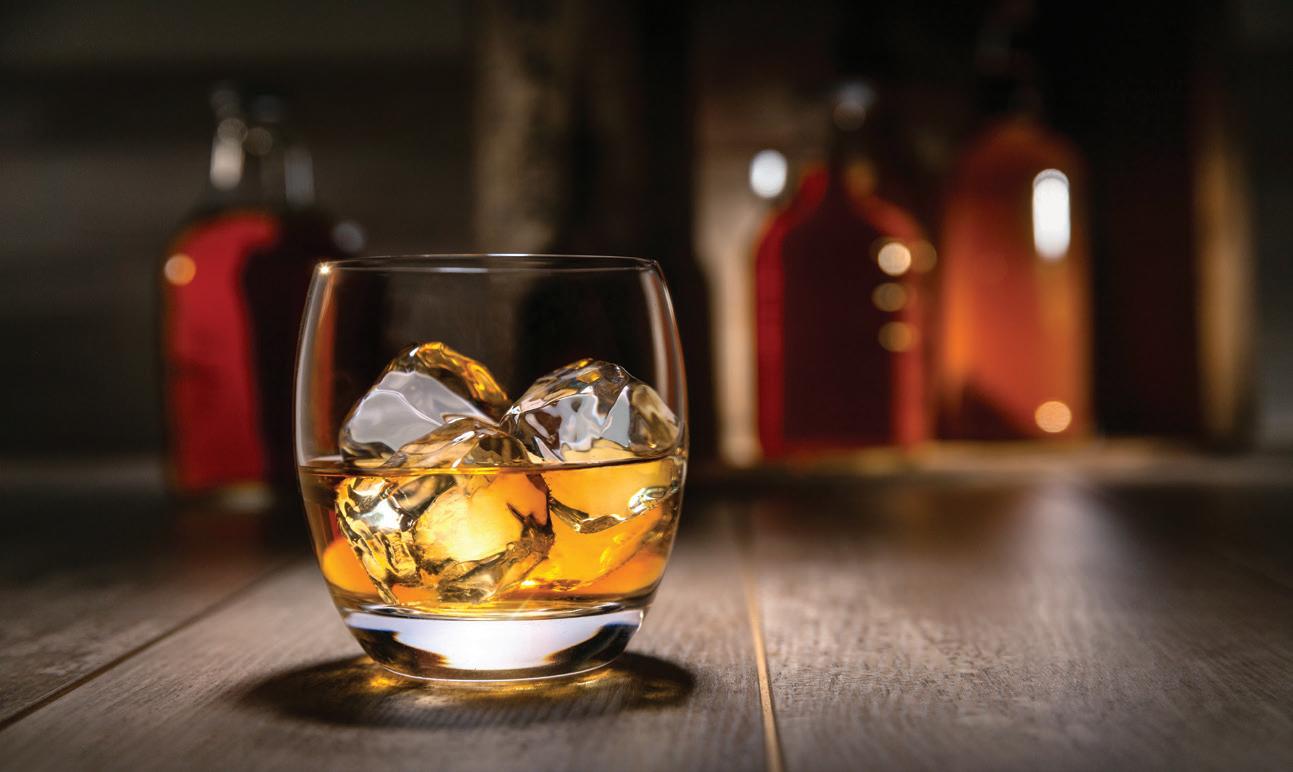

92 CONTENTS 122 A CHEF’S TAKE ON BARDSTOWN BOURBON 92 ZOUHAIR BELLOUT EXECUTIVE CHEF AT REYNOLDS LAKE OCONEE 122 92 128 CLUBHOUSE COCKTAILS 140 TEN TOP CLUB CHEFS 40 AND UNDER 128
FROM THE EDITOR
Hello all,
I am excited to bring this edition of Golf Kitchen Magazine to life. It has been six months of collaborating with club staff all over the country who are proud of their culinary teams’ performance and eager to showcase their work.
Staffing has been the most significant issue for the private club industry in the past two years. The industry must work together as a national team to raise awareness outside of golf to bring more future culinarians to the business. I am proud to announce our Golf Kitchen Scholarship to benefit students attending the Culinary Institute of America. Our silent auction platform will go live in April, and I hope you will support our efforts.
Now let’s get to this edition!
Highlands Falls Country Club is a stunning property that sits atop the Appalachian Mountains in North Carolina. Its picturesque signature 15th hole features a waterfall at the head of the Cullasaja River. Shawn Olah, a young and accomplished executive chef, took the reins in 2021 and is looking forward to enhancing the culinary operations. Olah has a strong report with his team in and out of the kitchen and believes in giving his staff a work/life balance. It was a pleasure working with this team.
The private club sector is full of avid wine collectors who have been trying to define themselves or fit into a category for years. We took the lead, and Fernando Silva emerged. Congratulations Fernando; this is no easy achievement!
In December 2021, I was fortunate to travel to Houston, Texas, other than a layover for the first time. I was blown away by the culinary passion at The Club at Carlton Woods. From the president, membership, and staff, they are excellence all the way. Wes Tyler, the executive chef, is on a blazing trail to change the perception of the culinary side of the industry.
Rob Labritz, PGA Tour Champions, gives us his nutrition tips before, during, and after golf. I am particularly fond of Labritz as he is one of the original advocates of Golf Kitchen, whom I had met in Morocco on a media tour in 2015. Thank you, Rob and family, for being such firm believers in my vision.
Let’s talk about a Morrocan chef at Reynolds Lake Oconee, Greensboro, Georgia. I love Morocco and, for years, have wanted to feature a Moroccan chef. Enter Zouhair Bellout. I had featured the previous executive chef Derin Moore in a past issue, and even then, I could foresee the next executive chef of this vast property. Fast forward, and I am overjoyed to see his rise. Please enjoy his story and recipes. Thank you, Karen Moraghan at Hunter_PR, for making this possible.
Wes Tyler is not only a talented chef at The Club at Carlton Woods, but he is a strong writer and artisan bourbon advocate. Check out Tyler’s article about Bardstown Bourbon, an ode where he grew up. You will enjoy this chef-written piece.
Mixology is on the rise in the industry. What more can I say but enjoy these six Clubhouse Cocktails recipes from Highlands Falls, The Club at Carlton Woods, and Reynolds Lake Oconee.
We finish this edition with a celebration of chefs forty and under, whether executive chefs, sous chefs, or pastry chefs. They are the future of the industry. Let’s make this happen.
Diana DeLucia President Golf Kitchen

email: info@golfkitchen.com
Cell: 860 406 1782
Golf Kitchen Magazine 12

HIGHLANDS FALLS COUNTRY CLUB
Highlands, North Carolina

 Main Clubhouse and Hole #10
Image by Michelle Muraco
Main Clubhouse and Hole #10
Image by Michelle Muraco
Shawn Olah Executive Chef Highlands Falls Country Club
Highlands Falls Country Club situated about two miles from the quaint, elegant town of Highlands, was my first visit to North Carolina apart from layovers in Charlotte. I was blown away by the beauty of the mountains in the Fall. Working with young chef Shawn Olah was a pleasure. His story is endearing as is his love of family, cooking, and his passion for creating new culinary programs for the areas youth.
~ Diana DeLucia
GK: Tell us about your upbringing?
I grew up moving around quite frequently. We moved from Florida to Grand Junction, Colorado, Fredericksburg, Virginia and back to Florida due to my stepfather’s TV repair service business. Bouncing around schools took its toll and when my parents separated, my mother and I went back to Florida. They tried to make another attempt at being a cohesive family, so we yet again moved back to Virginia. I couldn’t find a job and all that was available was a line cook position at Taco Bell or to become a backyard mechanic. This was not for me, and I knew I had to make a change.
One day I told my mom I was going out to look for a job. What I was actually doing, was going to seek opportunities elsewhere. I slid my suitcase out my window, got into my Honda Civic and started driving back to Florida. When she called and found out that I was at the Georgia border, she wasn’t exactly happy with me! I knew from experience that there were a lot more opportunities for me in South Florida. I kept driving and I ended up staying with my grandparents.
GK: Did it take you long to find employment?
I was looking for a simple job that I could jump into, I had minimal experience. I found an advertisement in the newspaper for a position as a busboy/food runner at Royal Poinciana Golf Club. I didn’t know anything about golf clubs, but I figured I could clear tables to make
some money. I was very fortunate as I was able to form a friendship with the Executive Chef John Giebels. Chef Giebels had been at the club for 25 years, but six months after I joined the team he retired. The club brought in Chef Manfred Brauer from the Bellagio in Las Vegas to take the executive chef position. We hit it off immediately and he recommended that I should move from the front of the house to work with him in the kitchen. Beginning the following day, I was to be trained as a professional chef and paid $3/hour more than I was at that time. As a teenager that was a large jump in wages, I obviously agreed!
After some training, I became his executive banquet chef and remained in that position for just under five years. During one of the off-seasons, I took a summer position in New Hampshire at an Emerald Distinguished Club called Bald Peak Colony Club. I went there as an executive banquet chef for a season and when I came back, I decided to move to The Ritz-Carlton in Naples, Florida. This was with the guidance from Manfred as the sous chef was not going to be leaving any time soon and I still had a couple of career stages to go through. His recommendation was that I could stay at Royal Poinciana but that it was not best for my future development. It would be good for me to move on and learn from another chef to continue my education.
I took a position at the Ritz-Carlton working under Executive Chef Derin Moore, CMC. I worked in the main hotel in various outlets, did some private functions at Tiburon, as well as private off-property events. I was even fortunate enough to work the famous Naples Winter Wine Festival, operating one of the dining services. I grew tired of the hotel lifestyle, and I moved on to The Club Pelican Bay, another beautiful property in Naples.
I stayed at Pelican Bay for five years as the sous chef/restaurant chef. I then received a call from Patrick McDonald, who was formerly the
HIDDEN TALENT ATOP THE APPALACHIAN
Golf Kitchen Magazine 16
A
MOUNTAINS

assistant general manager at Royal Poinciana. Patrick was a great mentor for me on all aspects of the business. I was gaining the opportunity to work with him again!
Patrick took over a tennis and swim club named The Town Club in Milwaukee, Wisconsin. Lucky me, he needed a chef! I was 27 and my goal was to be an executive chef at the age of 35. I thought my goal was a bit premature, as I was training under chefs in their 50s. Regardless, with Patrick’s support, I jumped into my first executive chef role eight years earlier than my goal. I stayed there for three years, when an opportunity to operate a larger golf club with two clubhouses presented itself.
My move to Wisconsin from South Florida became a life changing experience, one which I was not expecting. A few short months after taking my role with The Town Club, I was rushed into emergency surgery, as my appendix had ruptured some-time during my work-day. It was during the short recovery I was mandated to take, that I met my now wife, Amber. In hindsight, maybe things do truly line up as they’re meant to.
GK: Where did you head to after Milwaukee?
When I was 30, I secured the executive chef role at Green Bay Country Club, in Green Bay, Wisconsin. This role offered me the opportunity to oversee two separate clubhouses, about a mile apart. I had a sous chef and culinary team at both locations. This gave me the opportunity to solidify my abilities running two full operations. I was there for about 18 months, when my wife and I decided to leave after our son was born. We realized once we had an infant, subzero temperatures were no longer desirable for up to seven months a year.
Patrick Delozier with GGA Partners presented me the opportunity to work at Highlands Falls Country Club in Highlands, North Carolina. It was a real draw as I would be working just over half a year, and I could be a present father to my young son. Living in Virginia as a teenager, I knew the Carolinas would be a great place for us to raise our family. It offered the rural, small town feel with several major cities just a short drive away. Most importantly, was the obvious still ingrained nature of good old-fashioned Southern hospitality.
We sold our home in Florida in the midst of Covid-19, when the housing prices skyrocketed and relocated to North Carolina. Initially, the club assisted us in securing a rental property
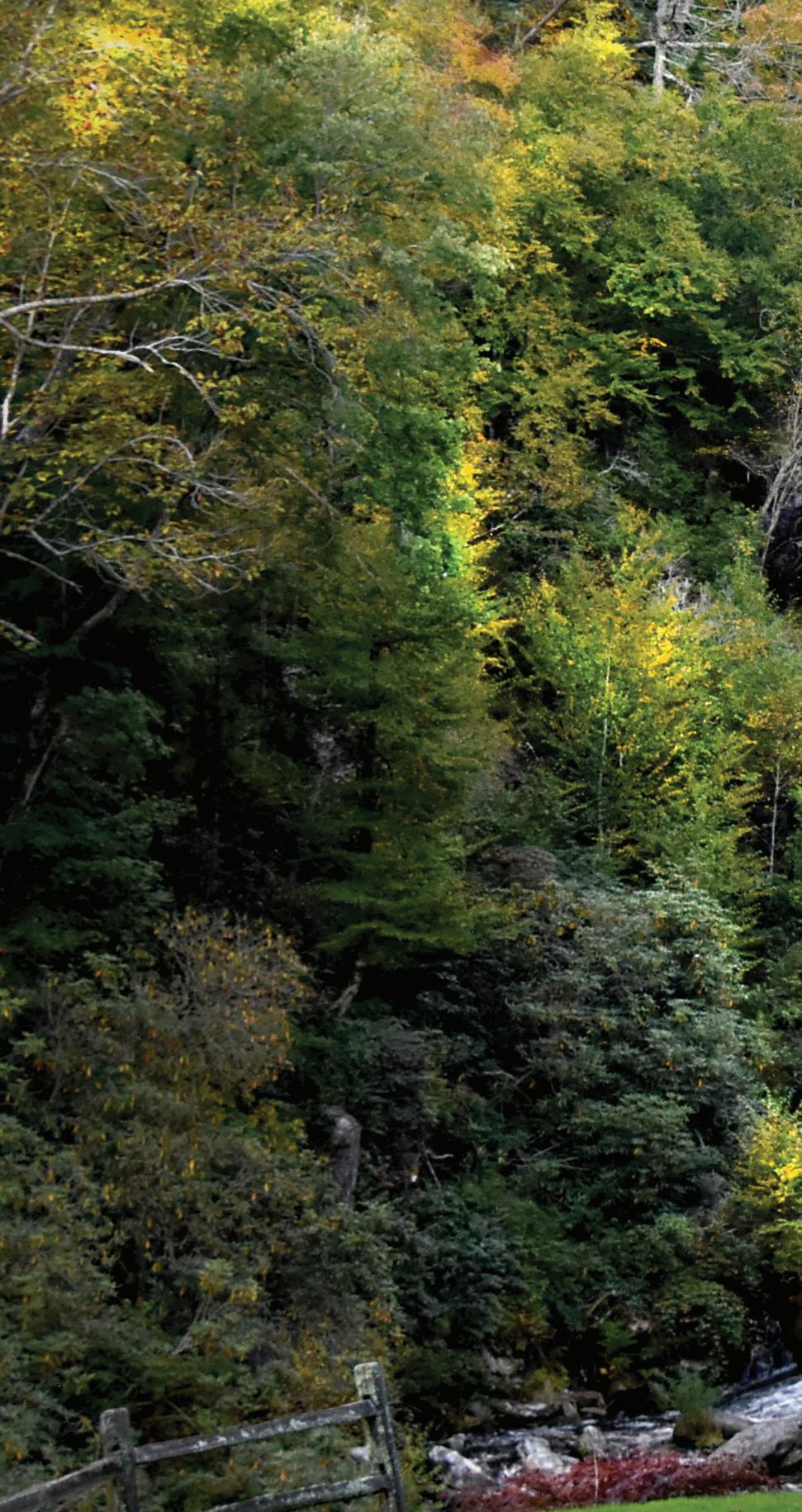
Golf Kitchen Magazine 18

Highlands Falls Country Club 19
Signature Hole #15’s Waterfall is the head of the Cullasaja River.
Image by Victoria Thomas
until we were able to find a home to purchase. We ended up finding a home just outside of Highlands, that we felt better fit our lifestyle.
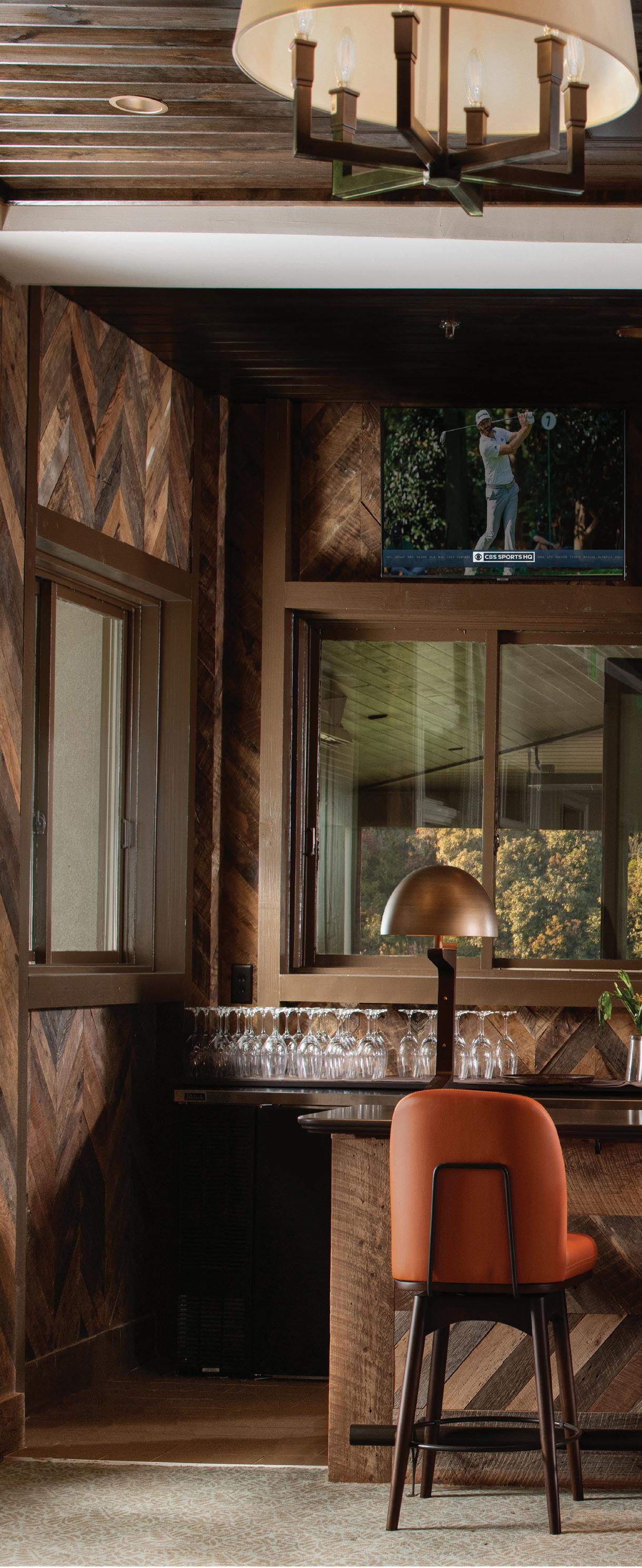
Highlands Falls Country Club had been completely remodeled, and for me it was like coming to a brand-new property. I was really impressed by the membership and General Manager Jason Macaulay. They had the willingness to make some big changes in the dining operations and gave me free reign.
Although the club had been remodeled in 2020, it was closed for the off season. The club reopened in May 2021 to a friendly membership that was eager to socialize.
GK: That must have made it better for you as a chef as they’re not expecting to return to the old Highlands Falls.
The membership was aware that there was an executive search taking place for a new chef. I had been invited to the club, along with other chefs to do tastings for the executive chef position. The tasting panel included board members, house committee members, and long-term members. They were very selective on who would be involved with each chef’s tasting, to my understanding. To reopen the club, it was much easier with a closed operation. With a new face in the kitchen, we knew the membership would return anticipating fresh flavors and menu offerings.
GK: The club had been closed for a long time, how and where did you source products for your tasting?
When I arrived in Highlands Falls the club was not operational. There were no deliveries, coolers were empty. I had to find and travel store to store, in a semi-rural area with bad cell reception to find food products. I had to
Golf Kitchen Magazine 20
“ With a new face in the kitchen, we knew the membership would return anticipating fresh flavors and menu offerings.”

Highlands Falls Country Club 21
Rustic charm meets modern flair at the Club's indoor-outdoor bar.
Image by Traci Rhoads Interiors, LLC
somewhat develop my menu around what I could find on the shelves, which was nerve-racking considering the cuisine I aim to serve during tastings. I developed my menu in the grocery store! I thought it was the best plan of attack for the situation, which came to work out well.
GK: So, the whole town knows who you are already, (laughs) in the grocery department that is?
The produce department particularly. Someone finally asked if I needed assistance. I believe they thought I was confused, circling the store with an empty cart making notes with pen and paper over and over. What better way to make a lasting impression in a small town?
GK: I see that you have one of the largest croquet clubs in America here. Do you take care of them as well?
Our culinary program services all areas of the club, including private in-home events. We host multiple croquet tournaments throughout the year, with teams from all over the country. We received rave reviews from members and guests last year, with plans to continue expanding our dining offerings in 2022.
GK: Have the members given you a lot of feedback thus far?
Yes, almost all of the feedback is positive! Of course, like any other dining operation, we always have requests for previous favorites or dietary/special requests. It’s a beautiful thing when you know what quality the membership expects, without much variance by member group. I have been a part of operations where committees control menus for dining services, which makes a chef’s duties more difficult. Here, I have several members that remember me from much earlier in my career in Naples, Florida. Knowing the level of service they expect, makes it easier to provide!
I’m going to continue to grow and see where evolution takes us. I think that the best I can do as a chef is to be myself, continue to grow and develop, and continue to put myself out there.
GK: How did you come up with the dishes that you presented for this story? What were your inspirations?
They are inspired from dishes that I have created in the à la carte dining menus. I have
a strong belief in “simple food done well” being the forefront of what I do. Although we encompass all traditional and modern flavors and techniques, I find it very important to put the same energy and dedication in-to all culinary items, especially the simple things.
GK: You mentioned you are not a big pastry fan, but your pastries are immaculate.
Thank you! I’ve learned many flavor profiles and techniques along the way. When I was at the Ritz-Carlton, I would clock out and enter the pastry room and just be a fly on the wall and if I was lucky, I could assist! I wanted to learn, and it was obvious, which was generally the biggest hurdle, getting a chef to allow me in their area.
Overall, in my career I have worked with chefs,
bakers and pastry chefs from international destinations and backgrounds. I learned about breads, pretzels, and more working with a great German baker at Royal Poinciana. I was even fortunate enough to be a semi-regular at Norman Love’s Confections, way back in early 2000’s while he was working on some developments for Godiva. Many of the other pastry items I do are self-taught or self-developed, utilizing the basic constructs of traditional baking.
Golf Kitchen Magazine
22
“Like everyone in the industry, staffing has presented challenges. This year we are taking a proactive approach in not only finding staff, but we have assumed an almost “focus group” on how to retain employees and key staff. ”
GK: How are you managing the staff shortages during these crazy times?
Like everyone in the industry, staffing has presented challenges. This year we are taking a proactive approach in not only finding staff, but we have assumed an almost “focus group” on how to retain employees and key staff. In my department, I have moved the souschef and pastry chef roles to annually compensated positions, even though we are only operational from May to October. We have immediately drawn the interest of talented young professionals with families, because of the quality of life we offer.
GK: What interesting programs are you planning for your staff, such as off-season educational programs , trips to The Chef’s Garden and regional farms?
Covid has presented many challenges in the field of continuing education for the hospitality industry. Many options are just now beginning to reopen with a physical location, rather than all online based platforms. In the mountains of North Carolina, we are fortunate to have a wide diversity of different farming practices right here at home. We live in the only rainforest within the continental U.S. We are fortunate to have many specialty farms in the area. One of my favorite hidden gems is the Wagyu beef producers, Providence Farmstead. Once travel restrictions have lightened, I have plans to reach out to The Chef’s Garden and organize a trip for some of my best to visit The Culinary Vegetable Institute of America, as well as other famous properties. It’s important to keep and grow the interest of the next generation of culinary professionals.
GK: Tell us about the beehives on the property.
The Apiary was in place when I arrived and is maintained by our superintendent Fred Gehrisch, CGCS and his team. I’ve tried to utilize the benefits of his program more and more in our cuisine at the club. The desserts presented in this story both use our honey in different applications. We also sell the honey in our golf shop to members throughout the late spring, fall, and winter. He only does one large harvest a year but it’s something I’d like to get more involved with for my own education. We are incredibly fortunate to have a professional superintendent who utilizes all complete organics throughout our golf course and outdoor areas. Mr. Gehrisch even goes as far as
having our lakes and streams on the property tested regularly, to ensure that the trout he stocks our lakes with annually are safe for those to eat, if they can catch them!
GK: What are your plans for Highland Falls this year?
I think we are going to continue to grow and expand. Last year we put in a bar menu since during the renovation, they expanded the bar, adding indoor-outdoor seating. I knew that the bar was naturally going to be a hub for social interaction. With great success, we are planning on adding in some gastropub themed nights for upscale small plates and diverse offerings, to continue growth of our bar concept.
I am looking forward to the season-opening! We have multiple member weddings, and The National Croquet Tournament in May. I’d like to get involved with the Taste of Highlands either this year or next if we can. I believe that the more opportunities we have within both the club world and Highlands Community, the more we should continue to get involved. I’ve worked in some fantastic properties in my career, and Highlands Falls is a hidden gem that’s sure to shine in the spotlight.
We’re discussing remodeling the kitchen next year to allow me some of those necessary improvements, primarily space to continue to grow and accommodate more of the areas on the property. Our demand for more options, more diverse offerings in more diverse settings has grown significantly in the first year. I believe this trend and growth rate at the club will be consistent for years to come.
I’d like to collaborate more with the local chefs this year. Our mountains are filled with all these great clubs and luxury developments with limited educational opportunities without distant travel. I’d like to develop long-term monthly meetings for chefs and develop other opportunities with the ACF (American Culinary Federation) in mind, much like I’m used to in South Florida. I plan on staying a while as it’s a beautiful area, a fantastic club and an even better membership.
Highlands Falls Country Club 23
RECIPE BY SHAWN OLAH
SWEET CORN BISQUE WITH BUTTER POACHED MAINE LOBSTER
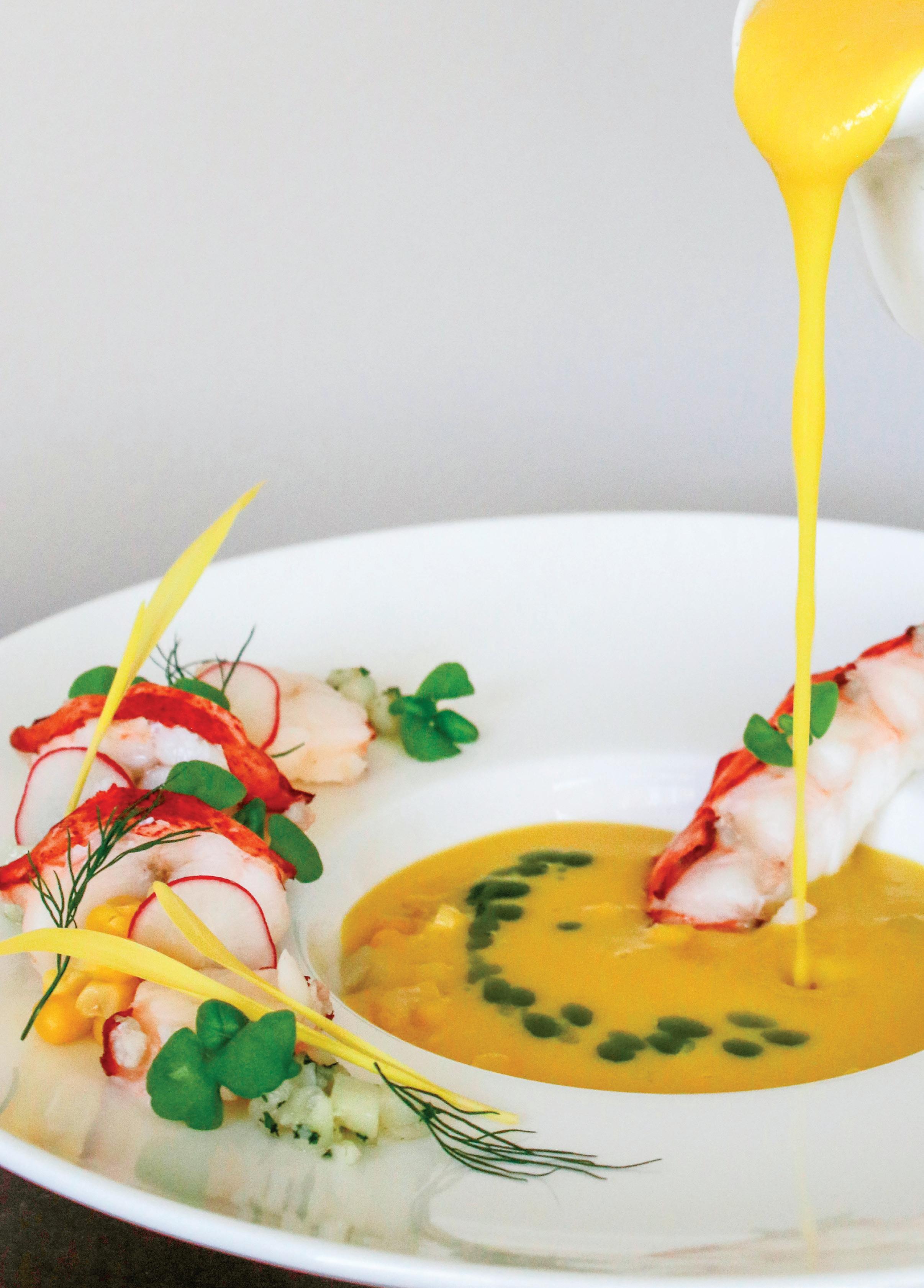
Yields: 4 portions
Ingredients
Sweet Corn Bisque
• 4 ounces Clarified Butter
• 8 cobs of Sweet Corn (kernels removed/reserve ½ 1/2 cup corn kernels)
• 2 Yellow Onions (diced)
• 1 medium Celery Stalk (diced)
• 1 Leek (chopped with top and base of leek removed)
• 3 Garlic Cloves (chopped)
• 1 1/2 cups Chardonnay
• 1/2 cup Cream Sherry
• 1/4 cup Basmati Rice
• 1/4 cup Granulated Sugar
• 2 cups Water
• 2 cups Chicken or Vegetable Stock
• 1 cup Heavy Cream – 40% Butterfat
• 1 pinch Red Pepper Flakes
• 1 Bay Leaf
• 2 Fresh Thyme Sprigs (remove from stem and chop)
• Salt and White Pepper (to taste)
Butter Poached Lobster

• Two 8 ounce Maine Lobster Tails
• Four 6” Wooden Skewers
• Beurre Monte (See recipe)
Beurre Monte
• 2 Tablespoons Water
• 1 pound Cold Unsalted Butter (cut into cubes)
Yukon Gold Potatoes
• 2 Large Potatoes
• Kosher Salt
• Parsley (chopped)
• Unsalted Butter
• Salt and Pepper (to taste)
Garnish
• Shaved Baby Radish
• Micro-Basil (The Chef’s Garden)
• Popcorn Shoots (The Chef’s Garden)
• Chervil Oil
• Butter Sauteed Corn
• Fennel Frond
Preparation
Sweet Corn Bisque
On medium heat, begin to sweat the onions, leeks, garlic, and celery in clarified butter using a medium soup pot. Sauté until the onions are tender and translucent, about 5 minutes. Add sugar, stirring to avoid clumping. Once the sugar is melted, add in the thyme, bay leaf, and red pepper flakes.
Highlands Falls Country Club 25
Pour in the basmati rice, mixing for 1-3 minutes to evenly coat and heat the rice grains. Once heated, add the Chardonnay and stir consistently to ensure the rice does not stick to the pot. Allow the rice to absorb about half of the wine. Continue by adding the corn, water, and stock, then lower the heat to a light simmer for about 30 minutes or until the rice and corn kernels are tender. Pour in the heavy cream and reduce for about 5-8 minutes. Once reduced, remove soup from heat. Blend the soup in a blender until smooth and place in the soup pot to season and reheat. With the heat on low, season the soup with salt and white pepper as needed.
Beurre Monte
Over medium heat, bring the water to a simmer in a small saucepot. Add in the cubed butter slowly, continuously mixing with a whisk. Once the butter is completely melted, bring the butter to a temperature of 155°F-160°F and hold.
Butter Poached Maine Lobster
Using scissors, carefully cut the underside of the lobster shell and pull the shell open to expose the lobster meat. Carefully remove the meat from the shell, breaking the shell away as needed to avoid tearing the flesh. Placing the base of your hand on top of the lobster tail, push a skewer lengthwise through each side of the lobster tail to keep it straight during cooking. Place the lobster tail in the beurre monte for about 8 minutes or until the temperature of the lobster reaches 140°F. Gently remove the skewers and slice the lobster tail for plating.
Yukon Gold Potatoes
Peel and brunoise the two potatoes. Lightly blanch for about 30 seconds in salted simmering water and cool in an ice bath. Strain and allow potatoes to drain. Lightly sauté the potatoes in butter with salt, pepper, and chopped parsley before plating.
Assembly
Using a small spoon, place a spoonful of each sauteed corn and diced Yukon potatoes in the bottom of your serving bowl. Next, slice the lobster tail in half, leaving half of the tail whole and slicing the other half into medallions. Place the remaining full piece of the tail protruding from the base of the bowl, upwards towards the rim. Lay the warm lobster medallions on the rim of the bowl, opposite side of the larger piece, leaving space to fill between with other ingredients. Chef Note: I also chop or dice any lobster meat from trimming and slicing the lobster, placing it in the bowl with the corn and potatoes. Alternate the warm corn and potatoes in between the lobster medallions, placing the ingredients with intention and keeping them neat. Garnish the ingredient layout with shaved
radish, popcorn shoots, fennel fronds and micro-basil. Using a petite soup pitcher, slowly pour the soup over the ingredients in the base of the bowl. Lightly drizzle chervil oil over the soup just before serving.
Wine Match
Failla Chardonnay 2018, Sonoma Coast
This gem of a wine is made in a Burgundian style, using native yeast for primary fermentation and the wine naturally completes malolactic fermentation. This wine is deeply textural and elegant, with complexity. It has aromas of lemon peel, honeysuckle and a touch of spice and pairs very well with the Sweet Corn Bisque.
~ Jason Macaulay , General Manager/COO
Golf Kitchen Magazine 26
 Clubhouse deck overlooking trout-stocked ponds on hole #10
Image by Traci Rhoads Interiors, LLC
Clubhouse deck overlooking trout-stocked ponds on hole #10
Image by Traci Rhoads Interiors, LLC

Golf Kitchen Magazine 28
RECIPE BY SHAWN OLAH
SPICE MAPLE LEAF FARM DUCK BREAST WITH PETITE CONFIT BEGGARS PURSE, NORTHERN BEANS, ROASTED SQUASH AND GRIOTTE CHERRY REDUCTION
Yield: 2 portions
Ingredients
Duck
• 1 Maple Leaf Farms Duck Breast

• 2 teaspoon Five Spice Powder
• 1 teaspoon Sea Salt
• 1 Thyme Sprig (fresh picked)
• 1 clove Garlic (peeled)
• 1 Tablespoon Whole Butter
Northern Beans
• 1 cup Dried Beans
• Cold Water
• 2 teaspoon Olive Oil
• 1 clove Garlic
• 3 cups Chicken Stock
• 2 Thyme Sprigs (fresh picked)
• Chopped Parsley (fresh picked)
• 1 Bay Leaf
• Sea Salt
Highlands Falls Country Club 29
Butternut Squash
• 1 cup Butternut Squash (medium diced)
• 2 Tablespoons Olive Oil
• 1 teaspoon Garlic (peeled and chopped)
• 1 Shallot (diced)
• Pinch of Ground Black Pepper
Griotte Cherry and Duck Confit Beggars Purse
• 1 cup Duck Confit (cooked and pulled from the bone)
• 1 Tablespoon Griotte Cherries (chopped)
• 1 teaspoon Duck Fat (lightly warmed)
• Clarified Butter
• 3 Leek Strings (blanched)
• 2 sheets Feuille de Brieck
Griotte Cherry Reduction
• 1 Shallot (julienned)
• 1 clove Garlic (peeled)
• 2 Thyme Sprigs (fresh picked)
• 1 Rosemary Sprig (fresh picked)
• 1 Bay Leaf
• 4 Whole Black Peppercorns
• 1/2 cup Sugar
• 1/4 cup Sherry Vinegar
• 1 cup Demi-Glace
• 1/2 cup Griotte Cherry liquid (from jar)
• 10 Whole Griotte Cherries
• 2 teaspoons Duck Fat (rendered)
White Asparagus
• 6 White Asparagus Stalks
• 1 cup Milk
• 1 cup Water
• 1/2 cup Sugar
• 1 Tablespoon Salt
• Ice Bath
Garnish
• Whole Griotte Cherries
• Sage Leaves (fried)
• Beet Blush (The Chef’s Garden)
• Maldon Sea Salt
Preparation
Duck Trim and score the excess fat on the duck breast, careful not to score all the way through into the meat. Evenly season both sides of the breast with Five Spice, then lay on to a plastic-covered pan. Cover the pan with plastic wrap, pressing the wrap down onto the meat. Refrigerate and allow to sit overnight. When ready to cook, season the duck breast with sea salt and lay fat-side down onto a cast iron pan, over medium heat. Allow to simmer for about seven minutes or until the fat has begun to render and is taking on a golden color.
Turn over the breast and continue to cook for about 3-5 more minutes, adjusting the heat as necessary. Lightly baste the duck with garlic, thyme, and whole butter. Remove duck from pan and place on resting rack, allow to rest 6-8 minutes before slicing.
Northern Beans
Cover dried beans with cold water, refrigerate overnight. The next day, drain the beans and place them in a pressure cooker. Add chicken stock, whole garlic clove, thyme sprigs, bayleaf, and sea salt to the pot and secure lid tightly. Cook beans for 25-35 minutes, or until beans have reached the desired texture. Once cooked, remove beans with a perforated spoon and place in a separate bowl. Lightly toss beans with chopped parsley, a drizzle of olive oil, and a sprinkle of sea salt, before plating.
Butternut Squash
Preheat oven to 325°F, convection oven preferred. Combine all ingredients in a mixing bowl, mix until squash is evenly coated with all ingredients. Pour contents of the bowl onto an oven-safe baking sheet, bake in the oven for about 12-15 minutes or until squash is tender with roasted edges. Remove from oven and place on a plate, scatter over the white beans.
Griotte Cherry & Duck Confit Beggars Purse
In a mixing bowl, combine the shredded duck, cherries, and lightly warmed duck fat. Mix well and season lightly with salt. On a clean cutting board, lay out one sheet of the Feuille de Brieck pastry dough. Cut the sheet into three even segments. Using a pastry brush, lightly brush the pastry sheets and place a small teaspoon of the duck mixture in the center of the triangle. Bring all three points up together, then slowly bring in the middle areas to form a purse shape. With a blanched leek string, wrap around the top of the purse twice and gently tie it closed. Lightly coat the base of a baking sheet with clarified butter before placing the duck purse to avoid sticking while cooking. Lightly brush the outsides of the purse with clarified butter. Bake for about ten minutes at 325°F, or until pastry is crisp. Lightly pick up and hold the top, using a small spatula when plating.
Griotte Cherry Reduction
In a small saucepan, saute the shallots and garlic, herbs, bay leaf, and black peppercorns utilizing the duck fat until shallots are translucent. Add sugar, allow a caramelization to begin until an amber color is reached. Deglaze with sherry vinegar, careful to avoid spitting as the vinegar and sugar are introduced. Once the sugar has broken down, reduce for about a minute. Add liquid from the cherries and reduce until the vinegar and alcohol from the cherries have found a proper balance, usually about 4-6 minutes. Add in demi-glace and reduce slowly. Stir frequently to avoid any burning or scorching of the reduction. Reduce over low heat for about 15-20 minutes, or just before the
Golf Kitchen Magazine 30
sauce has reached the point of au sec. Strain the sauce through a fine strainer, then add in whole cherries. Allow cherries to steep in sauce for about 20 minutes, then season with sea salt to taste.
White Asparagus
Trim the ends and peel the white asparagus, about 1/2 inch from the top down to the base. In a small saucepot, mix water, milk, sugar, and salt over medium heat, bringing to a simmer. Once at a simmer, blanch the white asparagus for about 4 minutes. Check for tenderness, then quickly remove from pot and rapidly cool in the ice bath. Once cooled, saute the asparagus with clarified butter, parsley, white wine, and whole butter before serving.
Assembly
Using a spoon, place a healthy line of white beans on the left side of the plate. Lightly place pieces of squash over and throughout the beans, for even flavor distribution. Place the three petite purses staggered across the left of the plate, throughout the beans. Slice the middle of the duck breast and lay on the right side of the plate. Duck breast should be well-rested, use a light towel if necessary to avoid excess moisture on the plate. Drizzle cherry reduction between the curvature of the bean mixture and slice of duck breast. Garnish the bean mixture with whole cherries, Chef’s Garden Beet Blush, and fried sage leaves. Lightly sprinkle Maldon salt on the duck breast before serving.
Wine Match
Cove Pinot Noir La Boheme 2019
The mild earth flavors of the duck breast pairs well with this Oregon Pinot Noir, due to its high natural acidity. The blackberry and hints of fresh cherry, and a silky finish complement this excellent dish.
~ Jason Macaulay, General Manager/COO

Highlands Falls Country Club 31
Elk
The dance floor of the club's main dining room.
Image by Traci Rhoads Interiors, LLC
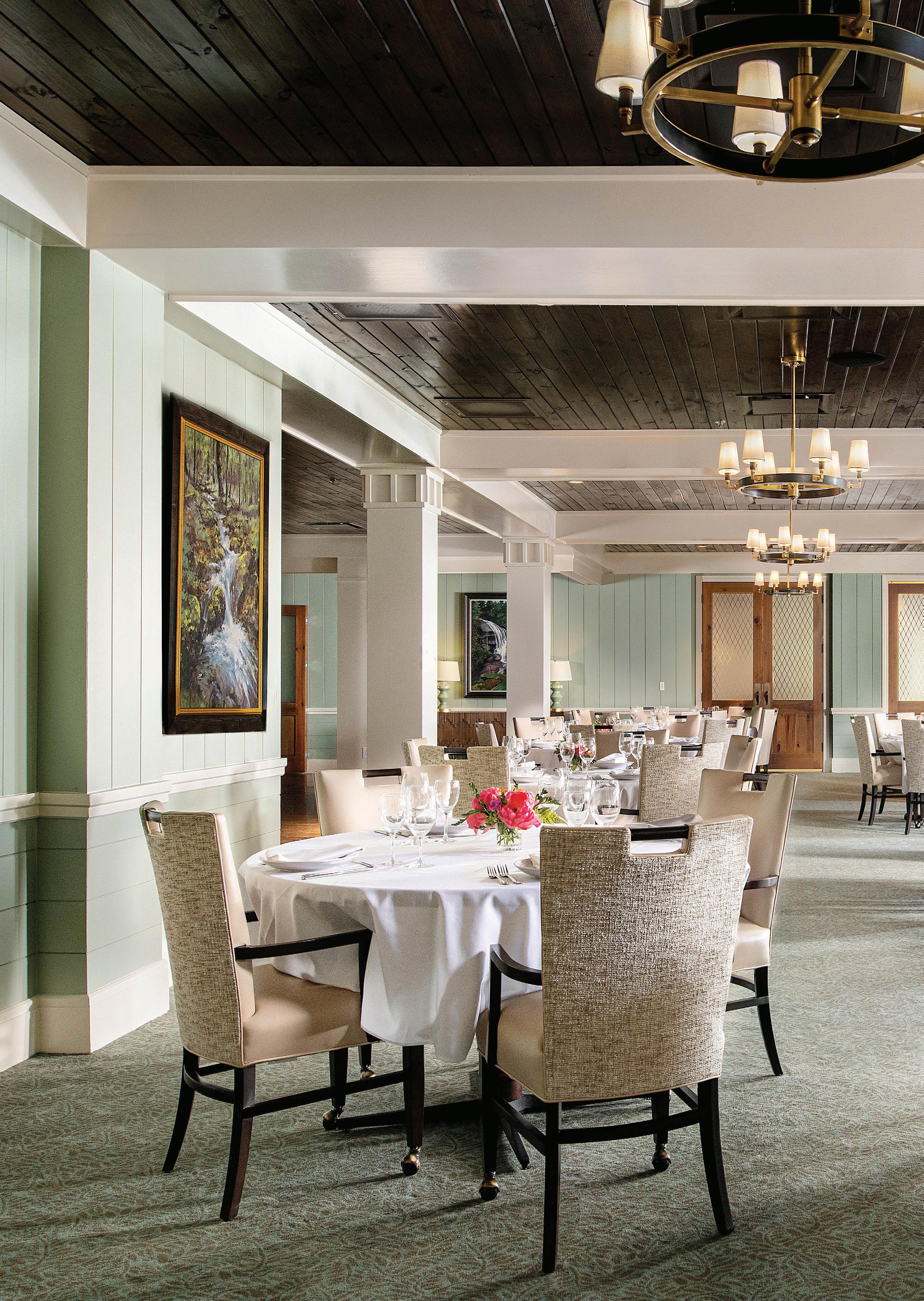

Soak in stunning mountain views from the Club's Main Dining Room.
Image by Traci Rhoads Interiors, LLC
OSTRICH WITH HONEY TOASTED FARRO AND GOLDEN RAISIN EMULSION
 RECIPE BY SHAWN OLAH
RECIPE BY SHAWN OLAH
Yield: 2 portions
Ingredients
Ostrich
• 8 ounces Ostrich (outside strip portion)

• 2 cups Hojiblanca Olive Oil
• 1 Bay Leaf
• 1 stem Rosemary (freshly picked)
• 2 stem Thyme (freshly picked)
• 6 whole Black Peppercorns
• 2 whole Garlic Cloves (smashed)
• 6 whole Coriander Seeds
• Whole Butter (Cold)
• Chopped Parsley
Farro
• 1 cup Pearled Farro
• 3 cups Chicken Stock
• 1 cup Water
• 2 stems Thyme (freshly picked)
• 1 Bay Leaf
• Local Honey
Root Vegetable Puree
• 1/2 pound Parsnips (peeled and rough cut)
• 1/2 pound Celery Root (peeled and rough cut)
• 1/2 pound Yukon Gold Potatoes (peeled and rough cut)
• 2 small Turnips (peeled and rough cut)
• 2 cups Heavy Cream (40% Butterfat)
• 1/4 pound Whole Unsalted Butter
• Salt
• White Pepper
• Ground Nutmeg
Golden Raisin Emulsion
• 1 cup Golden Raisins
• 1 cup Madeira Wine
• 1 Bay Leaf
• 1/2 cups Sugar
• 1/2 cup Water
• 3 ounces Grapeseed Oil
• 1 ounce Champagne Vinegar
Parmesan and Herb Squash Blossom
• 1/2 cup Boursin Cheese
• 1/4 cup Parmesan Cheese (shaved)
• 1 teaspoon Parsley (freshly picked and chopped)
• Dash of Ground Coriander
• 2 Squash Blossoms (The Chef’s Garden)
• 1 Tablespoon Breadcrumbs (fresh and ground)
Highlands Falls Country Club 35
Apple Cider Gastrique
• 8 ounces Water
• 6 ounces Sugar
• 4 ounces Brown Sugar
• 4 Honeycrisp Apples (core removed)
• 1 Bay Leaf
• 4 whole Black Peppercorns
• 2 small Shallots
• 1 clove Garlic
4 ounces Red Wine Vinegar
• 1 Cinnamon Stick
• 1 Star Anise
• 2 stem Thyme (freshly picked)
• 8 ounces Demi-Glace
• Roux
• Salt (to taste)
Garnish Squash Blossoms (The Chef’s Garden)
Nasturtium Leaves (The Chef’s Garden)
Preparation
Ostrich
Combine all of the ingredients in a container, then submerge the ostrich portion (s) and marinade in the refridgerator overnight. Chef Note: Strain off the olive oil, herbs, and peppercorns before cooking. Preheat a sauté pan on medium-high heat with a light coating of the olive oil. Season the ostrich steaks lightly with kosher salt and black pepper, giving a strong sear to the outside of the ostrich. After searing both sides of the ostrich steak, reduce heat and turn frequently for even cooking. Cook to an internal temperature of 90°F, then add three cubes of cold butter and a sprinkle of the chopped parsley. Continue basting until an internal temperature of 105°F is reached. Once cooked, remove ostrich steaks from the pan and immediately place them on a resting rack. Allow to rest for about 4-7 minutes before slicing.
Farro
Combine the chicken stock, water, thyme, and bay leaf in a medium saucepot. Bring to a boil and remove the thyme stems, then slowly pour in the farro, stirring while pouring. Simmer for about 15-20 minutes or until tender. Strain off any extra liquid, then spread the grain evenly on a pan to cool. Place in the refrigerator until fully cooled. Before assembly, sauté with whole butter and sea salt until lightly toasted and a warm “nutty” smell is noticeable. Turn off the heat and drizzle honey over the farro, tossing to ensure an even coating on the grains.
Root Vegetable Puree
Steam the potatoes and root vegetables until completely soft, about 20-30 minutes. Remove from the steamer and put through a ricer or potato masher, dropping the mix into a mixing bowl. Set mixing bowl on stand mixer with a whip attachment. Heat the heavy cream until hot (do not boil), slowly adding to the potato mixture with the
mixer on low. Add half of the cream mixture and reserve the remainder. Continue to mix, add in the butter and seasonings until smooth. Add in remaining cream to achieve the proper texture.
Golden Raisin Emulsion
Place all of the ingredients into a small saucepot and bring to a simmer. After about 8 minutes or once raisins are tender, remove from the heat and strain the remaining cooking liquid from the raisins. Discard the bay leaf, cool, and reserve the remaining cooking liquid while keeping the raisins at room temperature. After about one hour, place the bloomed raisins into a food processor with about 2 ounces of the reserved cooking liquid. Blend until completely smooth, add the champagne vinegar then begin to slowly drizzle in the grapeseed oil while the blade is running. Season lightly with salt then refrigerate until cooled. Once cold, place mixture into a disposable pastry bag or squeeze bottle for plating.
Parmesan and Herb Squash Blossom
Combine the two kinds of cheese, parsley, coriander, and breadcrumbs in a small mixing bowl. Using a spatula, fold the items until the cheese becomes soft and a paste is formed. Place the paste in a pastry bag. Clean the pistil from the inside of the squash blossom and snip the stems, making sure to remove any additional petals from the base of the flower. Carefully open the flower and insert the pastry bag, lightly squeezing the cheese mixture into the flower until it is about 60% full. Squeeze the ends of the flower closed and lightly dredge in tempura batter. Fry the squash blossom at 340°F in clean oil until a light browning begins, about 2 minutes on each side. Remove from oil and lightly season with salt.
Apple Cider Gastrique
Bring water and granulated sugar to a boil, until a light amber color begins to form. Immediately add in the shallots, garlic, peppercorns, apples and thyme. Sugar will appear to “lock-up” momentarily but will loosen up as water is released from the apples and shallots. Once it begins to loosen, add the red wine vinegar and the brown sugar. Add the bay leaf, cinnamon stick, star anise, and simmer for about 5-6 minutes. Add in the demi-glace and bring to a boil. Reduce heat to a low simmer, reduce about 20%, and season with salt. Strain sauce through a fine strainer. The sauce should be mounted with 2 ounces of cold butter just before serving.
Assembly
Using a plating spoon, lay a heavy spoonful of root vegetable puree on the plate and immediately drag the spoon through and away to spread the puree. Place the honey farro on the plate next to the puree. After resting the Ostrich, slice the meat to your desired thickness. Lay the slices of Ostrich on the plate, then follow by adding small drops of the golden raisin emulsion around the plate. Using a spoon or sauce gun, sauce the plate with
Golf Kitchen Magazine
36
1-2 ounces of the apple cider gastrique. Place the squash blossoms on the plate, quickly followed by placing the nasturtium leaves.
Wine Match
2018 Domaine Monier Perreol - Saint-Joseph, Northern Rhône Valley, France
Vibrant, juicy, and delicious, shows bright purple color with extravagant aromas of violets, blackberries, and thyme. Palate is bright but loaded with dark fruits, lush and supple. ~
 Jessica Emery, Associate Sommelier, CMS 2019
Scenic hole #10 presents a challenging 150ft. vertical drop to the green. Image by Michelle Muraco
Jessica Emery, Associate Sommelier, CMS 2019
Scenic hole #10 presents a challenging 150ft. vertical drop to the green. Image by Michelle Muraco
 RECIPE BY SHAWN OLAH
RECIPE BY SHAWN OLAH
MEYER LEMON TART WITH WITH CANDIED CITRUS AND CRÈME FRAÎCHE
Yields: 4 portions
Ingredients
Tart Shell (Pâte Sucrée)
• 1 1/2 cups Flour
• 6 1/2 Tablespoons Sugar (powdered)
• 2 1/2 Tablespoons Almonds (ground)
• 1/4 teaspoon Salt
• 1 large Egg
• 7 Tablespoons Unsalted Butter
Meyer Lemon Curd
• 6 large Egg Yolks (room temperature)
• 6 large Eggs (room temperature)
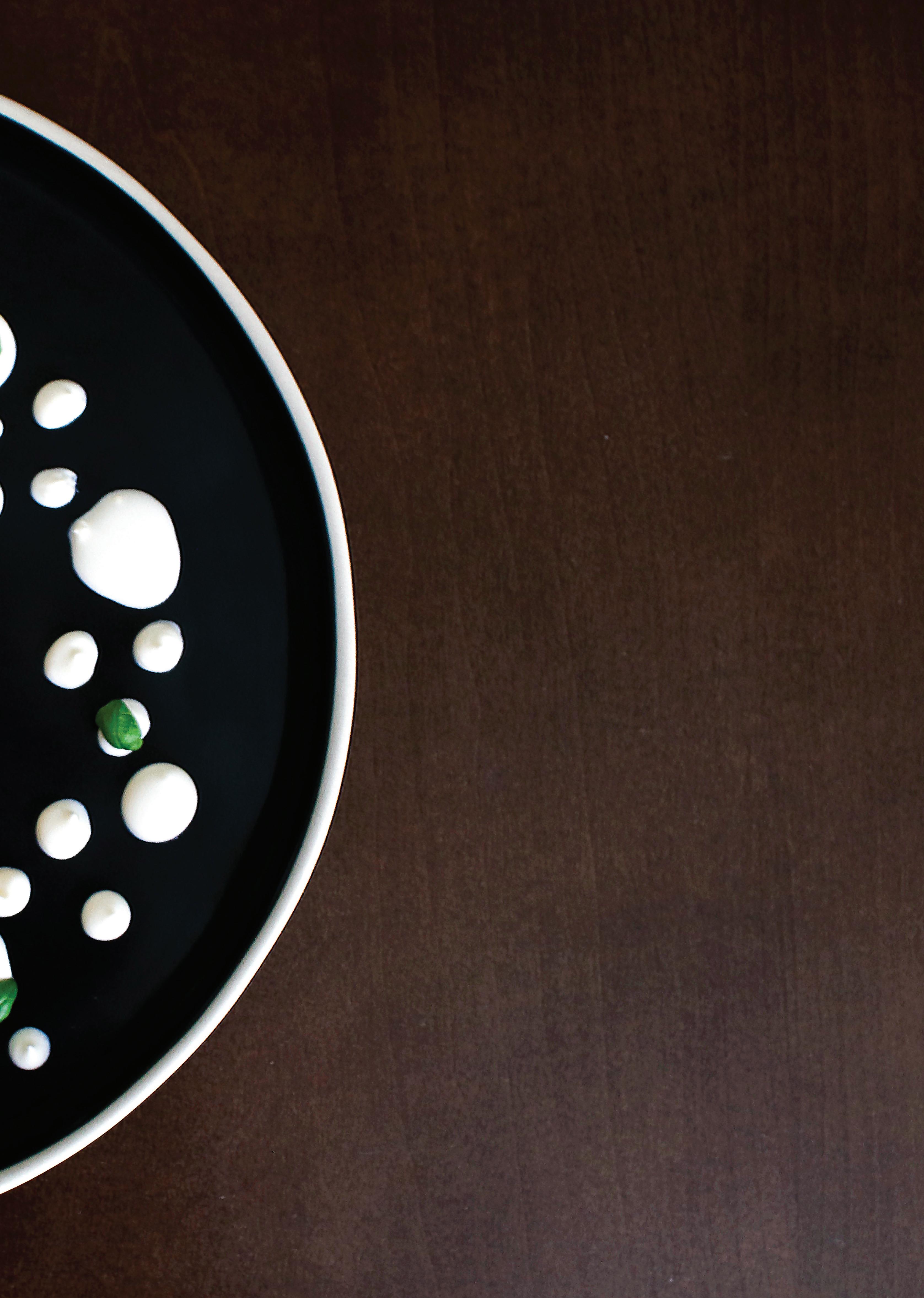
• 1 1/2 cups Sugar
• 1 cup Meyer Lemon juice (fresh squeezed)
• 2 Tablespoons Meyer Lemon Zest (micro-planed)
• 6 Tablespoons Whole Butter (cold and cut into pieces)
Honey Tuile
• 30 grams Honey (from the Apiary at Highland Falls)
• 30 grams Flour
• 30 grams Egg Whites
• 30 grams Butter (melted)
Meringue
• 5 Egg Whites
• 1/2 cup Sugar
• 1/2 teaspoon Cream of Tartar
Crème Fraîche
• 16 ounces Heavy Cream (40% butterfat)
• 1 ounce Buttermilk
Candied Citrus
• 1 Orange Citrus Zest (strips)
• 1 cup Sugar
• 1 cup Water
Garnish
• Valrhona Craquantes
• Micro-Mint (The Chef’s Garden)
• Egyptian Star Flowers (The Chef’s Garden)
• Strawberry (sliced)
• Honey Tuile (see recipe)
 Holes #14 & 16 make up the heart of the course and what's affectionately known as 'Mayhem Corner'
Image by Michelle Muraco
Holes #14 & 16 make up the heart of the course and what's affectionately known as 'Mayhem Corner'
Image by Michelle Muraco
Preparation
Tart Shell (Pâte Sucrée)
Mix the flour, sugar, salt, and ground almonds in a bowl. Add the butter using your fingertips to separate and disperse the dry ingredients evenly. Immediately add the egg and mix with a rubber spatula to form a dough. Remove the dough from the bowl, place it onto a flat surface, and then knead to bring all ingredients together. Wrap with plastic wrap and refrigerate for about 30 minutes. Remove the dough from the refrigerator and then remove the plastic wrap. Roll out to approximately 1/8 inch thick, wrap the dough around the rolling pin to place in tart tin. Lay dough evenly over the tin, pressing it in evenly with fingertips. Chef Note: Do not stretch the dough during this process; remove any extra dough with a small knife. Place a weighted item of choice in the tart shell with parchment paper. Bake the shell at 375°F for approximately 15 minutes and remove the weight from the center of the tart. Allow to cool before filling the tart shell.
Meyer Lemon Curd
Whisk the egg yolks, eggs and sugar in a metal bowl. Whisk in the lemon juice, then begin to cook over a double boiler until the mix reaches a temperature of 170°F. Strain the mixture through a fine strainer. Immediately whisk in the lemon zest and butter cubes, continue mixing until fully emulsified—cool mixture in the desired container for later use.
Honey Tuile
Mix the honey, flour, and egg whites in a food processor. Slowly incorporate the melted butter while the blade is running. Transfer to the desired mold and bake at 300°F for approximately 7-9 minutes. Chef Note: Tuile must be removed from the mold immediately; cooling will cause the tuile to become brittle and break. Reserve for later use.
Meringue
Begin mixing the egg whites and Cream of Tartar in a stand mixer on medium speed. Mix until soft peaks form, approximately 4-6 minutes. Slowly begin incorporating the sugar while the mixer runs, about a teaspoon at a time, until the sugar is gone and the mix has a shine. Continue to beat on a medium-high for up to 10 minutes, remove from the mixer and fill a pastry piping bag.
Crème Fraîche
Mix the ingredients, cover with plastic wrap and hold at room temperature for 12 hours. Once the desired thickness is obtained, lightly whip the crème fraiche and add to a plastic squeeze bottle or pastry bag.
Candied Citrus
Begin to heat the water in a sauté pan over medium heat. Once it begins to simmer, drop in the citrus zest and return the liquid to a simmer. Add the sugar in 2-3 batches,
allowing the sugar to melt between each addition. Once the sugar has dissolved, simmer for 3-4 minutes and remove from heat. Chef Note: This garnish can either be strained and separated with granulated sugar or cooled in the liquid and plated directly from the reserved syrup, used directly from the syrup in the photo.
Assembly
Fill a tart mold with lemon curd using a pastry bag with a straight tip, filling the shell about 75%. Top the tart with the meringue, using a pastry bag and a straight tip, piping the meringue slowly to obtain drops. Lightly torch the meringue to the desired color, allow it to cool for a few moments before garnishing.
Using tweezers, lay citrus zest on top of the meringue, followed by the chocolate pearls. Place the strawberry slices, then the tuile garnishes against them for the best visibility. Finish the tart by garnishing with individual Egyptian star flowers, micro-mint leaves, pulled from the stems, and lightly pushed into the meringue with angled tweezers. Design the plate with crème fraiche, using a squeeze bottle or pastry bag.
Wine Match
2014 Schug Late Harvest Reisling
This wine, if you are fortunate enough to find some, is an outstanding vintage. It is lush and well balanced, with apricot, spiced pears and high residual sugar. It pairs perfectly with this delicious Meyer Lemon Tart with candied citrus and crème fraiche.
~ Jason Macaulay, General Manager/COO
Highlands Falls Country Club 41
Cardamom and White Chocolate Bavarian

Yields: 4 portions
Ingredients
Bavarian
• 1 teaspoon Ground Cardamom (choose toasted whole seeds if preferred)
• 20 grams Gelatin Sheets
• 4 ounces Egg Yolks
• 4 ounces Sugar
• 16 ounces Whole Milk
RECIPE BY SHAWN OLAH
• 16 ounces Callebaut White Chocolate Callets
• 1 teaspoon Sea Salt
• 16 ounces Heavy Cream (40% Butterfat)
• Velvet Cocoa Butter Spray
Almond Crumble
• 2/3 cup All-Purpose Flour
• 1/3 cup Filbert Flour
• 1/4 teaspoon Nutmeg
• 1/4 cup Brown Sugar
• 8 Tablespoons Softened Butter
• 1/2 cup Sliced Almonds
• 1/2 teaspoon Salt
Whipped Blueberry “Coulis”
• 250 grams Fresh Blueberries
• 60 grams Sugar
• 2 Gelatin Sheets (Bloomed)
• 2 ounces Water
Whipped Honey
• Honey (preferably raw and natural)
Poached Pear
• 1 cup White Wine
• 1 Orange Peel
• 1 Lemon Peel
• 1 Cinnamon Stick
• 2 Bosc Pears
• 2 cups Water
• 1 Orange (juiced)
• 1 Lemon (juiced)
• 2 cups Sugar
• 1 Vanilla Bean
Honey Tuile
• 30 grams Honey (from the Apiary at Highlands Falls)
• 30 grams Flour
• 30 grams Egg Whites
• 30 grams Butter (melted)
Garnish
• Honeycomb Tuille (see recipe)

• Egyptian Starflower (The Chef’s Garden)
• Blue Borage Flower (The Chef’s Garden)
• Origins Crystallized Hibiscus (fresh)
• Raspberry Slices (fresh)
Preparation
Bavarian
Steep the cardamom in whole milk overnight. Bloom the gelatin sheets in ice water (save for later). Whip the heavy whipping cream in a mixer until soft peaks have formed (refrigerate and reserve for later). Place Callebaut white chocolate callets in a temperature-safe mixing bowl. Begin heating the whole milk and cardamom on low heat in a small saucepot, slowly bringing to a simmer. Chef Note: Do not allow the mixture to completely boil. In a second temperature-safe bowl, mix the sugar and egg yolks, then temper with the simmered milk. Continue to lightly stir the mixture (not to create air bubbles) until temperature drops to 175°F, then add in the bloomed Gelatin sheets. Immediately strain the milk mixture over the white chocolate, mixing with a silicone spatula to melt all callets evenly. Continue mixing, monitoring the temperature until the temperature reduces to 80-85°F. At 80-85°F, fold in the reserved whipped cream. Fill your desired shape silicon molds, scraping away any excess mixture with a spatula. Freeze the molds immediately. Chef Note: Bavarian must be frozen completely before being removed from
Highlands Falls Country Club 43
 The Clubhouse and updated Fitness Center over looking hole #17.
Image by Michelle Muraco
The Clubhouse and updated Fitness Center over looking hole #17.
Image by Michelle Muraco
the mold. Once completely frozen, remove from the silicone molds and stand upright on a perforated rack over a sheet pan. Keep frozen.
Almond Crumble
Add the softened butter and brown sugar to a mixing bowl. Using a paddle attachment, mix the butter and brown sugar until evenly mixed. Slowly add the nutmeg, flour, filbert flour, salt, and almonds until completely mixed. Remove from the mixing bowl and crumble onto a baking pan lined with a Silt Pat or parchment paper. Bake at 325°F with a low fan until cooked through and crumbly, about 10 minutes. Mix the crumble throughout baking to ensure even cooking may be necessary. Chef Note: Baking time may vary with different ovens, mixing the crumble throughout baking to ensure even cooking may be necessary.
Whipped Blueberry Coulis
Bloom the gelatin sheets in ice water for later use. Add the blueberries, sugar, and water to a small saucepot. With the heat on low, cook the mixture until the blueberries are broken down and the sugar is fully dissolved (about 15 minutes). Blend in a blender and strain through a fine strainer, then add the gelatin sheets. Place in a container and cool overnight. Whip the mixture in a food processor or Thermo-Mix just before plating. Place mixture in either a squeeze bottle or small-ended pastry bag for plating.
Whipped Honey
Place the honey in a food processor or Thermo-Mix until the desired consistency is achieved. Chef Note: This is best done with raw, natural honey that has not been highly processed. Honey can be spooned, placed in a squeeze bottle or piping bag for plating.
Poached Pear
With the exception of the pear, place all of the ingredients in a saucepot and bring to a boil. Chef Note: Make sure you are using a pot large enough to add the pears before your liquid is boiling. Turn the heat down 50%, peel, and add the pears to the liquid. Cook for approximately 20 minutes on low-medium heat or until the pears are cooked about halfway. Remove the pot from the heat, then weigh down the pears with a perforated strainer to keep the pears submerged. Place the pot in the refrigerator overnight, the pears will finish as the cooking liquid cools. The next day, remove pears from the cooking liquid and remove the flesh from the pear, discarding the core. Dice the pear and reserve a small amount of the cooking liquid.
Honey Tuille
Mix the honey, flour, and egg whites in a food processor. Slowly incorporate the melted butter while the blade is running. Transfer to the desired mold and
bake at 300°F for approximately 7-9 minutes. Chef Note: Tuile must be removed from the mold immediately; cooling will cause the tuile to become brittle and break. Reserve for later use.
Assembly
Using an offset spatula, gently place the three pieces of white chocolate Bavarian on the plate, equally spacing the pieces in a “half-moon” fashion. Place the almond crumble on the plate in the empty spaces between the Bavarians, as well as on both outward sides. Using a spoon, add small deposits of the diced poached pear randomly on top of the crumble, then spoon crystallized hibiscus on both ends of the half-moon. Add the whipped honey and whipped blueberry coulis, alternating between them while continuing to follow the curvature of the other ingredients. Using tweezers, gently place the raspberry slices, Egyptian starflowers, and blue borage flowers. Lightly wipe the plate to keep all crumbled items neat, then finish with the honey tuille.
Wine Match
2019 Trimbach “classic” Gewurztraminer, Alsace, France
Bright pale gold with aromas of cinnamon, nutmeg, lychee, and rose petals. Rich, intense, and luscious, but finishes drier than expected which complements the creaminess/richness in the dish.
~ Jessica Emery, Associate Sommelier, CMS 2019
Highlands Falls Country Club 45

WINE CRITIC EMERGES IN THE PRIVATE CLUB INDUSTRY
The wine and private club industry have seen a significant shift in consumers’ opinions, choices, and ways of acquiring information in the past few years. From wine gurus, wine connoisseurs to sommeliers, we now have the rise of the Wine Critic. It seems a perfectly calculated circle formed a few years back.
Let’s put things into perspective. Today, online learning and easy access to courses (Zoom tastings, etc.) brought a noticeable change in study patterns for wine aficionados, sommeliers, and wine lovers in general. Sommeliers and beverage directors in private clubs have found new creative ways of keeping their members entertained while satisfying their thirst for knowledge.
In my personal experience, the last two years brought about the transition from being a hands-on sommelier to a more reflective source of knowledge for a captive audience. During this time, I began to write wine reviews on social media platforms and soon after for several golf magazines and publications.

The private club industry has not been blind to all these movements, but as particular as it is, it has always been a unique niche where mainstream wine critics have rarely found a spot. The private club sector is full of avid wine collectors who have been trying to define themselves or fit into a category for years. Keeping in mind these private club members, this special category of wine critic emerges.
~Fernando Silva Wine Critic, Sommelier and Artist
Wine Critic Emerges
47
The Club Wine Review
A comprehensive and dynamic approach to wine reviews for the private club industry.
Presented by Fernando Silva Wine Critic, Sommelier and Artist
How we score Wines
95-100 Quintessential wine: Refined, elegant, and unique, a true expression of varietal, terroir, and winemaking skills, with great aging potential.
90-94 Formidable wine: A wine full of life ready to become a true icon.
85-89 Brilliant wine: Usually fresh, vibrant, and on its way to growth.
80-84 Great effort: Enjoyable at many levels, easy to enjoy, a party-going wine. ,

75-79 Good effort: Wines that are still developing character.
50-74 Needs improvement: Wines that require some fine work.
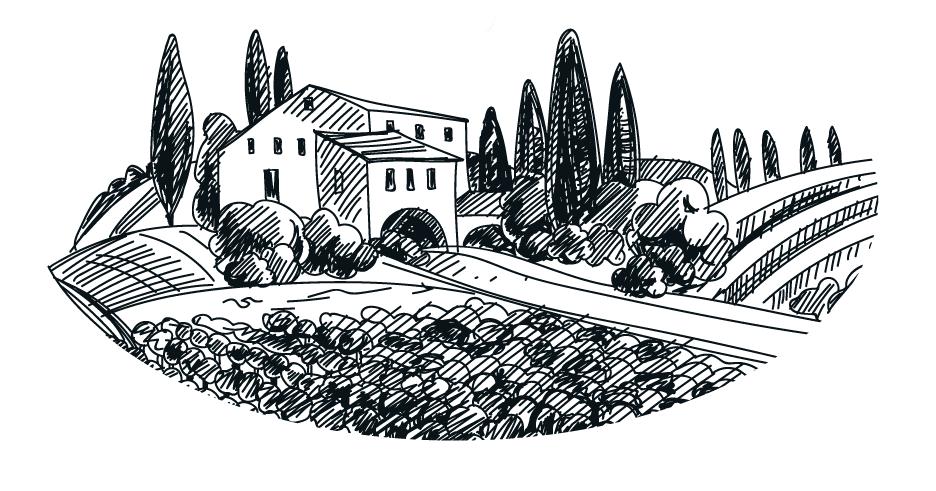
Jayson, Pahlmeyer Chardonnay, Napa Valley, California 2017
If you love Napa Valley Chardonnay, this California gem must be on your list! Jayson Chardonnay keeps you entertained till the last drop, with ripe yellow pear, on the nose, comes forward a delicate aroma of white flowers, full of citrusy lemon tart mouthfeel. There are light notes of orange peel with soft honeyed spices on the finish, excellent acidity, balance, and texture.
GK 93
Golf Kitchen Magazine 48
Vietti, Perbacco, Nebbiolo, Langhe, Italy 2018


Piedmont in Italy has a lot to offer to the avid wine lover! This Nebbiolo opens with an intense aroma of red berry, a hint of blue flowers and spice, with a dark ruby core, an authentic medium-bodied wine in the glass. There is certain complexity and elegance in Nebbiolo as it evolves during the tasting, and the tannins although evident are well integrated; with great composition and structure, Perbacco shows so much potential!
GK 89

El Enemigo, Malbec, Uco Valley, Mendoza, Argentina 2017
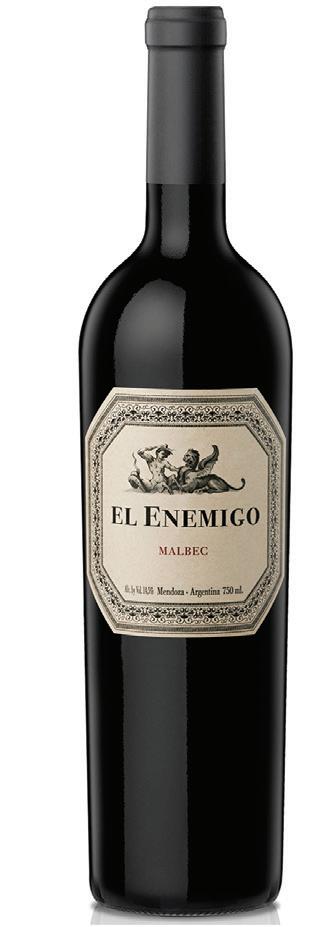
Malbec is an integral part of Argentine culture and this one. The Enemy or El Enemigo, just coming from the foothills of the Andes, is a true example of a flavorful concentrated, and rich Malbec, with intense aromas of black fruit and black cherry. Bold and inky! This is a medium to full-bodied wine, with hints of spice and lilac, aromas most noticeable in the long finish. Get ready for fun times, gratifying till the last drop!
GK 85
Laurent-Perrier, Champagne Brut Millésimé, France 2007

There is something so attractive and charming about bubbles in a glass! The prestigious House Laurent-Perrier traditionally chooses to produce Vintage Champagnes in the best years and under the best climatic conditions. Every time we encounter a brut Millésimé, the vintage is a truly unique and memorable experience!
It is a pleasure to watch its pale golden core in the glass with an excellent mousse, delicate citrus notes, dried orange peel, evolving biscuit-croissant aroma, plenty of freshness, and abundant acidity on the palate. A true classic!
GK 97
Designing Food and Wine Events that are Elevated and outside the Box Contact: email: WEI@WINEBYWEI.COM Instagram: @winebywei
L’Ecole No.41, Syrah, Seven Hills Vine- yard, Walla Walla Valley, Washington 2017

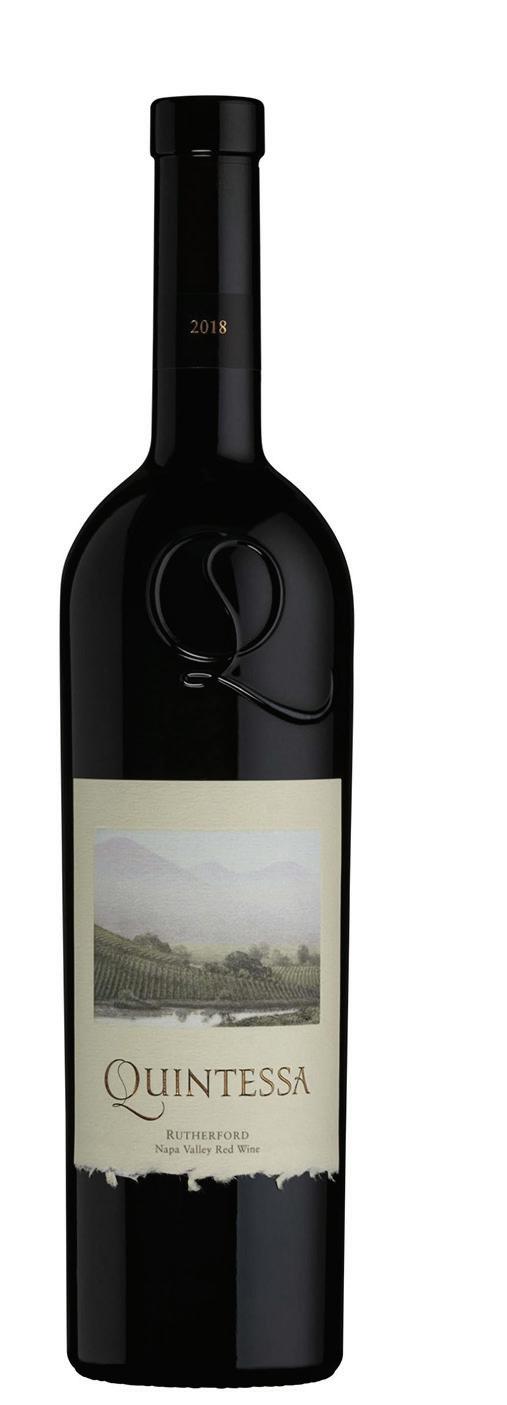
Walla Walla is coming up with some powerful and bold contenders! L’Ecole No. 41 Syrah is definitely dark red garnet in the glass, black and blue fruit dominates the palate. Superfine tannins and well-balanced, this is a very expressive “GSM”(Grenache Syrah & Mourvedre grape varieties) style of Syrah blackberries, black cherry, and a hint of black olive and baking spices. Concentrated and a bit robust with an intriguing finish that develops into bitter chocolate and coffee. This beauty deserves a good spot on your wine list!
GK 87
Domaine Leflaive, Puligny Montrachet, Cote D’Or, Burgundy France 2019
This wine is singing! It is vibrant with a bright gold center, greenish and silver highlights, aromas of white and yellow flowers; one can expect complexity from the start with hints of hazelnut, lemongrass, and honeyed green apple. A charming flint stone aroma is the most prevalent, followed by some delicate mineral notes, well balanced and in the possession of a harmonious flair, that shows in the palate with no interruptions through the long finish. Fantastic!

GK 93
Quintessa, Rutherford, Napa Valley Red Wine, California 2018
Many have written and tasted this gem from Rutherford. I find the deep red garnet and intense black fruit and cassis aromas, charming and esoteric, a red blend that shows concentration and power from the beginning till the end. On the palate aromas and flavors of black cherry, red berry, bitter chocolate, fine dusty tannins, stimulant, and refreshing acidity, long finish, there also delicate notes of menthol and herbs. There is much more complexity and evolution as we move to the finish, fantastic wine!
GK 96
My Favorite Neighbor, Cabernet Sauvignon, San Luis Obispo, California 2019
This Cabernet Sauvignon is one of my new favorites! Vibrant red garnet with hints of purple, blackcurrant, and dark fruit, blackberry, fig, and crème de cassis, opulent and rich, full-bodied, great tannic structure on the nose and fresh acidity, there are notes of fine herbs and a bit of toasted caramel on the long finish. There is so much going on in My Favorite Neighbor, you have to taste it soon!
GK 95
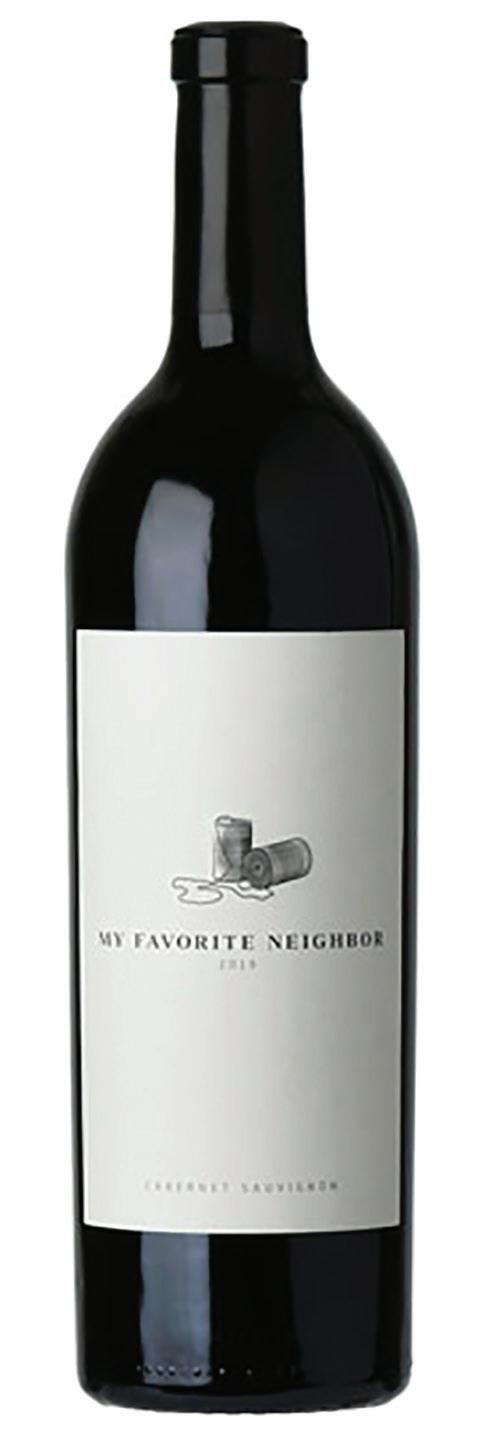
Golf Kitchen Magazine 50
This is a serious Chardonnay, day bright and a golden core, ripe stone fruit and green apple aromas, hints of baking spice, lemon and citrusy flavors come forward on the palate, great acidity, and a medium body. It has a distinctive structure and power that keeps evolving on the long finish. Terrific wine for Chardonnay lovers!

GK 91
Bodvar Rose, No. 7, Côtes de Provence, France 2020
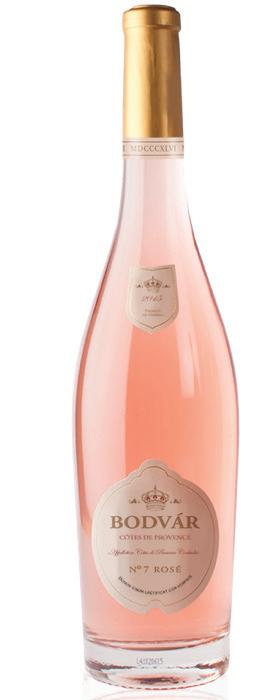
This is a fascinating Rose; it shows a pale pink hue with light copper tones. It is an enjoyable experience, fresh and elegant, with intense raspberry, and tropical fruit notes, hints of watermelon, good acidity brings forth a good amount of freshness. Bodvar comes in various shades; this time, we tasted No.7. Well-balanced, a sure summer hit!
GK 87
Wow! Montalcino is such an iconic place, Brunello is so charming to the eye, it starts with a deep dark red with hints of mahogany, very concentrated and focused, black, and red cherry, plummy and earthy, medium-bodied, charming hints of rosemary and rose petal, intense till the end.

GK 90
The Withers, Pinot Noir, English Hill, Sonoma Coast, California 2018
A great find! We found hints of mushroom and earth on the nose, exciting complexity on the palate with well-balanced acidity, and a nice medium finish that makes me want more! This Pinot Noir shines in the glass with a dark ruby red and plenty of aromas of ripe raspberry and strawberry.
GK 85
 Arista, Chardonnay, Ritchie Vineyard, Russian River Valley, California 2018
Poggio Antico, Altero, Brunello di Montalcino, Tuscany, Italy 2016
Arista, Chardonnay, Ritchie Vineyard, Russian River Valley, California 2018
Poggio Antico, Altero, Brunello di Montalcino, Tuscany, Italy 2016
The Club Wine Review 51
The Club at Carlton Woods The Woodlands, Texas


Fazio clubhouse and course Image courtesy The Club at Carlton Woods
Wes Tyler CEC, CCA, WCMC Executive Chef The Club at Carlton Woods
Wes Tyler is one of those young culinary talents that takes complete ownership of his career in all areas. His talents go way beyond being a chef. His passion for artisan bourbons, writing, and lifting his team to succeed is exemplary. He is an example of the new modern chef, making significant strides in changing the perception of the private golf and country club industry on a culinary level. ~
Diana DeLucia
GK: You are originally from Kentucky, what are some of your earlier memories?
I was born in Bardstown, Kentucky in 1987, the world’s bourbon capital. One of the strongest memories I can recall from a young age, was the warm fragrance of sour mash fermenting in the air in the early mornings and the smell of fresh corn being harvested in the fields across the county. I can still almost taste it. Retrospectively, this has become an intricate part of my life today, although I didn’t know the impact it would have on me at the time.
Both my mother and father came from farming families, and as a child I remember my grandparents did a lot of canning and preserving. Very early on, I can remember sitting on the porch snapping beans into 5 gallon buckets, shucking corn by the bushel, and puttering around in the garden with my grandfathers. As I got older I worked on the farms, in the cornfields, and hay fields developing core values and a work ethic that is only earned through legitimate blood, sweat, and tears. At the time, I didn’t realize what I was being introduced to at such a young age, however I’m thankful now as I often refer back to much of this in my career as a Chef today.
Growing up, my mom always cooked home-cooked meals, and most nights the family would sit around the dinner table and eat together. This was our time. It instilled an important routine, and a chance to connect with each other at the end of the day. I cherish these memories, and feel blessed to have been so fortunate.
GK: How did you end up at culinary school?
At 17 years old, I got my first job at a local pizza shop, delivering pizzas and learning the business as a teenager. After high school, I stayed in the restaurant industry
mostly while going to college, bouncing around from chain to chain, and making enough money to have a good time while enjoying life. After a couple of failed attempts at the university, my mom suggested I go to culinary school since I was unsure with what I wanted in a career, and seemed to be happy in the kitchen. Fortunately, I decided to make the leap into a familiar world, and discovered that I was genuinely passionate about food and everything that surrounded the hospitality industry. It was a mindless transition at first, although rigorous, and I was used to being a rebel so the early drive that was instilled in me began to shine through in the kitchen! I had to dress the part, uphold the standards, and take criticism just as I had as a young boy on the farm learning the ropes from my grandfathers. It was imperative, necessary, and paralleled the excellent foundations I had already developed coming up.
Now days, there is a stigma with culinary schools because many people come straight out of high school, graduate from culinary school, and then think they are automatically a chef. It doesn’t work like that, and I never had that mindset. Additionally, there is another side of the industry that believes that learning by working in the kitchen, transitioning through the school of “hard knocks”, and gaining experience as you work through the ranks is the only way. I embraced this very early on. Then you’ve got the select few that have been exposed to the industry, created a foundation with culinary education, and use a combined perspective to springboard a career. For me, it has been a combination of all of this that has worked well, and proven to outline a path as I progress within the industry and continue to raise the bar.
I have always enjoyed learning about other people’s perspectives, especially the younger generation. A reality check is often needed for students after leaving culinary school; it’s not like Food Network or TV shows that glorify chefs and kitchens. These shows, although enlightening, often put us in a bad spot because they make it seem like everything is beautiful and perfect all the time, and that is just not the case!
GK: What were your plans after that?
After I graduated culinary school, I was looking into
A look At A fine And young tAlent in TexAs Golf Kitchen Magazine 54
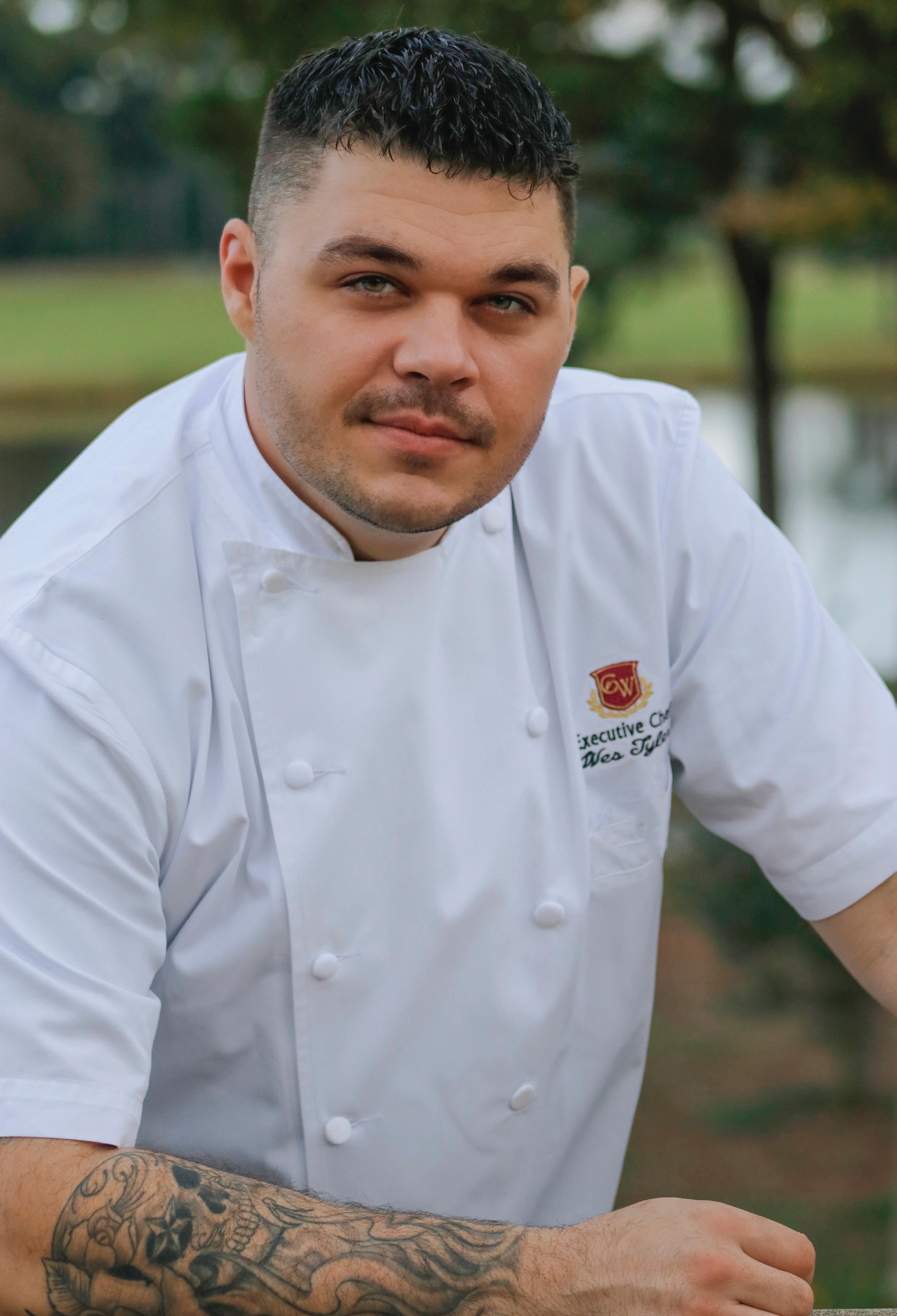
see what I could land. A chef in Texas at The Woodlands Country Club, John Stanley, called me back and gave me an opportunity. We talked on the phone, and he said, “When can you be down here?” It was a Wednesday, and I said, “I can be down there by this weekend.” It was as simple as that. I let my family know I was headed off, and that was the start of my club career as a chef.
I thought, man, this is great, this is every cook’s dream to cook for the stars. They offered me what I thought was a great salary, more money than I’d ever been offered at the time— it wasn’t long before reality set in. I was working 18-to-20-hour days. We would show up at 3:30-4:00 in the morning, load up all the equipment onto the 18-wheeler, drive it to the venues, and unload it at the stadium or wherever we were going. Cook breakfast, lunch, and dinner, load it all back up, and bring it back. We had a newborn at the time, so I only stayed for six months. It was grueling, and not what I thought it was going to be.
GK: Why were you applying to country clubs?
I didn’t even know what a country club was at the time, as I hadn’t been exposed to them. There was one in Bardstown, but it’s not like what we have here in Texas. I told my family that I had found a job and was going to Texas. I packed everything in my car and left that weekend. I lived in a hotel for three weeks and made it work until I got on my feet. I made some terrific friends, and an amazing chef there, Erik Gonzalez, took me under his wing and is my best friend to this very day. We became roommates for several years, worked together, and now he is an executive chef at Woodforest Golf Club here in Montgomery.
GK: How long were you at Woodlands Country Club and what did you do after that?
I stayed at Woodlands Country Club for nearly four years. I started as a line cook on sauté and worked my way up to sous chef. I was young and reckless, but I learned a lot. I met my wife Brooke there, and held our wedding at the club shortly after. She is still the catering director there, and is my rock in all that I do.
After getting married, I left The Woodlands Country Club to take an executive chef position at a tapas restaurant close by. I didn’t know anything about Spanish food and had never been to Spain. I got into the books, and I learned as much as I could. I learned how to run the operation, the kitchen, and the staff. It was a small restaurant; however, it had very high-volume traffic in a high-end area. I stayed for two years and then got an executive backstage catering chef position at a local catering company that serviced all the large venues in the area.
When I left there, I didn’t know what I wanted to do, but I knew I had to do something. I ended up at another country club and was there for maybe three or four weeks and realized that this wasn’t right fit for me. They’re not doing it the right way. Then, I received a call from Chef Jeffery Baker, at Houston Oaks Country Club. I talked to him on the phone. I said, “Listen, chef, this isn’t where I’m supposed to be. I’m looking for a place to continue to grow and learn.” I ended up going to work with him. I told him that I needed to learn and continue developing my skills. I was around 28 at the time. He took me under his wing as an executive sous, and immersed me in the many creative programs they were offering there. There was a giant garden, and we were growing all our own vegetables. We would go out in the middle of the day and pick stuff out of the garden to cook at night. We built an apiary and started harvesting our honey. He started canning, and that is when everything hit home and went full circle. I was doing what I was supposed to be as a chef, and touching base with my roots.
GK: How did you land at The Club at Carlton Woods?
Early on when I moved to Texas, while I was at the Woodlands Country Club, there were always whispers about this very prestigious club named Carlton Woods. So mysterious, that nobody could tell me what happened inside the gates. I always thought I’d love to work there. Years later, the sous chef opportunity came up, and I knew I had to take the chance.
When I first started here at CW, I was working the mornings at the Nicklaus Clubhouse. I was not doing much, and didn’t feel stimulated. I said, “Chef, I’m worth more than this. I’m not enjoying what I’m doing here in the mornings. I want to go to the Fazio Clubhouse so I could be more valuable to the team. He agreed, and I went to the other operation. It was there that I worked with the team, guided them, and developed menus. Later, I was promoted to executive sous chef where I learned more about the overall operations of the club, and created a platform for success as I grew and tenured. During this time, I knew that I was in the right place, and CW was where I wanted to call home.
Golf Kitchen Magazine 56
“ I rely heavily on my team and the people around me for support. I discovered early on that their success is my success ”
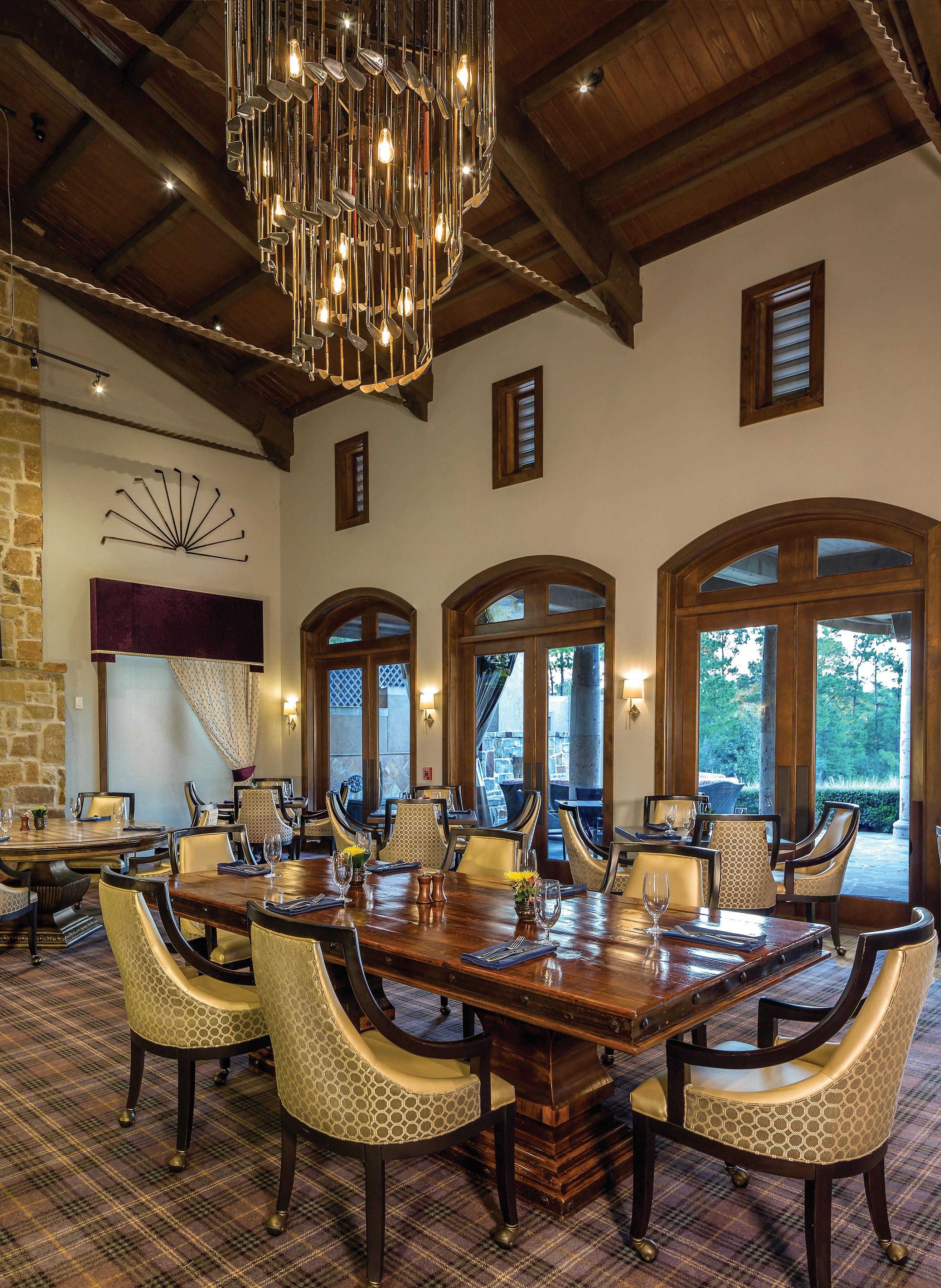
Fazio Dining Room
Image courtesy The Club at Carlton Woods
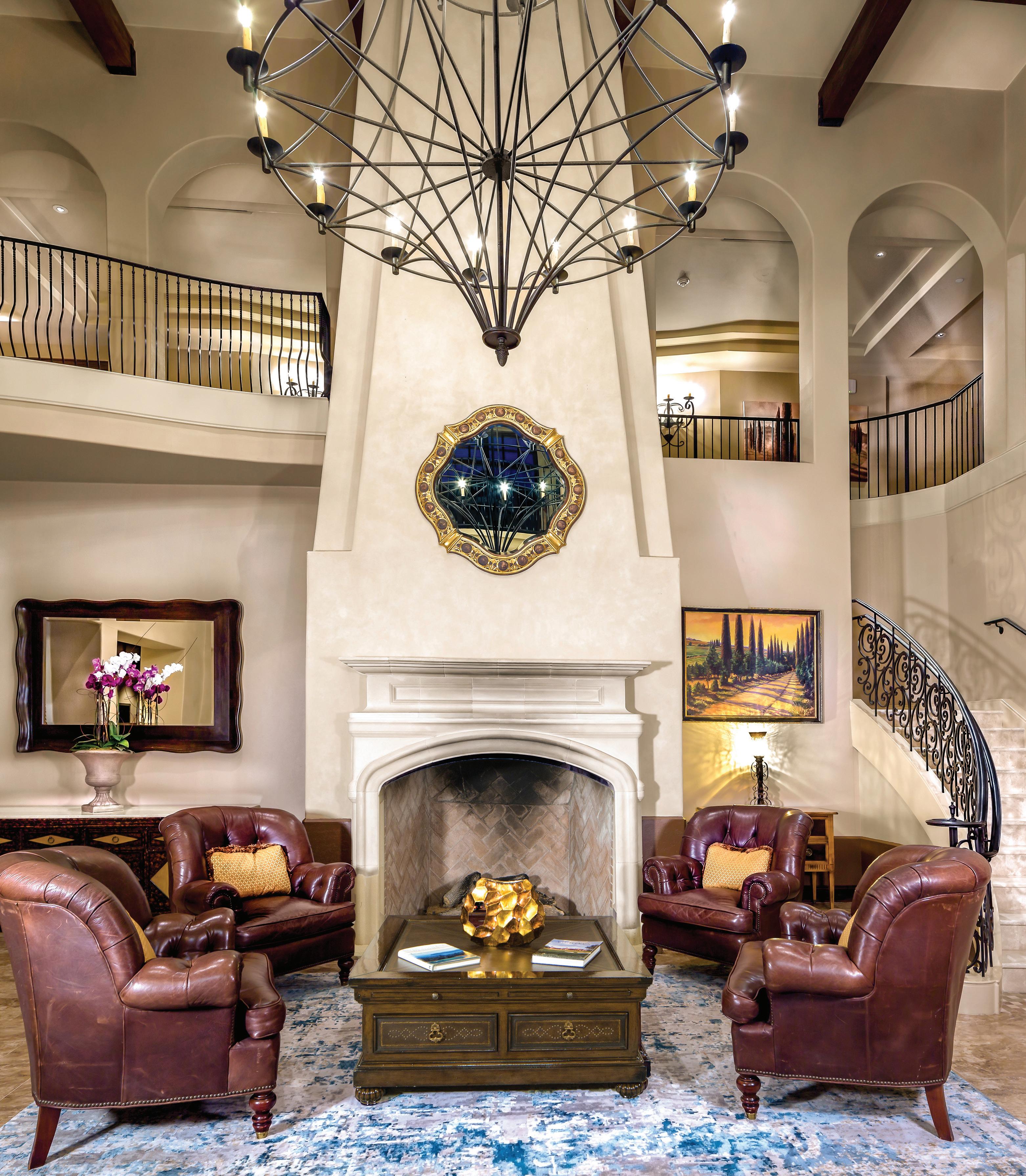 Nicklaus Clubhouse Lobby
Image courtesy The Club at Carlton Woods
Nicklaus Clubhouse Lobby
Image courtesy The Club at Carlton Woods
GK: When did you get the Executive Chef role?
I took the interim executive chef position for a few months after the first chef left. Shortly after, they hired Russell Scott, CMC. He is an excellent classical chef, an Olympian, and a highly decorated veteran in the industry. When they told me they were bringing him on, I was going through my executive chef certification processes with the ACF, continuing my progression and expanding my skillset and reach within the industry. Initially, I was disappointed that I didn’t get the role, however trusted the clubs decision and redirected my focus to refining my skillset and taking advantage of the opportunity to work under someone with such knowledge and success. This challenged me mentally. When he started, I wrote a letter to him, and I said, “I’m willing to be broken down, reset my perspective, and start from scratch in order to be successful and excel. I want to learn how to do everything the right way. I want to go by the book and see what you can teach me.” It was an opportunity few have the fortune of receiving, and I wanted to absorb as much as I could. Most importantly I remained humble, and wanted to use this time to take a look at myself and reflect on what I knew already and how I could grow with his guidance.
For me, this was another genuine turning point in my career. I took the time to focus, learn, and think about the small details. He often asked me questions that I didn’t know the answers to, even though I should have. I could frequently perform and execute tasks, but couldn’t explain, describe, or put into words what or why I was doing things or processes a certain way. He challenged me to think first and have a plan for every move I made. As a mentor, he taught me how to be a leader, and have a purpose and reason for everything that I do in the kitchen.
“It didn’t end up working out for him, and he chose to move on after a couple of years. I’m still great friends with him to this day, and frequently lean on him for support and ideas. He redirected the way that I was thinking about the precision of some of the things I was doing, maybe a little more haphazardly early on. Then when he was gone, I had to focus on dialing myself in the rest of the way, in order to be successful.
Once he left, I assumed the role of executive chef, and have grown the culinary operations to a new level. I have a true appreciation for the support and guidance he provided, and the potential he saw and cultivated in me throughout our time together. Reflecting on this, it was a necessary bridge I needed to cross in order to take my career to the greater heights, and I am grateful for the knowledge I gained during this time.
GK: You are very humble and appreciate learning from those in your life and career. Tell us about that.
I rely heavily on my team and the people around me for support. I discovered very early on that their success is my success. I learn from my sous chefs, line cooks, and kitchen staff on a daily basis. I think I continue to grow and have success because of that. I don’t claim to know it all. I don’t claim to have all the answers. If someone comes to me and I don’t know the answer, we can undoubtedly figure it out together. If one of the staff come to me with an idea they are really excited about, we work through it and see how we can incorporate that into our program. That humble approach buys back into the creativity, freedom, and support that I need to stimulate them in the kitchen. The team has to have some opportunity to be involved in the bigger picture. By providing them a platform for growth and discussion, everyone gets a return on investment. If we can all do that, then we will all be successful.
I’m the face of the operation, but I’m the first one to tell you that I can’t do it alone. It’s a collective effort from everyone. That’s another reason my Executive Sous Chef Adam Jemmott, and I have spent the last 18 months meticulously building and selecting our team. Part of the challenge throughout the hiring process was the availability and quality of the talent pool. Due to the Pandemic and the shortage of applicants, it was tempting to take anyone who walked in the door because we were so short staffed. We had to make some really tough decisions while hiring to make sure we were making the right selections. It was more important to us to take our time and put the right team in place, rather than to just bring someone on to ease the work load.
“The hope is, that we can impact the industry in such a way that it continues to support the growth and evolution for generations to come. If we can do that while carrying on the traditions and philosophies that brought us to this point, then that will be our legacy.”
a void, or were maybe even over qualified for a role because we wanted to ensure our core was solid and the people we brought on were going to mesh well with the team and elevate our operation as a whole. In the end, patience and dedication paid off for us, and now we have a really solid team. A lot of it happens naturally, and a lot of it comes with time and experience. It takes a tremendous amount of hard work, dedication, and training from a leadership standpoint, but we want to ensure that at Carlton Woods we are not just another kitchen full of cooks punching a clock. We are running a dedicated, professional, and elevated culinary team in a high end operation. We strive to set the bar for our industry peers, and exemplify the standard of excellence necessary for success in golf kitchens across the world.
GK: Tell us about the Junior Sous Chef Program.
Now that we have compiled a really solid culinary team, we are getting everyone on the same page and aligning our core goals. These secondary programs, such as the Junior Sous Chef program, are designed to highlight an internal growth and promotional opportunity within the department. This program specifically, outlines a detailed path to the sous chef role focusing on supervisory growth and experiential development over a set amount of time. In addition to this, there are leadership goals and advanced techniques that must be demonstrated to complete each section of the program in order to move on to the next step. Each goal has an incentive or compensation increase attached to it, providing tangible results beyond the knowledge and career growth that comes with the program inherently.
As a leader, I want my team to have the confidence that if they buy into our movement and direction as a culinary operation, then we are excited to re-invest in their careers and support their growth as culinarians. This is a beneficial approach for both sides, as we are able to support the evolution of our team and elevate our operation, the team is simultaneously gaining both personal and career development as well.
GK: How did the club manage during the lockdowns?
It was challenging for us, and everyone in the hospitality industry as a whole. We shifted gears to focus mainly on to-go offerings, meal prep, and outdoor dining while restrictions were in place. Throughout the lockdowns we saw a 400% increase in to-go orders, and golf course usage spiked tremendously being one of the few outdoor activities available. Fortunately, we remained open and available in some way, shape, or form throughout the entirety of the pandemic. This was a great service for our staff, as we were able to keep most
of them employed, and the members were overwhelmingly supportive as we navigated unprecedented times. No one could have predicted what happened, however it was amazing to see the communal efforts on all fronts. The ability to adapt and overcome the challenging obstacles we faced throughout this was a true display of character, and reassured us that we were going to make it through to the other side together.
GK: What are some of the changes you have made to keep staff at the club?
One of the most impactful changes has been the culture shift in the kitchen. Chef Adam and I have spent a lot of time redefining the philosophies, values, and principles of our kitchen to support the team that surrounds us. We re-defined the operation to capitalize on each other’s strengths and weaknesses, and that helps keep the staff stimulated. Most importantly, it cultivates a positive work environment for the team when they come to work every day and know that we are all in this together. By offering them the opportunity to showcase their skills, get involved in menu development, and be creative; we create some skin in the game for each person to own a piece of what we do collectively. We also work really hard to achieve a good balance of work and quality of life for the team. This is one of the most important benefits we push, however there are still limitations. We have to run a business, but we want to make sure the team has a chance to breathe and take time to reflect after our busy times. Chef Adam does an outstanding job with the scheduling, He works hard to get everybody two days off, and works with the team on making sure they are getting their personal time away from work.
As I mentioned before, we really took the time to hand pick our team and make sure that we created a positive and dominant force in the kitchen. In this process we highlighted the fact, that as much value as they bring operations, we can equally be a value add to them and their careers. We promote a variety of outlets for professional development, and are constantly looking for opportunities that can benefit both the staff and the club. Because of these things, we have a very low turnover rate and maintain a positive energy in the kitchen.
GK: You and Adam are both young guys collaborating and finding what’s best for the staff. Does that make it more attractive for young people to join the industry on a culinary level?
Absolutely. I hope that we are an inspiration to our peers and younger generations of cooks entering the industry. We complement each other extremely well. We have different perspectives and came up through the industry very differently, but that allows us to showcase each other’s talents and really round each
Golf Kitchen Magazine 60
Flavours Image courtesy Wycliffe Golf and Country Club.
off in the kitchen. I learn new things from Adam every day, and am constantly inspired by his ideas and impressed with his level of talent. Adam didn’t go to a culinary school, but he did go through the “school of hard knocks”, and has climbed the ranks and earned his stripes through hard work and dedication. He is an amazing chef. He is resilient and creative, and is a dominant force in the kitchen.
Paralleling that, I went to culinary school, started out in the industry at a young age, and really embodied the classical style of cooking and old school philosophies in a lot of ways. I spent a lot of time digging down to my roots, and incorporating that into the techniques and practices I use today.
The combination of those two properties is a powerful thing. We can lean on each other. We can bounce ideas off of each other. My weaknesses are his strong points and vice versa, so we’re teaching each other and learning and growing together.
GK: Being in your thirties, you are changing the entire way the industry works on a culinary level.
We have the opportunity to impact the culinary industry in a lot of different ways. A lot of it will evolve beyond us, and there will be a time in 30 years where it changes into something else.
Right now, we’re still young enough to adapt and work with the new generations, and we’re old enough to have had the experiences with the old school chefs. The most important opportunity here, is to influence the industry, we have to take both of those perspectives, and make it what we need it to be. The hope is, that we can impact the industry in such a way that it continues to support the growth and evolution for generations to come. If we can do that while carrying on the traditions and philosophies that brought us to this point, then that will be our legacy.

 Hole 3 at the Fazio Course
Image courtesy The Club at Carlton Woods
RECIPE BY WES TYLER AND VANESSA TRISTAN
Hole 3 at the Fazio Course
Image courtesy The Club at Carlton Woods
RECIPE BY WES TYLER AND VANESSA TRISTAN
Cherrywood Smoked Burrata
Yield: 1 portion
Ingredients
• 1 two-ounce Burrata Loaf
• 1 - 1”x 6” Rosemary Focaccia (cut sharp biased)
• 2 ounce Baby Heirloom Tomato Confit
• 2 ounces Candied Bacon Jam
• 1/4 ounce Candied Pistachios
• 1/4 ounce Cherrywood Chips (for Smoking Gun)
• Soft Herbs (Thai basil, viola)
Rosemary Focaccia
Yield: 1/2 Sheet Pan
• 600 grams All-Purpose Flour
• 450 grams Warm Water
• 30 grams EVOO (extra for drizzling)
• 18 grams Kosher Salt
• 3.5 grams Dry Active Yeast
• 5 grams Sugar (granulated)
• 2 Rosemary Sprigs (fresh picked)
• Flake Salt
Baby Heirloom Tomato Confit
Yield: 1 Pint
• 8 ounces Baby Heirloom Tomatoes
• 8 ounces Extra Virgin Olive Oil
• 6 cloves Garlic
• 1 Shallot (julienne)
Candied Bacon Jam
Yield: 1 Pint
• 8 ounces Pecan Smoked Bacon (crumbled)
• 2 cloves Garlic (minced)
• 1 Shallot (minced)
• 1/4 cup Brown Sugar (packed)
• 1/4 cup Maple Syrup
• 1/4 cup Balsamic Vinegar
Candied Pistachios
Yield: 1 Pint
• 12 ounces Hazelnuts (toasted)
• 1/4 cup Brown Sugar (packed)
• 1/2 teaspoon Salt
• 1/2 teaspoon Madagascar Vanilla Extract
• 1/4 teaspoon Cinnamon (ground)
Preparation
Rosemary Focaccia
In a small stainless steel mixing bowl, combine 450 grams of warm water (approx. 110°F), the extra virgin olive oil, and 3.5 grams of active dry yeast. Stir gently, and let sit for 8 minutes to activate the yeast.
In a separate large stainless steel mixing bowl, add the flour, salt, and sugar. Then combine wet ingredients and dry flour mixture and mix by hand until dough pulls away from sides of the bowl and becomes fully incorporated into a homogenous mass. Chef Note: Dough will remain slightly sticky**
Remove the dough onto a lightly floured board, then knead with your hands to form the shape of a ball. Separately, grease a large stainless steel bowl with extra virgin olive oil. Return the dough ball to the stainless bowl and cover with plastic wrap. Place the bowl in a warm location and let rest for 30 minutes. After 30 minutes, turn the dough, and repeat the process two more times. Place in a large covered plastic container, refrigerate and ferment for up to 72 hours. After fermentation, turn the dough onto a floured surface and roll it out into a rectangle shape the size of a standard half-sized sheet pan. Chef Note: Thickness should be approximately 1/2 inch.
Grease a standard half-sized sheet pan (9”x13”) and transfer the dough to the pan. Cover with plastic wrap for approx. 45-60 mins, and allow the dough to rise until doubled in size. Preheat your oven to 400°F. Once proofed, remove the plastic wrap and brush lightly with extra virgin olive oil. Using your fingertips, lightly form indentations on the dough surface. Sprinkle with flake salt and rosemary sprigs. Bake for 20-25 minutes, or until golden brown.
Baby Heirloom Tomato Confit
Preheat oven to 350°F. In a half-sized hotel pan, combine all of the ingredients, then cover the pan with foil. Cook at 350°F for 45 minutes. Remove and let cool.
Candied Bacon Jam
In a small saucepan over medium heat, combine the balsamic vinegar, maple syrup, brown sugar. Bring to simmer, then add the shallots, garlic, and crumbled bacon. Simmer for a further 10-12 minutes. Remove from heat and allow to cool.

 Tuscany Room
Image courtesy The Club at Carlton Woods
Tuscany Room
Image courtesy The Club at Carlton Woods
Candied Bacon Jam
In a small saucepan over medium heat, combine the balsamic vinegar, maple syrup, brown sugar. Bring to simmer, then add the shallots, garlic, and crumbled bacon. Simmer for a further 10-12 minutes. Remove from heat and allow to cool.
Baby Heirloom Tomato Confit
Preheat oven to 350°F. In a half-sized hotel pan, combine all of the ingredients, then cover the pan with foil. Cook at 350°F for 45 minutes. Remove and let cool.
Candied Bacon Jam
In a small saucepan over medium heat, combine the balsamic vinegar, maple syrup, brown sugar. Bring to simmer, then add the shallots, garlic, and crumbled bacon. Simmer for a further 10-12 minutes. Remove from heat and allow to cool.
Candied Pistachios
In a small stainless steel bowl, combine all of the ingredients and mix well. Turn the mixture onto a standard half-sized sheet tray. Preheat your oven to 325°F. Bake for 8-12 minutes. Allow to cool.
Assembly
Place the burrata loaf on a dry towel to drain. Transfer to the center of the plate—shingle biased cut focaccia on the outer edge of the burrata. With a slotted plating spoon, drain and place 3-5 confit baby tomatoes next to burrata. Place one spoonful of candied bacon jam directly next to burrata loaf. Garnish with candied pistachios and fresh soft herbs. Cover the dish with a glass smoking cloche. Using a smoking gun and cherrywood chips, apply smoke inside of the cloche and serve immediately.
Wine Match
2009 Annamaria Clementi Rosé Franciacorta, Lombardy, Italy
The acidity from the tomatoes, combined with the nutty pistachios and richness of the bacon jam convalesce beautifully with the fresh acidity and rich brioche qualities in this top tier sparkling wine.
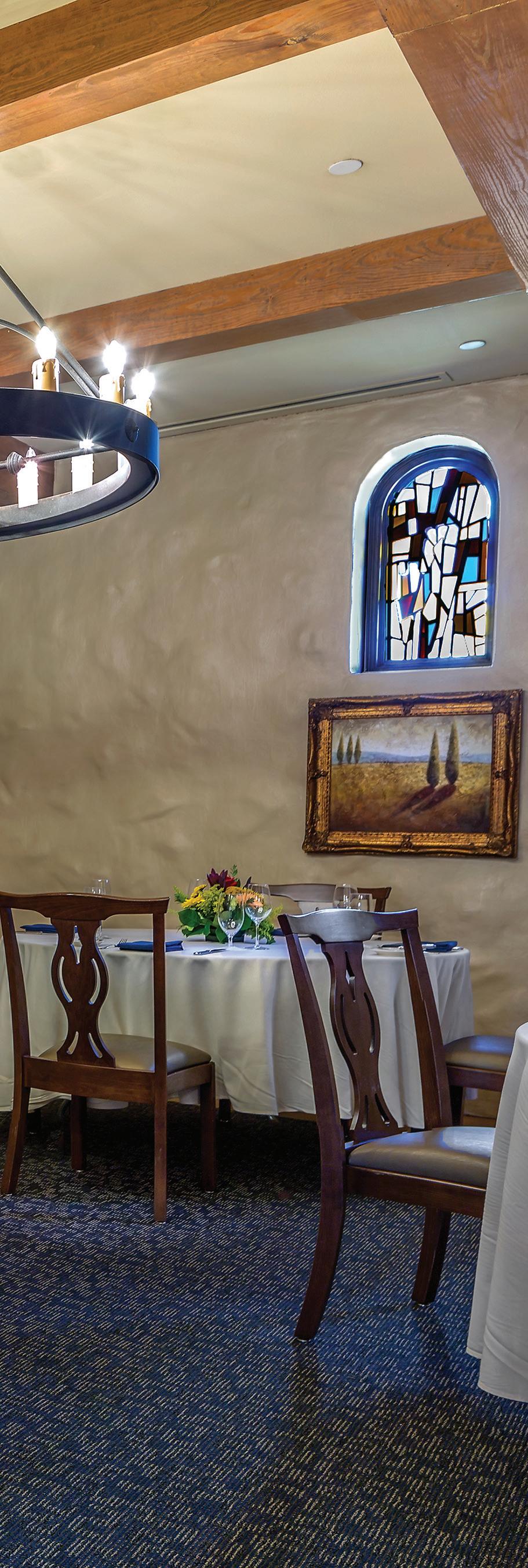 ~ Kyle Holmes, CS, CMS
~ Kyle Holmes, CS, CMS
The Club at Carlton Woods 67
RECIPE BY WES TYLER
Stuffed Blue Crab
Yield: 1 portion
Ingredients
• 1 Blue Crab Shell (cleaned)
• 3-4 ounces Blue Crab Salad
• 1/4 ounce Pea Tendrils
• 3 ounces Aged Cheddar Mornay
• 1 ounce Golden Ossetra Caviar
Blue Crab Salad
Yield: 1 Quart
Shrimp Mousse
• 100 grams Shrimp (raw)
• 50 grams Heavy Whipping Cream
Crab Salad
• 150 grams Shrimp Mousse

• 7 grams Cilantro (chopped)
• 20 grams Parsley (chopped)
• 20 grams Green Onion (chopped)
• 1.5# Jumbo Lump Blue Crab
• 2 Egg Yolks
• 15 grams Panko Bread Crumbs
• 15 grams Worcestershire Sauce
• 15 grams Dijon Mustard
• 15 grams Tony Chachere’s Cajun Spice
Aged Cheddar Mornay
Yield: 1 Quart
• 1/4 White Onion
• 1 Tablespoon Garlic (minced)
• 1 Bay Leaf (dried)
• 6 Tablespoons Blond Roux
• 4 ounces Aged Cheddar Cheese (grated)
• Salt and White Pepper (to taste)
Garnish
• Parsley Pluche
• Red Pepper Floss
• Lemon Zest (grated)
Preparation
Blue Crab Salad
Using a food processor, pulse and puree the shrimp, egg yolks, and heavy cream until a smooth consistency is reached. Transfer the shrimp mousse to a small stainless steel mixing bowl. Add the cilantro, parsley, green onions, panko, Worcestershire, Dijon, and cajun spice. Mix well until all the ingredients are fully incorporated. Gently fold in the blue crab. Refrigerate.

The Club at Carlton Woods 69
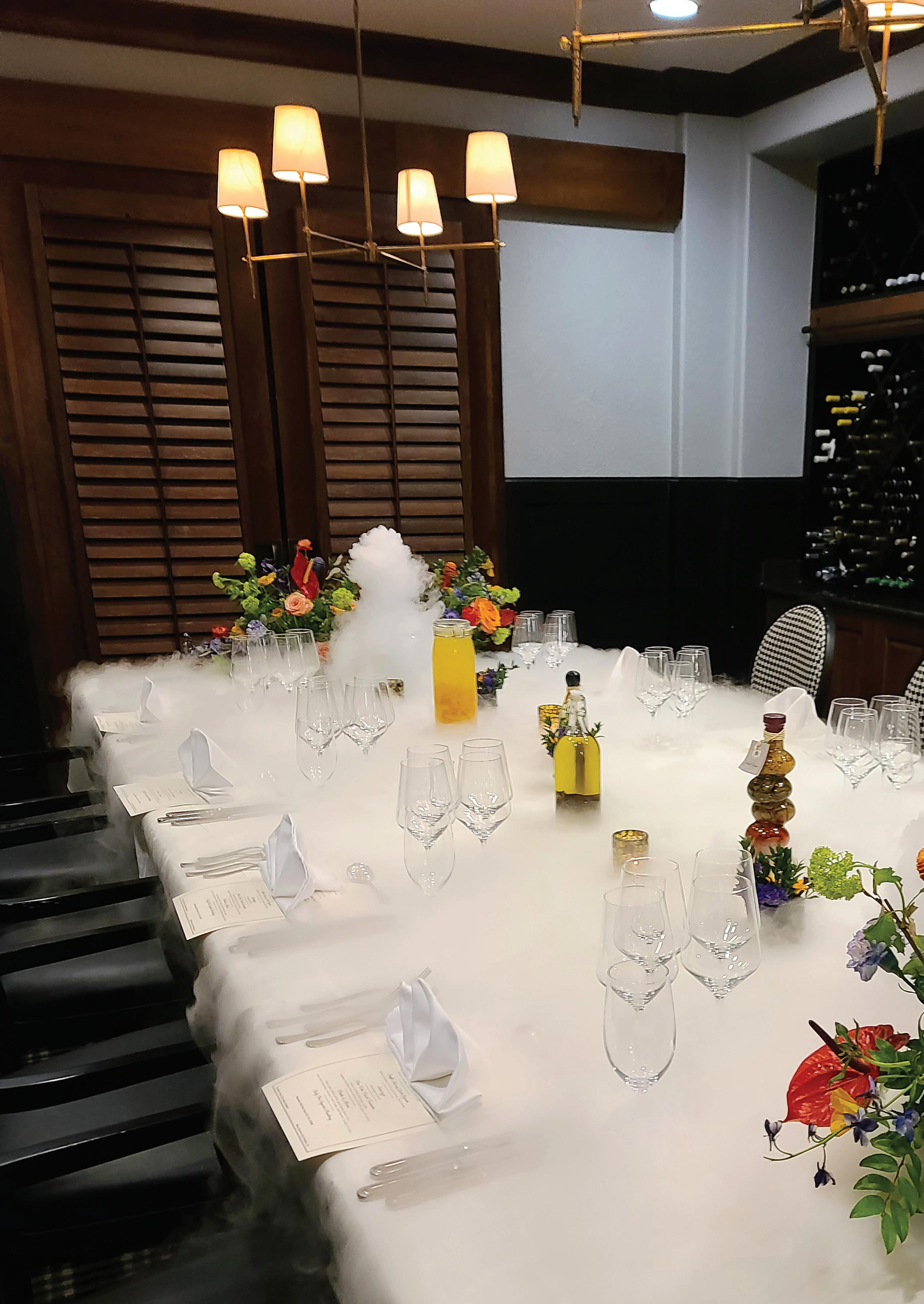 Fazio Wine Room
Image courtesy The Club at Carlton Woods
Fazio Wine Room
Image courtesy The Club at Carlton Woods
Aged Cheddar Mornay
In a medium saucepan over a low flame, sweat the onions and garlic until translucent. Add in the heavy cream and bay leaf, then bring to a low simmer. Reduce by 1/3. Once reduced, whisk in the roux and return to simmer. Allow to simmer for 5-7 minutes, stirring occasionally. Remove from heat. Whisk in aged cheddar until fully melted and the sauce becomes smooth. Season to taste with salt and white pepper.
Assembly
Preheat oven to 350°F. Stuff the empty crab shell with 3-4 ounces of the blue crab salad. Place the stuffed crab on a small stainless pan and bake in the oven for 10 minutes. Remove and set aside. Place the pea tendrils in the center of your serving plate to create a base. Place the stuffed crab directly on the pea tendrils. Spoon the aged cheddar mornay directly on top of stuffed crab, leaving some of the salad exposed. With two spoons, form a quenelle with the caviar and place directly on top of the sauce in the center of the stuffed crab. Garnish with the parsley pluche, red pepper floss and using a micro-plane, lightly zest a lemon directly over the red pepper floss. Serve immediately.
Wine Match
2011 Trimbach ‘Cuvee Frederic Emile’ Riesling, Alsace, France
What was once a racy, laser focused Riesling has aged in to a beautifully balanced white wine with perfect acid and citrus elements to complement an equally delicate and flavorful dish.
 ~ Kyle Holmes, CS, CMS
~ Kyle Holmes, CS, CMS
The Club at Carlton Woods 71
RECIPE BY WES TYLER AND ADAM JEMMOTT
Dublin Bay Langoustine and Grits
Yield: 1 portion
Ingredients
• 2 Dublin Bay Langoustines or substitute for Dublin

• Bay Shrimp (peeled, leave heads on)
• 3 ounces Homestead Gristmill Stoneground Blue Grit
• Cake 2 ounces Asparagus Tips (blanched)
• 2 ounces Moroccan Sofrito
Homestead Gristmill Stoneground Blue Grit Cake
Yield: Sheet Pan
• 2 cups Homestead Gristmill Stoneground Blue Grits
• 6 cups Chicken Stock
• 2 cups Heavy Whipping Cream
• 8 ounces Whole Butter (cubed)
• Salt (to taste)
Moroccan Sofrito
Yield: 1 Pint
• 4 ounces Carrots (minced)
• 4 ounces Onions (minced)
• 4 ounces Red Bell Pepper (minced)
• 1 ounces Garlic (minced)
• 4 ounces Tomatoes (fire roasted)
• 1 Pasilla Pepper (dried)
• 1 Tablespoon Harissa Spice
• 1 teaspoon Smoked Paprika
• 1 Lemon (charred)
• 1/2 Bunch Parsley (chopped)
• Salt and Pepper (to taste)
Garnish
• Baby Arugula
Preparation
Homestead Gristmill Stoneground Blue Grit Cake
In a saucepan over medium heat, bring the chicken stock, butter, and heavy cream to a low simmer. Add grits, stirring continuously to avoid scorching. Cook for approximately 3040 minutes, or until grits are tender and have absorbed all of the liquid. Chef Note: If the grits absorb all the liquid but are still not tender, add hot water 1/2 cup at a time, and continue cooking until soft.
Golf Kitchen Magazine 72
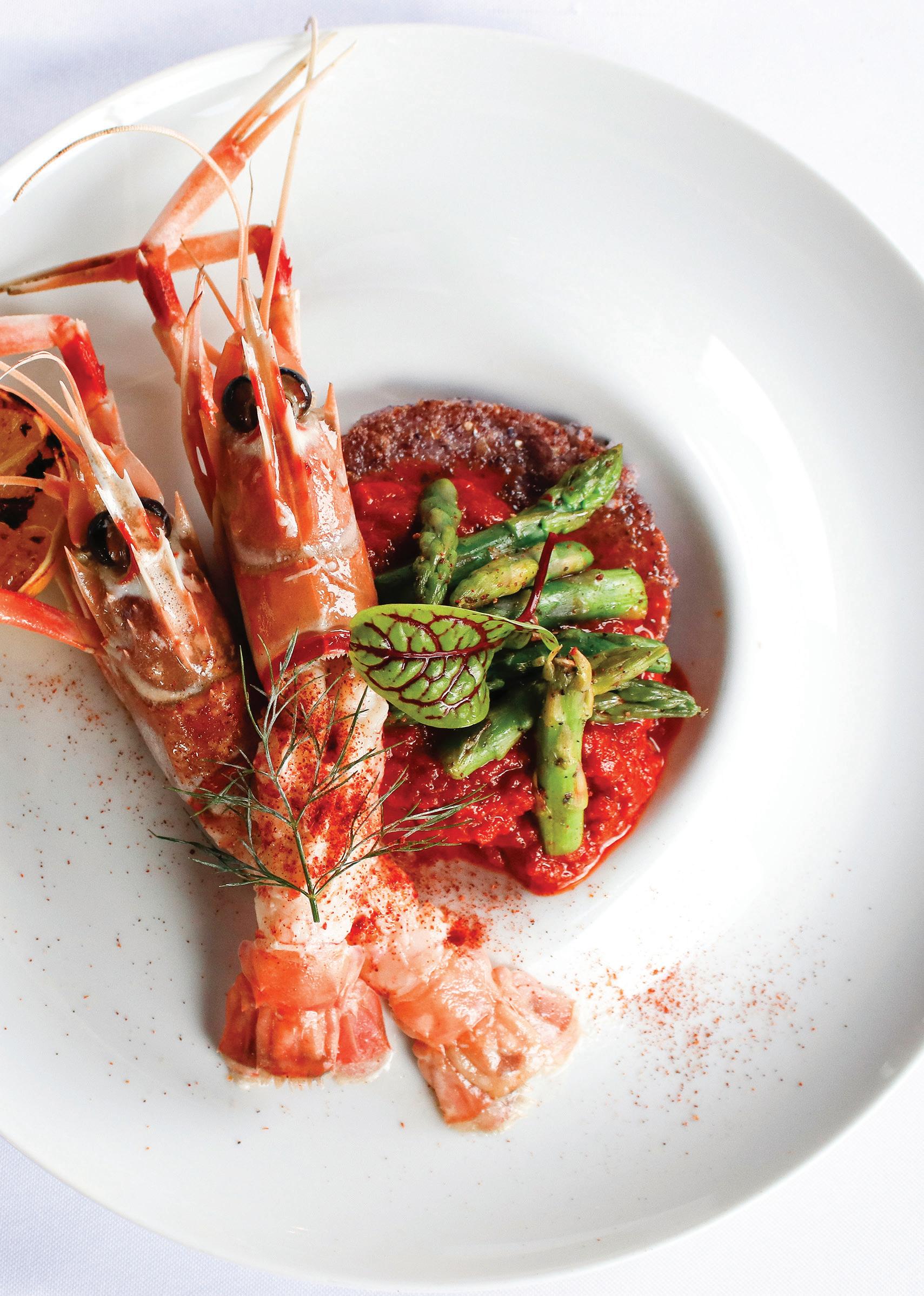
 Nicklaus Founder’s Lounge Bar
Image courtesy The Club at Carlton Woods
Nicklaus Founder’s Lounge Bar
Image courtesy The Club at Carlton Woods
Remove from heat and salt to taste. Transfer the grits onto a well-greased half-sized sheet pan (9”x13”) with a rubber spatula, spread, and smooth the top. Refrigerate 12-24 hours until cooled entirely and the grits are firmly set. Using a ring mold, punch out the desired size grit cake, then set aside.
Moroccan Sofrito
In a small saucepan over medium-low heat, add 1 tablespoon of extra virgin olive oil and sweat the carrots, onions, garlic, and bell peppers.Once the water has evaporated, add the harissa and smoked paprika, then add the tomatoes. Reduce heat to low. Separately, toast the pasilla in your oven at 350°F for 2 minutes. Remove and soak in 1/2 cup warm water for 15 minutes—puree pasilla and water into a paste. In a small sauté pan on medium-low heat, lightly sauté pasilla paste in extra virgin olive oil for 1 minute to release aromatics. Add the pasilla paste to the sofrito mix. Reduce heat to low and simmer for 60 minutes. Remove from heat. Squeeze the charred lemon and add the parsley. Sprinkle with salt and pepper to taste.
Cooking and Assembly
Using a small cast iron pan over medium-high heat, add 1 tablespoon extra virgin olive oil and pan-fry the grit cake until golden brown. Set aside. Using a small sauté pan over medium heat, add 1 tablespoon butter and lightly sauté the asparagus tips. Deglaze with white wine. Using a sauté pan over medium heat, add extra virgin olive oil and sauté the langoustines until fully cooked. Remove from heat. Set aside. Dress baby arugula lightly with olive oil and lemon juice and sprinkle the salt and pepper to taste. Place arugula in the center of the serving plate. Take the warm grit cake and place it in the center of the plate on top of the arugula.Place the sautéed asparagus tips directly on the grit cake. Place the langoustines on the outer edge of the grit cake. Drizzle Sofrito on and around langoustines. Serve hot.
Wine Match
2019 Bodegas Avancia Old Vine Mencia, Valdeorras, Spain
This ethereal, mineral, and floral wine, with it’s youthful vigor, is a perfect pairing to match the intensity of this powerful, yet elegant, dish.
 Kyle Holmes, CS, CMS
Kyle Holmes, CS, CMS
The Club at Carlton Woods 75
Braised Beef Short Rib Raviolos
 RECIPE WES TYLER, ADAM JEMMOTT, JEREMY BLAND
RECIPE WES TYLER, ADAM JEMMOTT, JEREMY BLAND
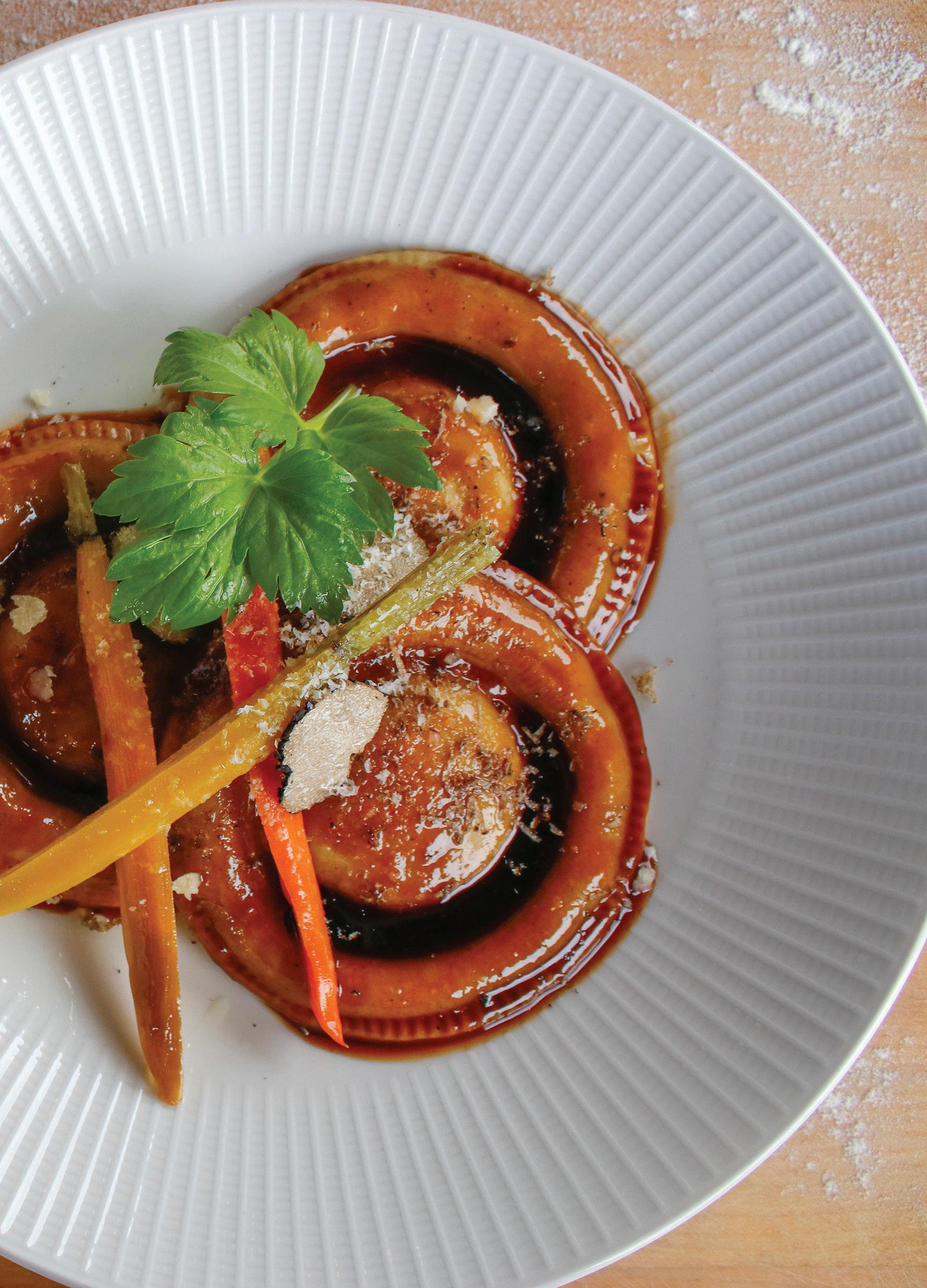
Yield: 10 portions

Ingredients
• 3 Raviolos (filled)
• 3 ounces Baby Carrots (roasted)
• 4 ounces Burgundy Jus lié
• 1/4 ounce Parmesan (grated)
• Black Truffle (garnish)
• Parsley Pluche (garnish)
Pasta Dough
• 600 grams 00 Flour
• 6 Egg Yolks
• 4 whole Eggs
• 2 Tablespoons EVOO
• 1 pinch Saffron (if egg yolks are not yellow enough)
• 1 pinch Salt
Ricotta
• 1 gallon Whole Milk
• 1 quart Heavy Cream
• 1/2 cup of fresh lemon juice (If using cream with emulsifiers like guar gum. Replace 1/4 of lemon juice with vinegar)
• Salt (to taste)
Gnudi (Ricotta Raviolo Filling)
• 200 grams Ricotta
• 50 grams fresh Parmesan
• 100 grams Flour
• 2 Egg Yolks
• Salt (to taste)
• 1 teaspoon Black Pepper
• 1/8 teaspoon Nutmeg
Short Ribs
• 10# Bone in Short Ribs
• 3# Onions
• 2# Carrots
• 2# Celery
• 1# Garlic Cloves (whole)
• 6 Bay Leaves
• 8 ounces Tomato Paste
• 10 sprigs Thyme
• 5 sprigs Rosemary
• Salt (to taste)
Chef Note: Use enough braising liquid to cover ingredients. 70% Burgundy/30% Stock
Golf Kitchen Magazine 78
Carlton Woods Meeting Placemat Image courtesy The Club at Carlton Woods
Preparation
Pasta Dough
Pour out flour into small mound on flat surface, and form small indentation in top of mound. Combine eggs, yolks, evoo, saffron, salt in small mixing bowl and mix well. Slowly pour liquid mixture into indentation on top of flour, gently folding over flour from base and incorporating until dough comes together in a homogeonous mass. Need the dough for 10 minutes, until all ingredients are well incorporated and dough becomes smooth and slightly resistant. Form dough into ball, wrap in plastic wrap, let rest for 20-30 minutes in refridgerator.
Ricotta
In a medium pot, over high heat, combine all ingredients and heat. While whisking, heat to scalding, then remove from heat. Let cool slightly, and transfer liquid to strainer lined with cheesecloth. Refrigerate and allow excess liquid to drain for 24-48 hours. Remove ricotta from cheese cloth and discard strained liquid.
Gnudi
In a small stainless steel mixing bowl, Combine all ingredients. Mix well. Transfer to piping bag.
Short Ribs
In a large rondo or stock pot, over medium heat, season and sear all sides of the short ribs in a small amount of olive oil to lock in flavor. Remove from pan. Add carrots, celery, onions, garlic, and sweat until caramelized and/ or translucent Add remaining ingredients to pot, then return the seared short ribs. Cover with braising liquid (70% Burgundy Wine, 30% Stock) Bring to simmer, let cook for approx. 3 hours or until the short ribs are falling off of the bone. Remove from heat and let short ribs cool in liquid to room temp. Once cooled, remove short ribs and shred beef, discarding any bones, fat, or connective tissue. Strain braising liquid and reserve for jus lie
Jus lié
In a medium stock pot, over high heat. Add braising liquid and bring to boil. Reduce liquid by half, then add slurry to thicken to nape consistency. Cook an additional 5 minutes. Remove from heat. Reserve
Assembly
Using a pasta sheeter. Roll out pasta dough to approx. 1/8” thick. Dust with flour and cut into 4”x4” squares. Taking one pasta square, using raviolo mold, drape pasta sheet over mold and press lightly to conform to shape. Separately, fill piping bag with gnudi. Using eggwash, lightly paint the pasta sheet with a brush. Pipe in the ricotta gnudi into the outer ring of the mold. Just filling the crevice and leaving no gaps or air. In the center of pasta sheet. Place short rib mixture, pressing down firmly to remove excess air. With separate 4”x4” pasta sheet. Lightly brush with eggwash and place directly onto previously filled mold. Press firmly
and invert. Trim raviolo edges and repeat process until all pasta and fillings are used. To cook, place raviolos in salted boiling water for 1-2 minutes. Remove from water, strain. In a medium saute pan over medium flame, sweat garlic and shallots, then add raviolos. Using jus lié from short rib braise, add liquid to pan with raviolos and allow to reduce until nape. Chef Note: If needed, demi-glace can be substituted or added in addition to. Arrange raviolos in center of plate or bowl, garnish with roasted carrots and soft herbs. Finish with remaining sauce and grated parmesan. Serve immediately.
Wine Match
2017 Antinori ‘Tignanello’ Rosso, Tuscany, Italy
Few wines can stand up to such a penetratingly flavored dish like this, but if any wine is up to the task it’s the Antinori family’s ‘Tignanello’ super Tuscan. With flavors of rich cassis and pipe tobacco, few Italian wines pair better with such incredible food.
~ Kyle Holmes, CS, CMS
The Club at Carlton Woods 79
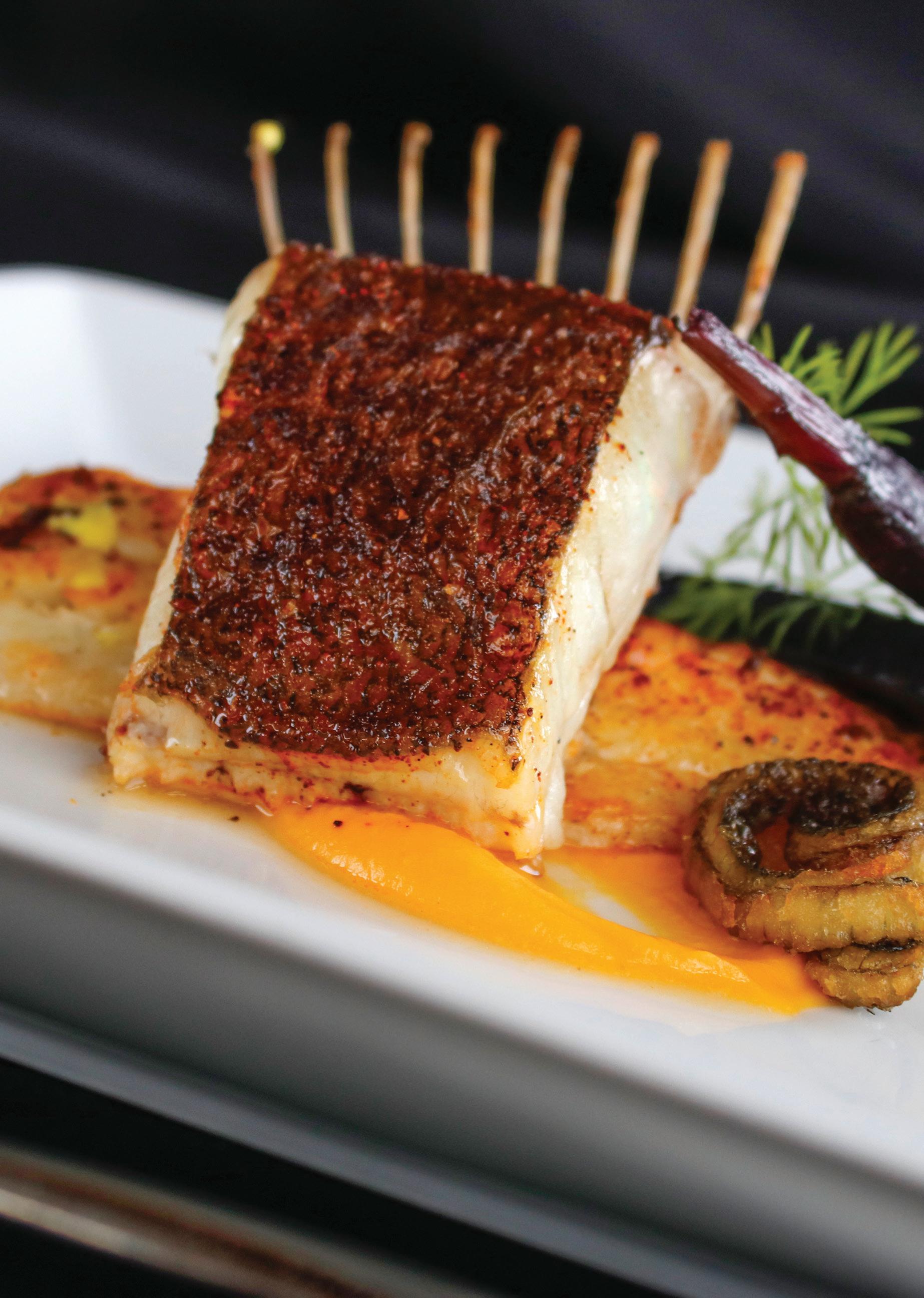 Vineyard ploughing at Joseph Drouhin Clos des Mouches
RECIPE BY WES TYLER
Vineyard ploughing at Joseph Drouhin Clos des Mouches
RECIPE BY WES TYLER
Harissa Spiced “8-Bone” Flounder Rack

Yield: 1 portion
Ingredients
• 1 - 4-5 ounce Flounder Rack (frenched, 8 bones, skin-on)
• 1 - 4-5 ounce Flounder Fillet (skin-on)
• 3 ounces Sweet Potato Nage
• 2 Purple Baby Carrots (blanched)
• 2 ounces Saffron Cream
• 1 teaspoon Harissa Spice
• Dill Frawns (for garnish)
Sweet Potato Nage
Yield: 2 cups
• 1 Sweet Potato (peeled, large diced)
• 1 cup Heavy Cream
• Salt (to taste)
Saffron Cream
Yield: 1 Pint
• 4 cups Heavy Cream
• 2 cloves Garlic
• 1 Shallot (small diced)
• 1.5 grams Spanish Saffron
• 1.5 ounces White Wine
Preparation
Sweet Potato Nage
In a small saucepot over medium-high heat, cover diced sweet potatoes with water and simmer until soft and tender. Strain sweet potatoes. Let cool slightly. In a blender, combine sweet potatoes and heavy cream. Blend to purée. Remove purée to small stainless steel bowl. Salt to taste.
Saffron Cream
In a small saucepan, lightly saute the shallots and garlic in a small amount of fat. Add in the saffron, deglaze with white wine. Add in heavy cream. Bring to a low simmer. Reduce by half. Once reduced, strain sauce through a fine sieve and reserve.
The Club at Carlton Woods 81
Assembly
Lightly dust flounder fillet and rack on the top side with harissa spice, salt, pepper. In a medium-sized sauté pan, sear the flounder rack skin side down over medium-high heat. Once the rack releases from the pan, flip and repeat with the alternate side. Remove from heat. Place in oven until rack reaches an internal temperature of 140°F. Separately, over medium-high heat, sear the seasoned fillet skin side down, flip, remove from heat, let rest. The internal temperature should be 140°F. Place the carrots over a high flame on a wood-burning grill, mark well and remove. Set aside. In the off-center of a plate of choice, dollop 1 spoonful of sweet potato nage onto the plate, swipe smoothly in the continuous flow towards the edge of the plate. Place flounder fillet offset of the nage, creating a base for the rack. Align the rack with sweet potato and lean against the fillet so the rack is standing. Shingle carrots directly on top of the fillet. Spoon saffron cream on and around the dish. Garnish with fresh dill frawns.
Wine Match
2018 Capensis Chardonnay, Western Cape, South Africa
This dish is an enigma to pair with, as it has the perfect balance of power and delicacy. Capensis Chardonnay is an incredibly unique Chardonnay with the exact same unique profile. It skirts the line between muscular and slight perfectly with intesnse richness and soft tropical elements.
~ Kyle Holmes, CS, CMS

Golf Kitchen Magazine 82
 The 7th hole at the Nicklaus course Image courtesy The Club at Carlton Woods
RECIPE BY WES TYLER, VANESSA TRISTAN
The 7th hole at the Nicklaus course Image courtesy The Club at Carlton Woods
RECIPE BY WES TYLER, VANESSA TRISTAN
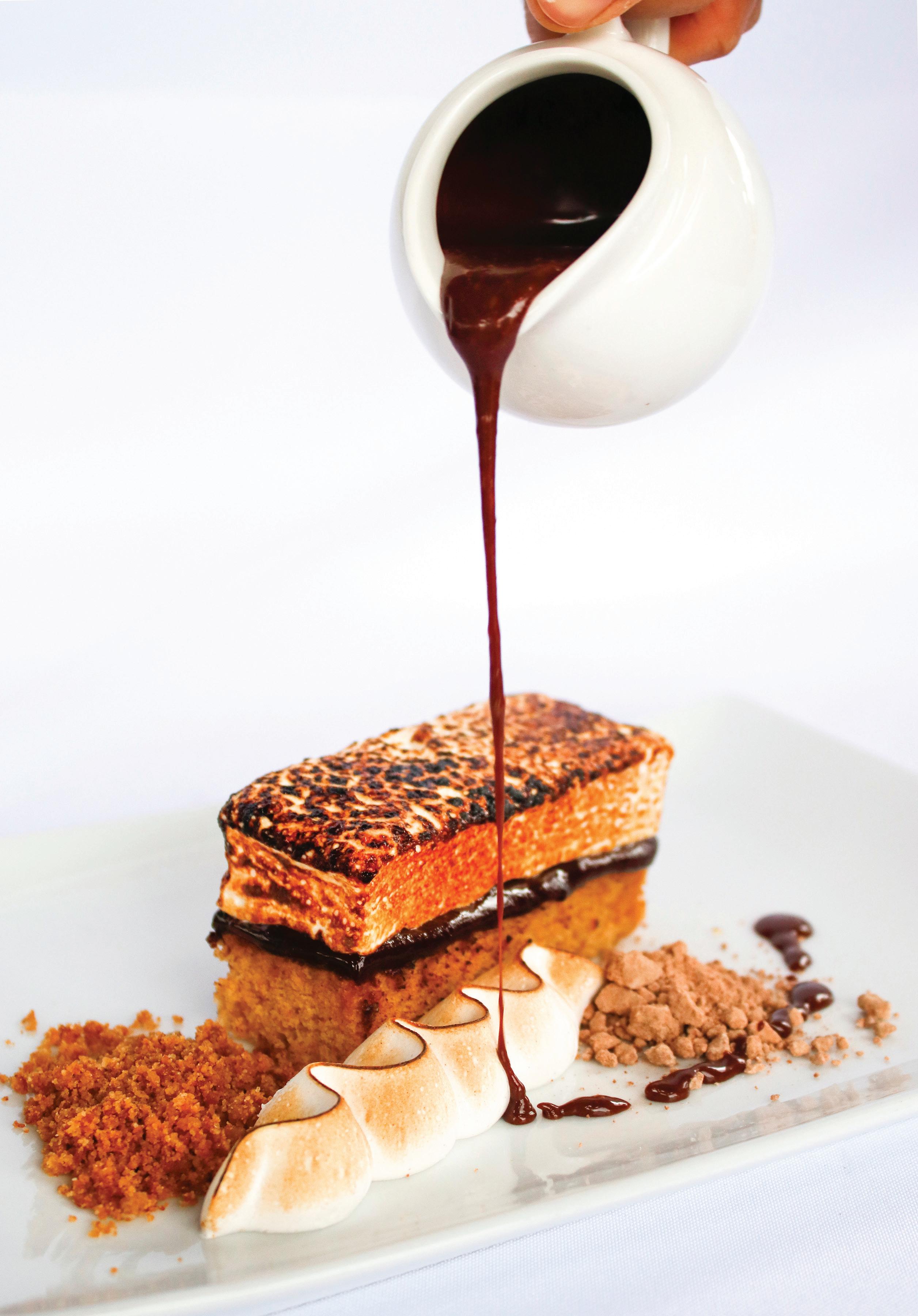
Contemporary S’mores
Vineyard ploughing at Joseph Drouhin Clos des Mouches
Yield: 1
Ingredients
• 1 Marshmallow 1.5”x 4”
• 1 Graham Cracker Cake 1.5”x 4”
• 1-ounce Cinnamon Marshmallow Fluff
• 1 ounce Hard Chocolate Ganache
• 3 ounces Soft Chocolate Ganache
• Garnish- Van leer Chocolate Crumb
• Garnish-Graham Cracker Streusel
Marshmallow
• 240 grams Cold Water
• 30 grams Powdered Gelatin
• 345 grams Granulated Sugar
• 162 grams Light Corn Syrup
• 3 grams Kosher Salt
• 10 grams Pure Vanilla Extract
• 50 grams Corn Starch
• 50 grams Powdered Sugar
Graham Cracker Cake
• 114 grams Unsalted Butter (room temperature)
• 150 grams Granulated Sugar
• 2 grams Kosher Salt
• 2 Large Eggs (room temperature)
• 5 grams Pure Vanilla Extract
• 60 grams All Purpose Flour
• 90 grams Graham Cracker
• 12 grams Baking Powder
• 180 grams Milk (room temp)
Hard Ganache
• 500 grams Van-Leer Semi-Sweet Chocolate
• 250 grams Heavy Cream
• 10 grams Pure Vanilla Extract
Cinnamon Marshmallow Fluff
• 178 grams Water
• 300 grams Sugar
• 492 grams Light Corn Syrup
• 6 large Egg Whites
• 10 grams Ground Cinnamon
• 5 grams Cream of Tartar
• 10 grams Pure Vanilla Extract
Soft Ganache
• 250 grams Van Leer Semi-Sweet Chocolate
• 500 grams Heavy Cream
• 10 grams Pure Vanilla Extract
Van Leer Chocolate Crumb
• 200 grams Sugar
• 75 milliliters Water
• 2 grams Kosher Salt
• 80 grams Vanleer Semi-Sweet Chocolate
Cracker Streusel
• 100 grams Granulated Sugar
• 60 grams Dark Brown Sugar
• 80 grams Graham Cracker Crumb
• 170 grams Unsalted Butter (cold)
• 32 grams Pure Vanilla Extract
Preparation
Marshmallow
In a heavy-bottomed saucepan, add half of the water, granulated sugar, light corn syrup, and salt and heat medium heat until it reaches 240°F. Mix the corn starch and powdered sugar in a stainless steel bowl. While the sugar mixture is on the stove, in a mixing bowl with the whisk attachment, bloom the powdered gelatin with the remaining cold water. Spray a standard-sized sheet pan with non-stick spray, and cover the pan with the cornstarch and powdered sugar mixture. Chef Note: This will ensure the marshmallows can be easily removed from the pan.
When the sugar mixture reaches 241°F, turn the mixer to medium-high and slowly pour it into the bowl with the bloomed gelatin. Keep mixing on high, until your bowl is no longer hot, about 15 minutes. The mixture will melt the gelatin, and it will start to get stringy and fluffy like marshmallow fluff. With disposable gloves on, spray both hands with non-stick spray and place the marshmallow mix onto the prepared sheet pan. Gently press marshmallow into the pan to create a flat surface, spraying your hands more if needed so that the mix doesn’t stick to your hands. Once the marshmallow is flat, heavily dust the top with the cornstarch and powdered sugar mix. Let rest at room temperature for 5 hours or overnight. When the marshmallow is set, cut into rectangles 1.5”X 4”, thick. Chef Note: This will be the topper to the graham cracker and hard ganache base of the contemporary s’mores dessert.
Graham Cracker Cake
In a mixing bowl with the paddle attachment on medium-high, cream the sugar, salt, and butter until it is light and fluffy, about 4-6 minutes. Slowly add the eggs one by one, making sure the previous one is incorporated; before adding the next one, scrape the sides of the bowl to make sure everything is incorporated. When the eggs are thoroughly mixed, add the vanilla extract. Mix the flour and baking powder, and add this to the egg mixture in the bowl in parts of two with the mixer on low speed. After the flour is very well combined, add the graham crumbs. Finally, add the room temperature milk and continue to mix. Scrape the sides of the bowl one final time and mix for one minute on medium speed or until the cake batter looks nice and creamy. Spray with non-stick spray a standard-sized 1/4 sheet pan and place parchment paper in the bottom. Add your cake batter and bake at 325°F for about 20 minutes, or until the cake batter does not stick
The Club at Carlton Woods 85
to a wooden skewer. Set aside, and let cool.
Hard Ganache
In a heavy bottomed saucepan heat the heavy cream and pure vanilla extract until it boils. Separately, place the chocolate in a medium stainless steel bowl. Spray a standard-sized sheet pan with non-stick spray, then place two layers of plastic wrap. Chef Note: The spray will ensure that the plastic does not move while spreading the ganache onto it.
When the heavy cream boils, slowly pour it over the chocolate and let it sit for a couple of minutes so that the chocolate has to melt, then slowly mix with a whisk until the cream and chocolate are combined, and you have a ganache. Pour the ganache onto the prepared sheet pan, and place it in the cooler until set. When the ganache is set, and the graham cracker cake is cooled, place the ganache over the cake, making sure it is appropriately aligned. Then cut into rectangles of 1.5” X 4”. Chef Note: This will be the base of the contemporary s’mores.
Cinnamon Marshmallow Fluff
In a heavy-bottomed saucepan, heat the water, sugar, light corn syrup on medium-high heat until it reaches 241°F .In a stand mixer bowl with the whisk attachment, add the egg whites and start mixing on medium speed when the sugar mixture reaches 230°F add the cream of tartar when the egg whites become frothy. Once the sugar mixture reaches 241°F turn the mixer to high, and in a slow steady stream, pour the sugar mix over the egg whites. When the sugar mix is incorporated, add the vanilla extract. Switch the mixer to low, and carefully add in the cinnamon. Once mixed, switch the mixer back up to high and mix until the marshmallow fluff is smooth and no longer hot about 6-10 minutes—store in an airtight container at room temperature, and lightly re-whip once you are ready to use.
Soft Ganache
Heat the heavy cream and pure vanilla extract until it boils in a heavy-bottomed saucepan. While waiting for the heavy cream to boil, place the chocolate in a medium stainless steel bowl. When your heavy cream boils, slowly pour it over the chocolate and let it sit for a couple of minutes so that the chocolate has to melt, then gradually mix with a whisk until the cream and chocolate are thoroughly blended, and you have a ganache. Chef Note: Keep warm in a Bain Marie until ready to use, or store in an airtight container in the cooler to store for later.
Van Leer Chocolate Crumb
Place the sugar, water, and salt in a heavy-bottom saucepan with the heat on medium-high until it reaches 275 °F, do not stir. Once the sugar mixture has reached 275 °F turn off the heat, and add in the chocolate. Using a wooden spoon, quickly stir so that the sugar and chocolate are well mixed. Transfer the chocolate mixture onto a container and let cool. Chef Note: There
will be large chunks of the chocolate/sugar mix, but these can easily be crushed into smaller pieces using a food processor.
Graham Cracker Streusel
In a medium stainless steel bowl, mix the granulated sugar and the brown sugar until very well combined. Then add the All-Purpose flour and Graham Cracker Crumb. Using a cheese grater, grate the butter into the dry ingredients, making sure not to let the butter clump together. Lastly, add the vanilla with your hands and gently rub everything together until the vanilla is incorporated into the dry ingredients. Place the streusel in a standard-sized sheet pan and bake at 325°F for about 25-30 minutes, or until golden brown. Set aside and let cool.
Assembly
Place preformed s’mores cake in the center of the dish of choice. Gently pipe ribbons of marshmallow fluff on top of the cake. Garnish with van leer chocolate crumb and graham cracker streusel on either side of the s’mores cake Chef Note: Serve with warm chocolate ganache, pour-over tableside.
Wine Match
1961 Taylor Fladgate Tawny Port, Porto, Portugal
A recent release from legendary winemaker Taylor Fladgate, this wine has been aging in barrels for 60 years before its release in 2021. Evocative notes of dried fig, toasted cinnamon, and smoked clove are the perfect complement to a dish that’s so evocative of being beside a campfire..
~ Kyle Holmes, CS, CMS
Care Locally. Unite Nationally.
Join the golf industry’s first-ever national network of clubs dedicated to amplifying and promoting local and national philanthropy
Supporters of ClubsHelp include golf luminaries Jack Nicklaus and Ernie Els, national corporations CLIF Bar and Ahead, and prominent golf clubs such as Seminole and Desert Mountain. There is no cost to join -- this organization is focused on supporting causes in local communities and banding together in times of crisis or tragedy.

Access to a customizable, online fundraising platform for fundraisers and events
Networking with partners for potential synergies and event support
Turnkey charitable events run under the ClubsHelp Foundation's 501(c)3 umbrella

Introduction to disaster relief affiliate Operation BBQ Relief and others






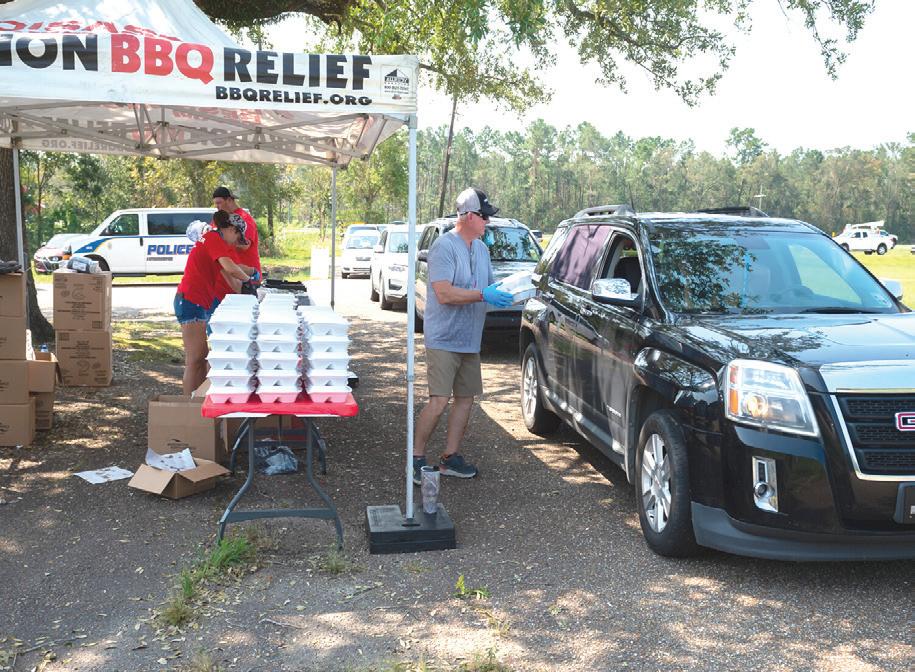

ClubsHelp.org
ROB LABRITZ’ NUTRITION TIPS
before, during and after golf
“ Consistency in my energy levels is critical. I need the energy to practice, play, and focus. I can maintain power in all three areas by what I put into my body.
~ Rob Labritz, PGA Tour Champions Director of Golf at GlenArbor Golf Club

”

Nutrition
GK: Can you tell us about your nutrition before, during, and after your game?
Food and nutrition are essential for my professional golf career. Consistency in my energy levels is critical. I need the energy to practice, energy to play, and energy to focus. I can maintain power in all three areas by what I put into my body.
I will spend a considerable amount of time walking the course before a tournament. A week before, I will decarb, and then I’ll carbup the day before an event. While I generally follow a keto-style diet, with some carbs mixed in, I know I need the carbohydrates to compete effectively.
On the morning of a tournament, I eat egg whites, fresh fruit such as strawberries, blueberries, mangoes, and a piece of toast. That’s my daily breakfast. I am occasionally a big salad and chicken advocate for lunch and splurge on steak. I eat a ton of vegetables, so much that my wife calls me a vegetarian; even though I am not, I still like my proteins. (laughs)
During the tournament week, I will eat a lot of pasta as I walk around 7-9 miles for four hours, so much energy is required. When I am out on the golf course, I snack on almonds and drink Isagenix Shakes. I will often have Isagenix as a breakfast replacement if I am in a rush.
Teaching.
GK: Has your dietary teaching method changed in the last 20 years?
It has gotten better for sure. I removed all processed foods, food bars, and refined sugars. These may give you a quick sugar high, but you will crash soon afterward. I recommend Epicured’s Protein Energy Bites, they keep me at an optimal energy level while competing on the golf course and they taste amazing!
I am a big advocate for Athlade, for sustained energy both pre-round, during, and post. Athlade provides natural energy, boosts endurance, enhances immunity, improves hydration, and helps reduce inflammation associated with physical and mental stress*.
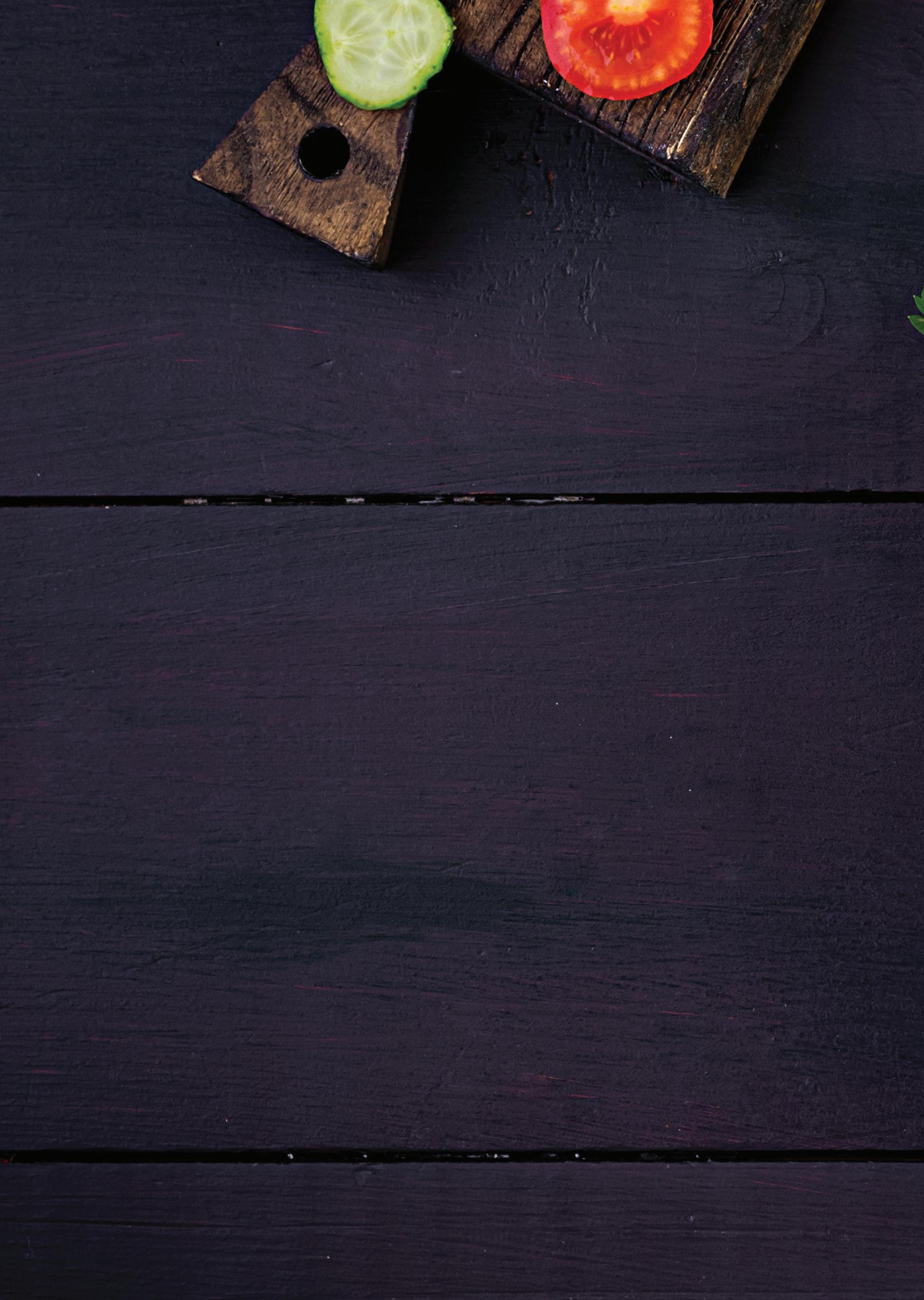
GK: What do you advise new clients and members?
People develop habits over the years, and it is challenging to change someone’s diet. I recommend a significant amount of stretching, and I advocate for clean eating. If they are playing golf for fun, I suggest they carbup to sustain energy throughout the day. I recommend any foods containing anti-inflammation ingredients at the end of the day.
Hydration is essential; a bottle of water per hour during a game and mix in some electrolytes like the Athlade. Practice good sleeping habits.
GK: How satisfying is watching clients progress if they follow your recommendations?
It is incredibly satisfying to see someone taking the information I provide and turning it into improvement in their game. I try to give them the best advice to live their best lives, and if they follow it, their bonus is an improved golf game! It is almost as exciting as winning a tournament!
If you follow your golf pros guidance it will improve your golf game, your health and life!
“ If you follow your golf pros guidance it will improve your golf game, your health and life.”
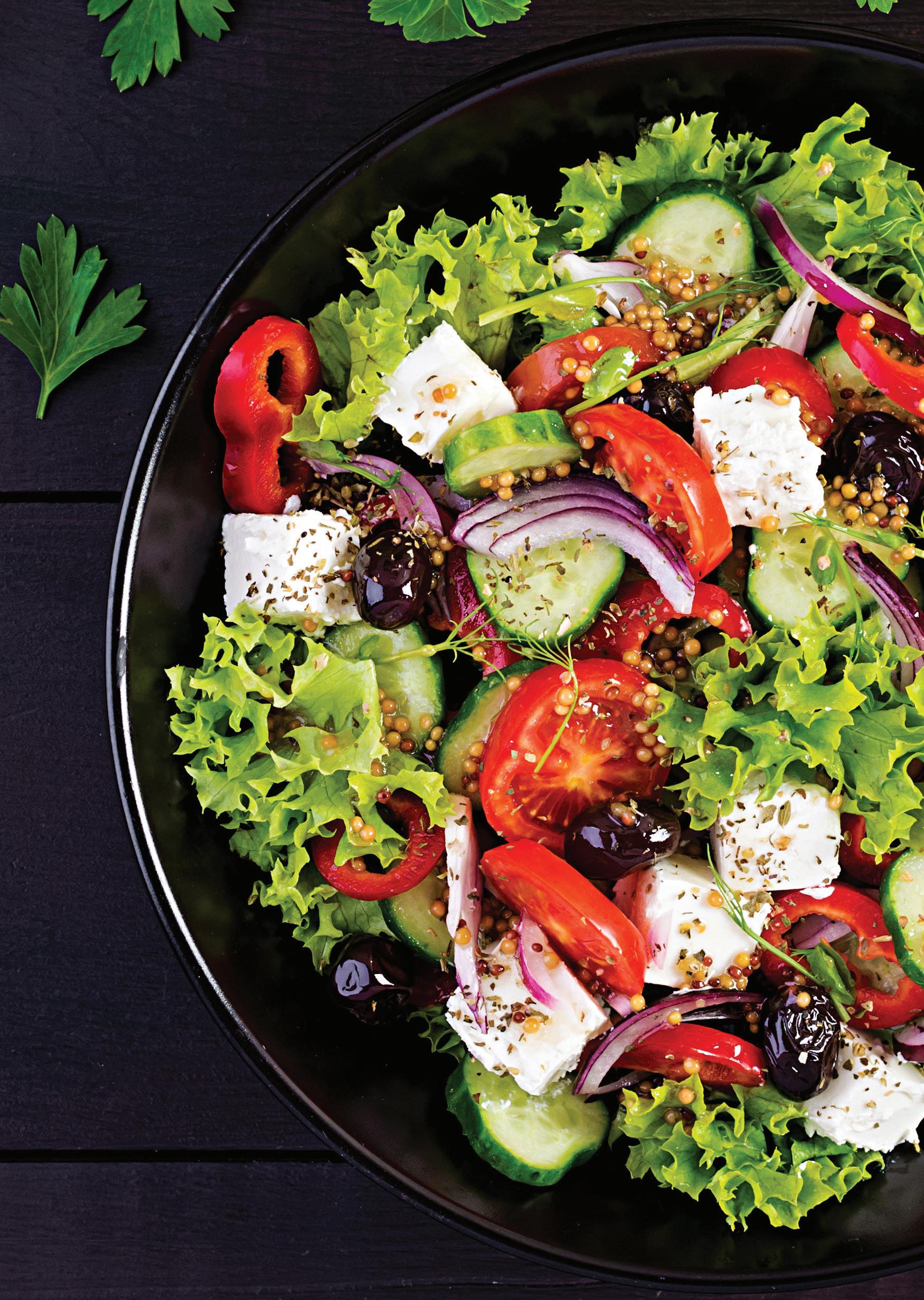
REYNOLDS LAKE OCONEE GREENSBORO, GEORGIA


The Landing Course Im age courtesy Reynolds Lake Oconee
A MOROCCAN CHEF WITH INTERNATIONAL FLAIR
ZOUHAIR BELLOUT Executive Chef Reynolds Lake Oconee
I am very fond of Morocco and have traveled all over the country. When I first met Zouhair Bellout he was the executive sous chef at Reynolds Lake Oconee and presented all the qualities of an executive chef. I was excited to learn that he has been promoted to the position in 2021. I look forward to watching his career develop to his fullest potential, not only for Reynolds but selfishly because I am thrilled that a Moroccan chef is taking the lead in Georgia and the United States.
~Diana DeLucia
From There to Here
As a boy growing up in Fez, Morocco, Zouhair Bellout loved to cook from a young age. He was not fond of his mother’s cooking and after his father passed away, Zouhair’s interest in cooking for his family developed when he was seven years old.
Zouhair followed his passion, enrolling in culinary school at Morocco’s Institu de Technologie Hoteleire et Touristique, where he earned a degree in culinary arts. During his studies, he pursued externships at hotels in Marrakesh, Agadir, and Tangier, opening new doors and opportunities. Following graduation in 2005 he came to the United States, where he worked for several notable companies, including Walt Disney World, Loews Hotels, and The Ritz-Carlton. While working for The Ritz-Carlton he was honored with an invitation to cook at James Beard House in New York City—an opportunity that provided him with valued experience and new contacts.
In January 2016, Zouhair came to Reynolds Lake Oconee, a prestigious golf resort community in North Georgia. He started as banquet chef de cuisine, moved up to chef de cuisine at Creek Club (one of Reynolds private clubs), and advanced to executive sous chef of platinum dining, overseeing the culinary operations for Reynolds Lake Oconee’s highest-level membership. In these roles, he enjoyed the creative freedom of designing boutique menus, food and wine pairings, and
seasonal offerings.
He was promoted to the community’s executive chef in October 2021, leading all culinary operations for seven restaurants, and Reynolds’ banquets, member events, cafés, and more, while also playing an integral strategic planning role.
International Flair
One of Zouhair’s recent successes was designing, planning, and opening the community’s newest dining venue at Richland Pointe. This lakefront restaurant is the centerpiece of a new village enclave located within the larger community. With Adam Di’Christina, Chef de Cuisine at Richland Pointe, by his side, the duo has hit a home run.
Their menu is infused with international flair, the diverse offerings tracing their origins from Mexico, Italy, Spain to Morocco, and other tasty locations around the globe.
“I’ve kept a collection of ideas from traveling around the world and building relationships,” says Zouhair. “What we offer are samples of those experiences so members can come into the restaurant and create their own memories, the same way you do when you’re on vacation.”
The restaurant and bar feature both indoor and outdoor rooms that draw on the energy that flows from picturesque Lake Oconee, world famous for watersports and fishing. Serving food and drinks in an casually elegant setting has quickly made it a member favorite.
Zouhair loves to roam the markets and farm stands throughout the agriculturally rich region, driving as far as Atlanta, 70 miles away, turning his discoveries into exciting new combinations, both for his own family—he and his wife Jessica have three children—as well as for
Golf Kitchen Magazine 94

“I enjoy picking up fresh-grown corn in the summertime and look forward to finding it every year. If I can find the Silver Queen variety (out of New Jersey), it’s my favorite. I use it to make fresh corn grits. It’s a white, sweet corn, so when cooked down it’s got a sweet flavor and the sweetness of the corn comes through. I finish it up with cheese. It’s a huge taste difference compared to making grits out of dry corn.”
In fall, he looks for squash.
“There are so many varieties, and each has its own flavor, texture, and sweetness. The different types are what makes it fun to create recipes and new dishes. What I make depends on what is available and then, what each variety lends itself in terms of flavor.”
One of his favorite dishes is an acorn squash and chickpea tart, with sage and brown water, the nut-like flavor pairing well with the other ingredients. “Kabocha squash has a fluffy texture and sweet flavor – almost like a sweet potato crossed with pumpkin,” he explains. “Its deep orange color is great and sweet enough for purees that can be used with fish or lamb.”
Like any Southern chef—even one who started his career thousands of miles away—Zouhair has a macaroni-and-cheese recipe in his arsenal.
“We use a combination of clothbound-aged cheddar, nice-quality gruyere, and parmesan. These three cheeses melt well together. You don’t want the cheese in a macaroni-and-cheese recipe to leave a grittiness on your tongue. Plus, the smooth, velvety cheeses we use stick to the pasta and provide the right balance of gooeyness we’re seeking. And what is not to love about using three types of top-quality cheeses?”
Every dish on every menu at Reynolds Lake Oconee requires hours of conversations and trials to get it right. The Israeli salad might look simple, but when you try it, you know it pays respect to another culture.
“I’m a curious person, so I go to new places, make friends, and to ask questions,” says Zouhair. “Even a dish as simple as Indian Butter Chicken. An Indian sous chef and friend would invite me to have dinner at his house, and I’d always go into the kitchen to watch his parents cook. This recipe is derived from how they make the butter chicken.”

Golf Kitchen Magazine 96
Richland Pointe exterior at sundown.
Image courtesy Reynolds Lake Oconee

 Richland Pointe Restaurant
Image courtesy Reynolds Lake Oconee
Richland Pointe Restaurant
Image courtesy Reynolds Lake Oconee
Behind The Menu
For Chef Zouhair, food isn’t just about eating, it’s about a personal connection to someone, somewhere. “When a table is full,” he says, “it becomes a representation of people and customs around the globe. There’s a story behind everything.”
Here are some of the tasty stories at Reynolds Lake Oconee’s new Richland Pointe restaurant:
Mexican Street Corn: This is an art in Central America, where the char and the seasoning must be just right. Anyone from Mexico to El Salvador who tries this will probably think of grandma.
Saké: Anywhere in the world, when I see saké on a table I’ll hear people having fun. It’s no surprise that we serve a lot of it at Richland Pointe.
Naan: This bread originated in India and has become popular throughout Asia, Europe, and the Caribbean. It’s as much of a staple at Richland Pointe as fresh bread.
Global Wines: Our wine list includes vineyards from every corner of the world. Members can even try different wines in flights.

Lime Marinated Avocado: We’ve learned some nuances from our Latin friends. It’s hard to stop eating, which is why we go through so many avocadoes every week.
Persian Rice: This type of rice has a unique fragrance with a fluffy texture. I call it “humble, but satisfying.”
Hitachino Nest Beer: It’s brewed near a Japanese village, where they craft the beer specifically to be served with local foods.
Grilled Lamb Kabobs: When I was growing up in Morocco, I’d stop by a food stand on my way home from school and snack on a lamb kabob before dinner, so this brings back a lot of memories.
Grouper Street Tacos: When I worked as a chef on the Gulf Coast of Florida, we’d go to the farmers market on Saturday and stop at the taco stand. You could tell the grouper was always fresh, and that makes all the difference.
Reynolds Lake Oconee 99
RECIPE BY ZOUHAIR BELLOUT
“C IOPPINO” WITH TUNA, HAMACHI, SHRIMP, MUSSELS, SCALLOPS, TOMATO WATER, OLIVE CRUMBLE AND RADISH
Serves 4
Ingredients
Olive Crumble
• 2 cups Kalamata Olives (pitted)
• 3 sprigs Thyme
• 1 Orange (zest)
Tomato Water
• 1 1/2 pounds Beefsteak Tomatoes (about 3)
• 1 cup fresh Basil Leaves
• 2 medium Shallots (chopped)
• 2 Garlic cloves (sliced)
• 1 bulb Fennel
• 3 Tablespoons Sherry Vinegar
• 1 Tablespoon Kosher Salt
Seafood
• 8 ounces Tuna
• 8 ounces Hamachi
• 4 Prawns
• 2 Scallops
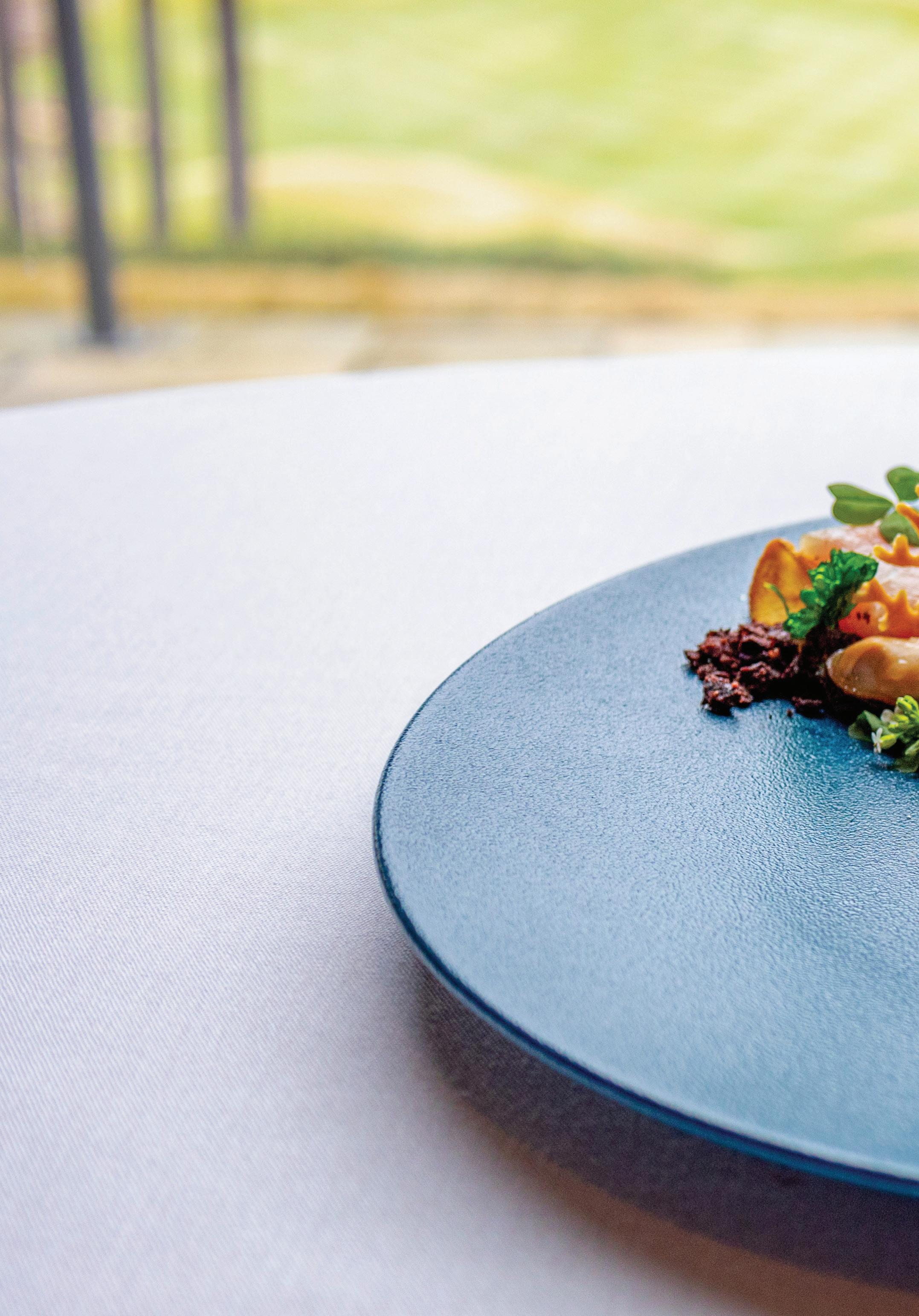
• 8 Mussels
• 1 cup White Wine (for steaming mussels)
• 1 sprig of Thyme
• 1 Tablespoon Butter
Coral Cracker
• 100 grams All-purpose Flour
• 130 grams Egg White
• 100 grams Butter (melted)
Garnish
• Coral Cracker (see recipe)
• Herbs
• Radish
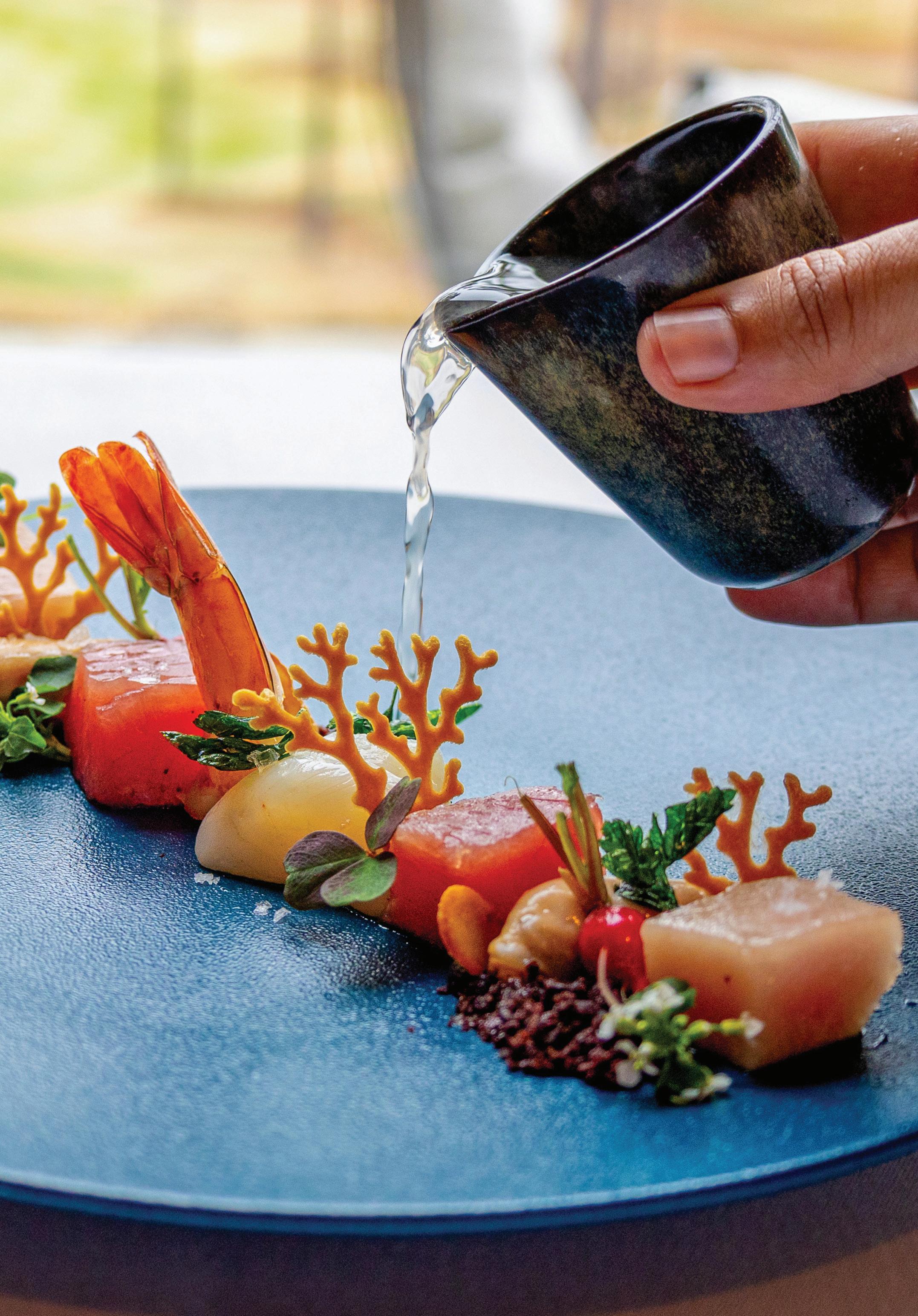
Highlands Falls Country Club Image courtesy Reynolds Lake Oconee
Preparation
Olive Crumble
Place on Kalamata Olives, thyme and orange zest on a silicone mat. Dehydrate in the oven at 150 °F for 3 hours, or until dehydrated. Pulse using a food processor, but don’t allow them to be too fine.
Tomato water
Line a china cap with cheesecloth; set over a large bowl. In a food processor, stir tomatoes, shallots, garlic, fennel, basil, vinegar, and salt until coarsely chopped. Pour the mixture into the lined china cap—cover and chill for at least 12 hours. Chef Note: Do not stir or press on solids, or the tomato water will be cloudy. Discard solids; cover the tomato water, and chill.
Seafood
Clean and cut the tuna and the Hamachi into cubes ½ inch, cut the scallops in half then steam the mussels and the prawns in a sauté pan using the white wine, butter and thyme.
Coral Cracker
In a mixing bowl, combine the ingredients then spread onto a silicone mold and bake at 325 °F until golden brown. Set aside.
Assembly
On a serving plate, arrange the seafood and garnishes with the olive crumble, the coral cracker, and the herbs.
Wine Match
Villa Matilde Greco di Tufo, Campania 2020
Fantastically balanced Italian wine to go with the medley of flavors the Chef has created with his “Cioppino dish.”
 ~ Reuben Atkinson, Cellar Wine Manager
~ Reuben Atkinson, Cellar Wine Manager
Golf Kitchen Magazine 102
 The Creek Club Restaurant
Image courtesy Reynolds Lake Oconee
RECIPE BY ZOUHAIR BELLOUT
The Creek Club Restaurant
Image courtesy Reynolds Lake Oconee
RECIPE BY ZOUHAIR BELLOUT
KING CRAB SALAD WITH PICKLED GINGER AND PEAR PURÉE, SAKE GEL, CORIANDER, BASIL AND EDIBLE FLOWERS

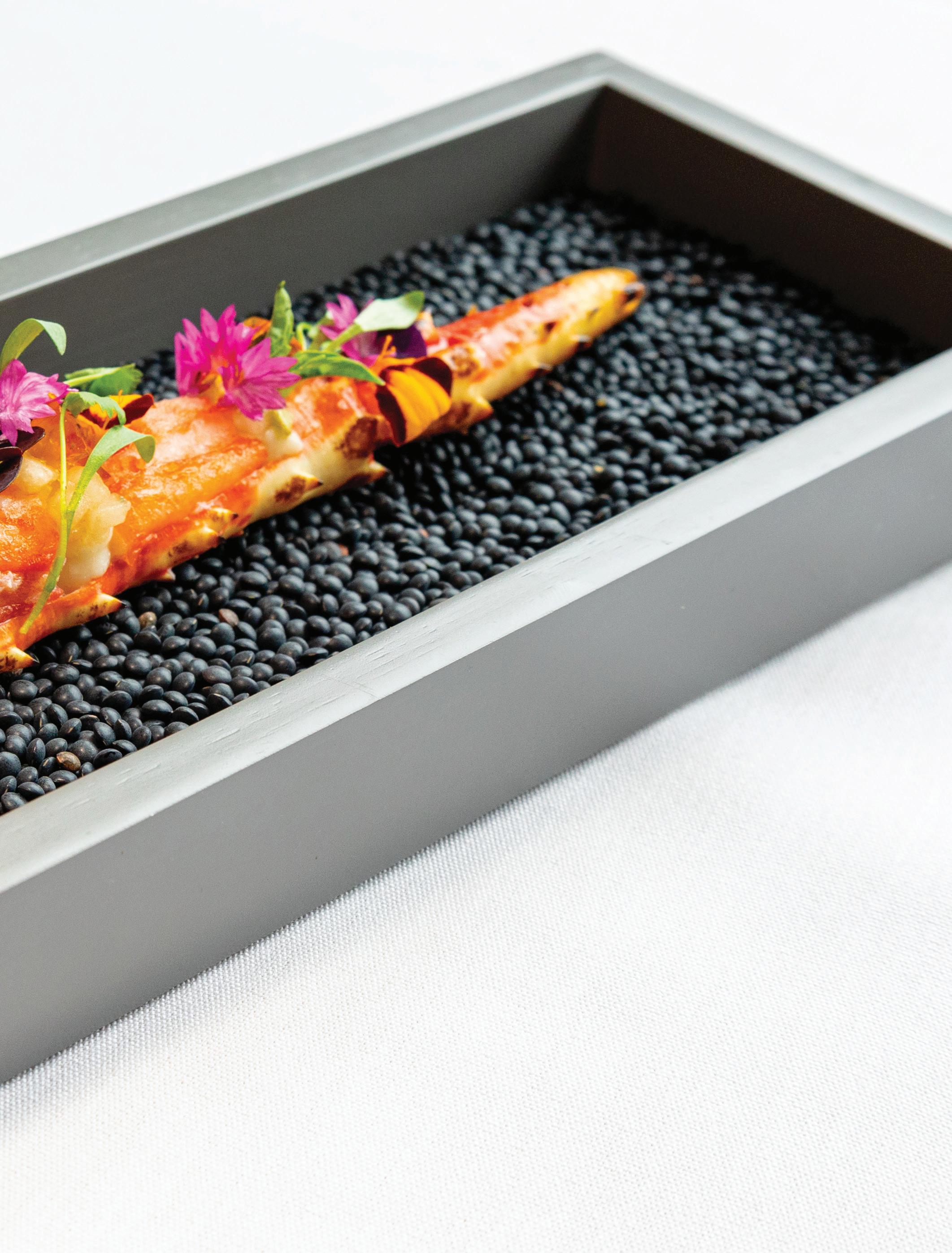
Image courtesy Reynolds Lake Oconee
Serves 4
Ingredients
King Crab
• 4 King Crab
Pickled Ginger and Pear Puree
• 1/4 cup Ginger (pickled)
• 3 Pears (peeled and diced)
• 1 Shallot (sliced)
• 1 teaspoon Honey
• 1/4 Lemon (peel only)
Sake and Saffron Gel
• 1/2 quart Sake
• 7 sheets Gelatin
• 1 pinch Saffron
Pear Salad
• 1 pear (small diced)
• 1/4 Shallot (small diced)
• Thyme (chopped)
• 1 teaspoon Champagne Vinegar
• 1 teaspoon Grape Seed Oil
Garnish
• Edible Flowers (The Chef’s Garden)
Preparation
King Crab
Using kitchen shears, cut the shell of the crab leg in half lengthwise, remove the meat and cut into 1-inch pieces. Set aside.
Pickled Ginger and Pear Puree
Preheat the water bath to a temperature of 80⁰C. Seal the pear inside a vacuum bag with honey, shallots, and lemon peel. Place in the water bath and leave to cook for 20-30 minutes, depending on ripeness. Chef Note: The riper the fruit, the less time it will take to cook. To test if the pears are cooked, give the fruit a gentle squeeze: if it feels soft, it is ready.
Empty the vacuum bag, drain off the poaching liquid, place in a blender, add the pickled ginger and some poaching liquid as needed. Puree in a blender—season with salt.
Sake and Saffron Gel
Warm the sake with the saffron in a small saucepot on medium heat and add the hydrated gelatin sheets; pour into a shallow pan and refrigerate when melted.
Pear Salad
Mix the pear, shallot, thyme, champagne vinegar, and oil in a large salad bowl, then season with salt and pepper.
Assembly
Place the pieces of the crab back into the shell, leaving a gap in between each piece, fill the gap with the pear puree, and top with the pear salad, garnish with the sake gel and the herbs and flowers.
Wine Match
Gundlach Bundschu Dry Gewurztraminer, Sonoma Coast 2019
One of my favorites, this mesmerizing dry Gewurztraminer will bring out the nuances in this crab-based dish and delight the senses.
~Reuben Atkinson, Cellar Wine Manager
Golf Kitchen Magazine 106

The Creek Club Bar Image courtesy Reynolds Lake Oconee
 The Creek Club course, hole #5
Image courtesy Reynolds Lake Oconee
The Creek Club course, hole #5
Image courtesy Reynolds Lake Oconee

 Image courtesy Reynolds Lake Oconee
RECIPE BY ZOUHAIR BELLOUT
Image courtesy Reynolds Lake Oconee
RECIPE BY ZOUHAIR BELLOUT
SEA BASS WITH SQUASH, PEAS, PURPLE POTATO, BLACK GARLIC AIOLI, TARO CRISP AND NASTURTIUM
Serves 4
Ingredients
Sea Bass
• 4 portions of 5 ounce Sea Bass
• Vegetable Oil (for searing)
• Salt and Pepper (to season)
Pea Purée
• 1 cup Peas
• 1 sprig Mint (fresh picked)
• 1 Tablespoon Lemon Juice
• 1 teaspoon Coriander Seeds
• 1/2 Shallot (sliced)
• 1 teaspoon Garlic (chopped)
Purple Potato Purée
• 2 Purple Sweet Potatoes
• 1 Tablespoon Honey
OSTRICH WITH HONEY TOASTED FARRA AND GOLDEN RAISIN EMULSION
• 3 Tablespoons Butter (cold)
Black Garlic Aioli
• 1 bulb of Black Garlic
• 1 cup Mayonnaise
• Juice and zest of 1 Lemon
Squash Purée
• 1 Butternut Squash
• 3 Tablespoons Butter

• 1 Tablespoon Honey
• 1 pinch Cayenne Pepper
Reynolds Lake Oconee 111
Taro Crisp
• Taro Root
• Salted Water
• Vegetable Oil
Garnish
• Nasturtium Flowers
Preparation
Sea bass
Season the sea bass with salt and pepper and sear until golden brown, finish in the oven.
Pea Purée
Start by sweating shallots and garlic, add coriander seeds, peas, and a splash of water and mint leaves in a saucepot. Once peas are soft, place in a blender and purée, finish with lemon juice, and season with salt and pepper.
Purple Potato Purée
Bake the sweet potatoes on a sheet pan until soft, peel, and process in a vegetable ricer, season with the salt, pepper, and honey, then fold in the butter until a smooth consistency.
Black Garlic Aioli
Peel and purée the black garlic, add the mayo, lemon juice, and zest, season with salt and pepper. Set aside.
Squash Purée
Cut the butternut squash in half, toss in oil, salt, and pepper, roast on a sheet pan, then cut side down until soft. Place the flesh in a blender, add the butter, cayenne, honey, blend until smooth, season with salt and pepper.
Taro Crisp
Slice the taro root thin and blanche in salted water, then fry to crisp up using a taco mold .
Assembly
Start by making your preferred design on the plate using the purées, place your fish on one side and place the taro root chip on the other side, garnish with nasturtium flowers.
Wine Match
Pazo Senorans Albarino, Rias Baixas 2019

This Spanish Albarino will be a fantastic medium-bodied wine to pair with this excellent sea bass dish that Chef has created.
~ Reuben Atkinson, Cellar Wine Manager
Golf Kitchen Magazine
112
Richland Pointe Village Image courtesy Reynolds Lake Oconee

 Image courtesy Reynolds Lake Oconee
RECIPE BY ZOUHAIR BELLOUT
Image courtesy Reynolds Lake Oconee
RECIPE BY ZOUHAIR BELLOUT
Beef Tagine with Marcona Almonds and Tfaya
Yield: 4
Ingredients
Beef Tagine
• 1# Beef Shortrib (cut into 2 to 3-inch pieces)
• 2 medium Onions (sliced)
• 3 cloves Garlic (finely chopped)
• 1 teaspoon Black Pepper (finely ground)
• 1 teaspoon Ginger (ground)
• 1/2 teaspoon Saffron Threads
• 1/2 teaspoon Turmeric (ground)
• 1/2 teaspoon Ras el Hanout
• 2 small Cinnamon Sticks
• 1/2 cup Olive Oil
• 1/4 bunch Cilantro (tied with kitchen twine)
Tfaya
• 1 cup Raisins
• 2 pounds Onions (sliced)
• 4 Tablespoons Unsalted Butter
• 1/4 cup Honey
• 1 teaspoon Black Pepper (freshly ground)
• 1 teaspoon Cinnamon
• 1/2 teaspoon Ginger (ground)

• 1/2 teaspoon Turmeric
• 1/4 teaspoon Saffron Threads (crumbled)
• 1/2 cup Water
• 2 to 3 teaspoons Orange Flower Water
Garnish
• Edible Flowers (optional) (The Chef’s Garden)
• Micro Cilantro (The Chef’s Garden)
Preparation
Beef Tagine
Combine the meat, onion, garlic, salt, pepper, ground ginger, crumbled saffron, ground turmeric, Ras el Hanout, cinnamon sticks, and oil in a large bowl. Layer the onion on the bottom of the tagine. Place the meat mixture on top of the onion. Add the water, cover, and place the tagine on a diffuser over medium heat. Allow the tagine to reach a simmer and then reduce the heat to the lowest temperature necessary to maintain the simmer. Allow the tagine to cook for about three hours or until the meat is tender and the liquids are reduced.
Reynolds Lake Oconee 115
Tfaya

Place the raisins in a bowl and cover them with water. Set the bowl aside to soak for 15 minutes, then drain the water. Peel and thinly slice the onions. Transfer them to a pot or skillet, the drained raisins, butter, honey, spices (pepper, cinnamon, ginger, turmeric, saffron, salt), and water. Cover the pot and bring the mixture to a boil. Reduce the heat and simmer, occasionally stirring, until the onions are very soft and golden. Once the onions are buttery soft and richly colored, bring the heat up to reduce the liquids to a thick syrup. Stir in orange flower water to taste.
Assembly
Garnish with the onion mixture and Marcona almonds and top with micro cilantro and edible flowers.
Wine Match
Darioush Shiraz, Napa Valley 2017
With Darioush’s ties to the Persian region, many of their incredibly made wines tie into these cuisines from the area’s spices. Their Shiraz will be a perfect fit with Chef’s Beef Tagine.
~ Reuben Atkinson, Cellar Wine Manager
Richland Pointe exterior Image courtesy Reynolds Lake Oconee Golf Kitchen Magazine 116

Lamb Tartar with Ras el Hanout, Rosewater Pickled Onions, Persimmons,
and Pecorino Crackers
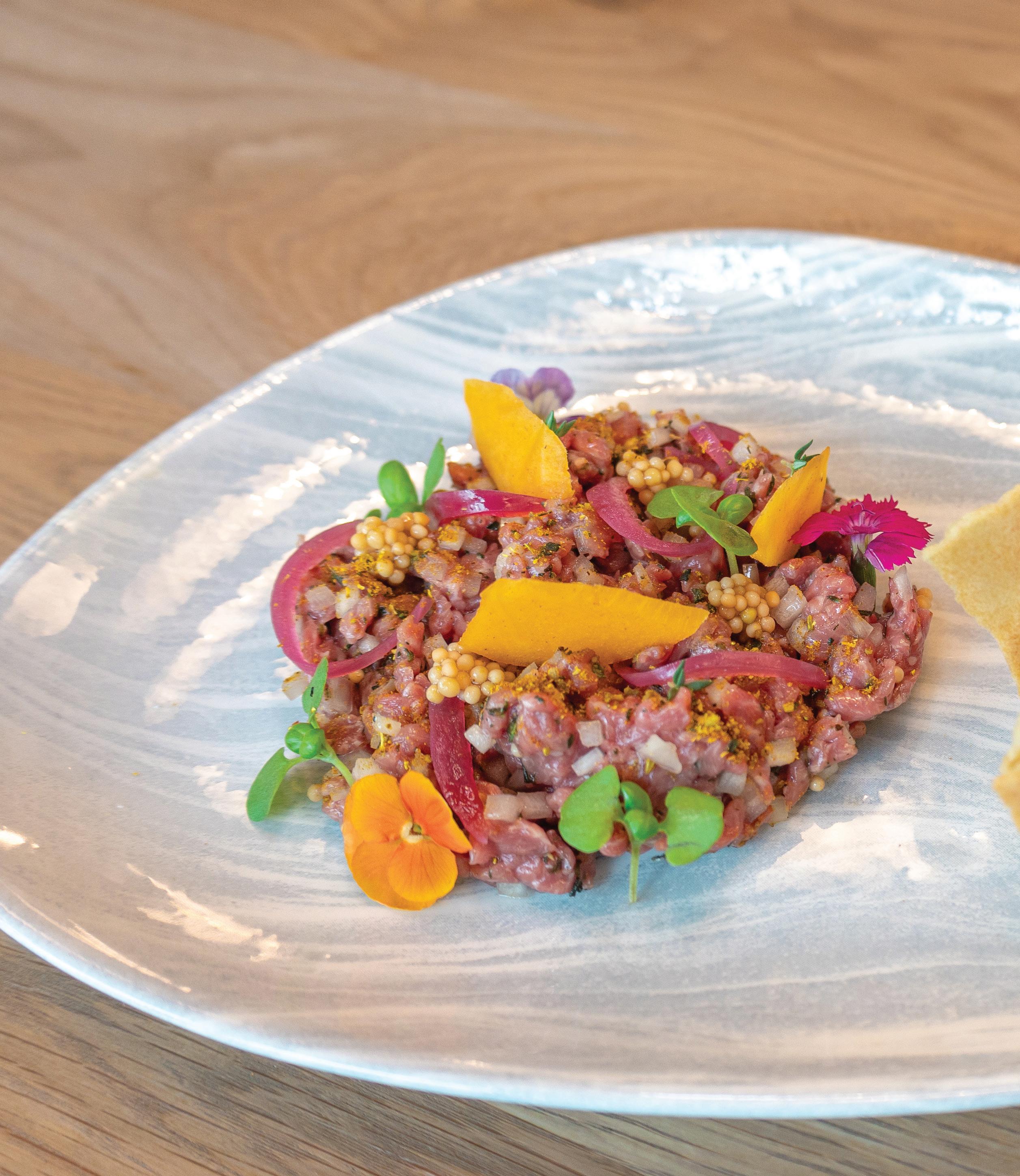 RECIPE BY ZOUHAIR BELLOUT
RECIPE BY ZOUHAIR BELLOUT
Yield: 2
Ingredients
Lamb Tartar
• 1 Lamb Loin
• 1 Tablespoon Ras el Hanout
• 1/2½Shallot (minced)
• 1 teaspoon Olive Oil
• 1 teaspoon Thyme (chopped)
• Salt and pepper (to taste)
Rosewater Pickled Onions
• 2 red Onions (thinly sliced)
• 1/2 cup Red Wine Vinegar
• 1/4 cup Honey
• 1 Tablespoon Rosewater
Pecorino Cracker
• 200 grams Pecorino Cheese (grated)
• 100 grams All-purpose Flour
• 130 grams Egg White
• 100 grams Butter (melted)
Preparation
Lamb Tartar
Mince the lamb in a mixing bowl using a whisk and season with the rest of the ingredients.
Rosewater Pickled Onions
Place the vinegar, honey, and rosewater in a pot, add the onions and bring to a simmer, stirring the onions. Drain and refrigerate the onions, reduce the liquid to a syrup, pour over the onion, mix well.
Pecorino Cracker
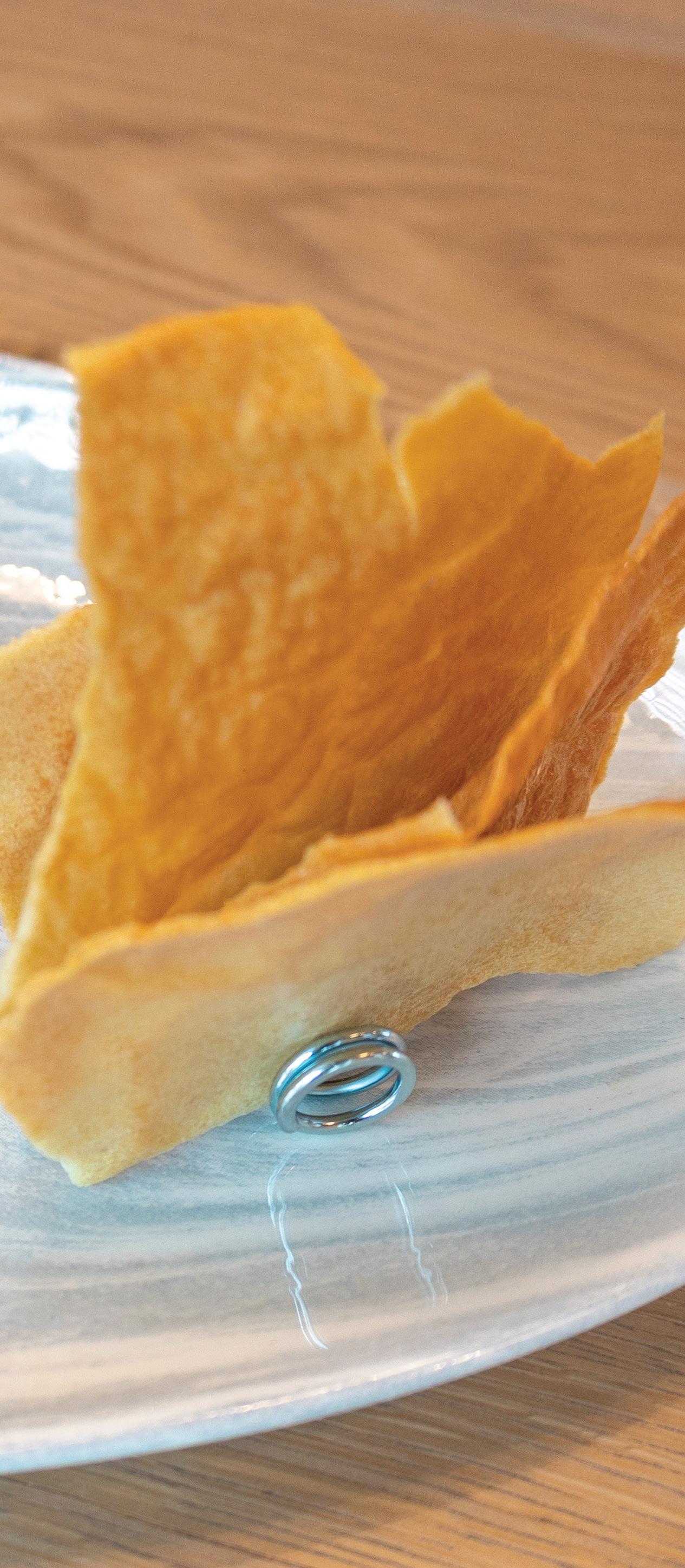
Mix all the ingredients in a mixing bowl using a whisk then spread on a Silpat, and bake at 300 F until golden brown. Cooldown and break into pieces.
Assembly
Arrange on a serving plate and garnish with pickled onions, persimmons, and the pickled mustard seeds. Serve with the pecorino crackers.
Cocktail Match
34*North, 5* West (Fez)
Inspired by Chef Zouhair Bellout
Gettin’ Figgy Wit It (see over for recipe)
*At Richlande Point we refer to the location from where the cocktail’s inspiration originated, by using longtitude and latitude.
Reynolds Lake Oconee 119
Image courtesy Reynolds Lake Oconee
34* North, 5* West (Fez)
~Inspired by Chef Zouhair Bellout~ Gettin’ Figgy Wit It
Ingredients
Moroccan Spiced Orange
• 6 Orange slices
• 1 teaspoon Cinnamon
• 1 Tablespoon Brown Sugar
• 1 pod Green Cardamom
Gettin’ Figgy Wit It
• 3/4 ounce Mahia Fig Liqueur
• 1/2 ounce Grand Marnier
• 1 1/2 ounces Empress Gin
Garnish
• Moroccan Spice Orange Wheel
• Mint Sprig
Preparation
Moroccan Spice Orange

Thinly slice orange wheels. Grind the sugar, cinamon and green cardamom seeds together in a spice grinder. Sprinkle onto the orange wheels and burlee with a torch.
Gettin’ Figgy Wit It
Fill a specialty rocks glass with ice. Add the Grand Marnier, Mahia Fig, liqueur, Empress Gin and top with fresh squeezed lemon juice, Empress Gin and soda water. Garnish with the Moroccan spiced orange wheel and a sprig of mint.
Inspiration
For this cocktail, we travel to Fez, Morocco for inspiration. Fez is the birthplace of our Executive Chef Zouhair Bellout. In his honor, we use a Moroccan spirit for the base of this drink. Mahia is a spirit derived from distilled figs and has a hint of aniseed. Mahia liqueur is widely considered the national spirit of Morocco, representing the country’s rich cultural history. We further enhance this celebration of Morocco in the orange garnish, which is spiced with an array of aromatics and caramelized. The herbaceous botanicals of the gin used in this cocktail helps further highlight the notes of Moroccan spices and flavors.
Golf Kitchen Magazine 120
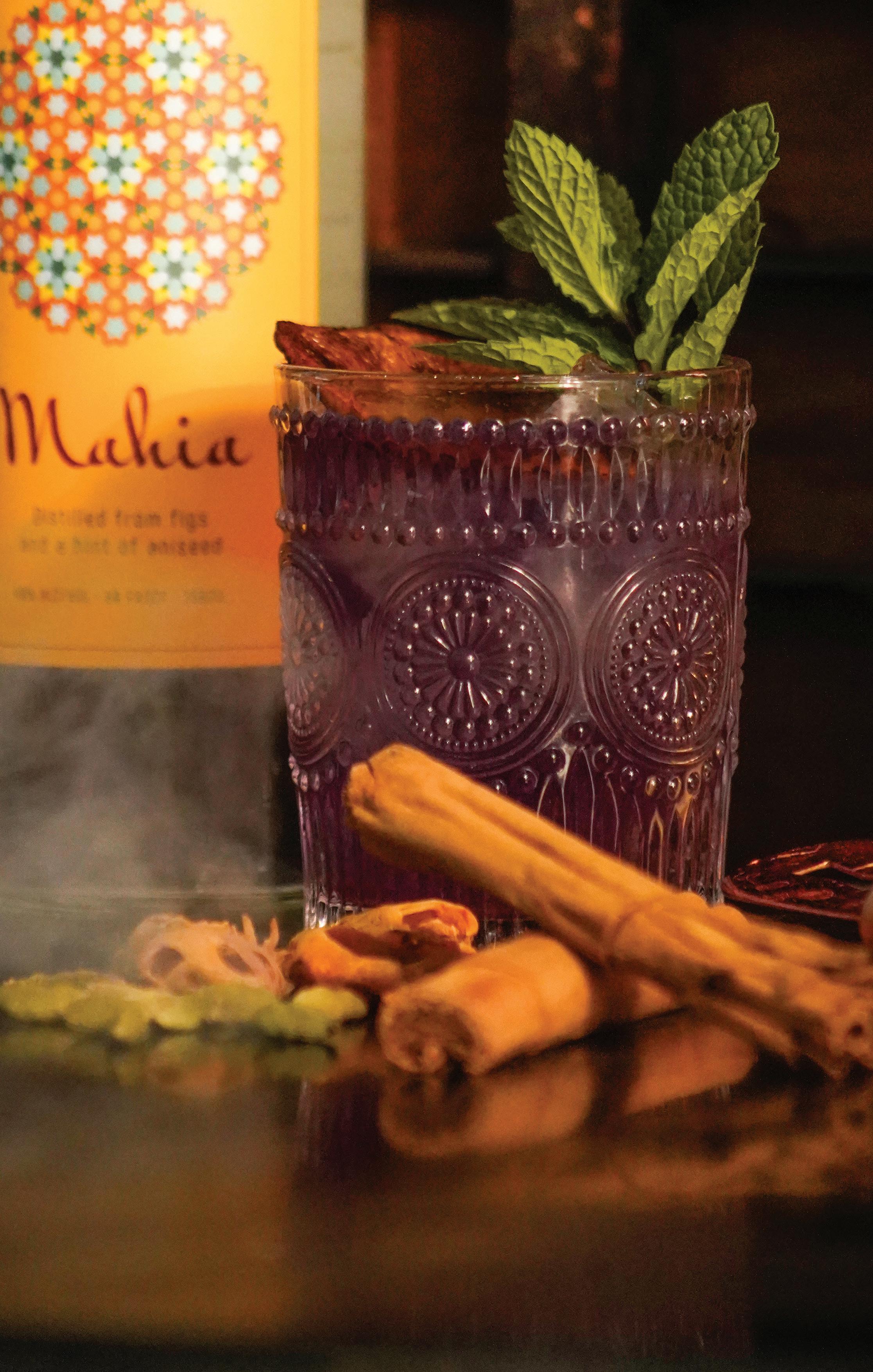

A CHEF’S LOOK AT BARDSTOWN BOURBON by WesTyler
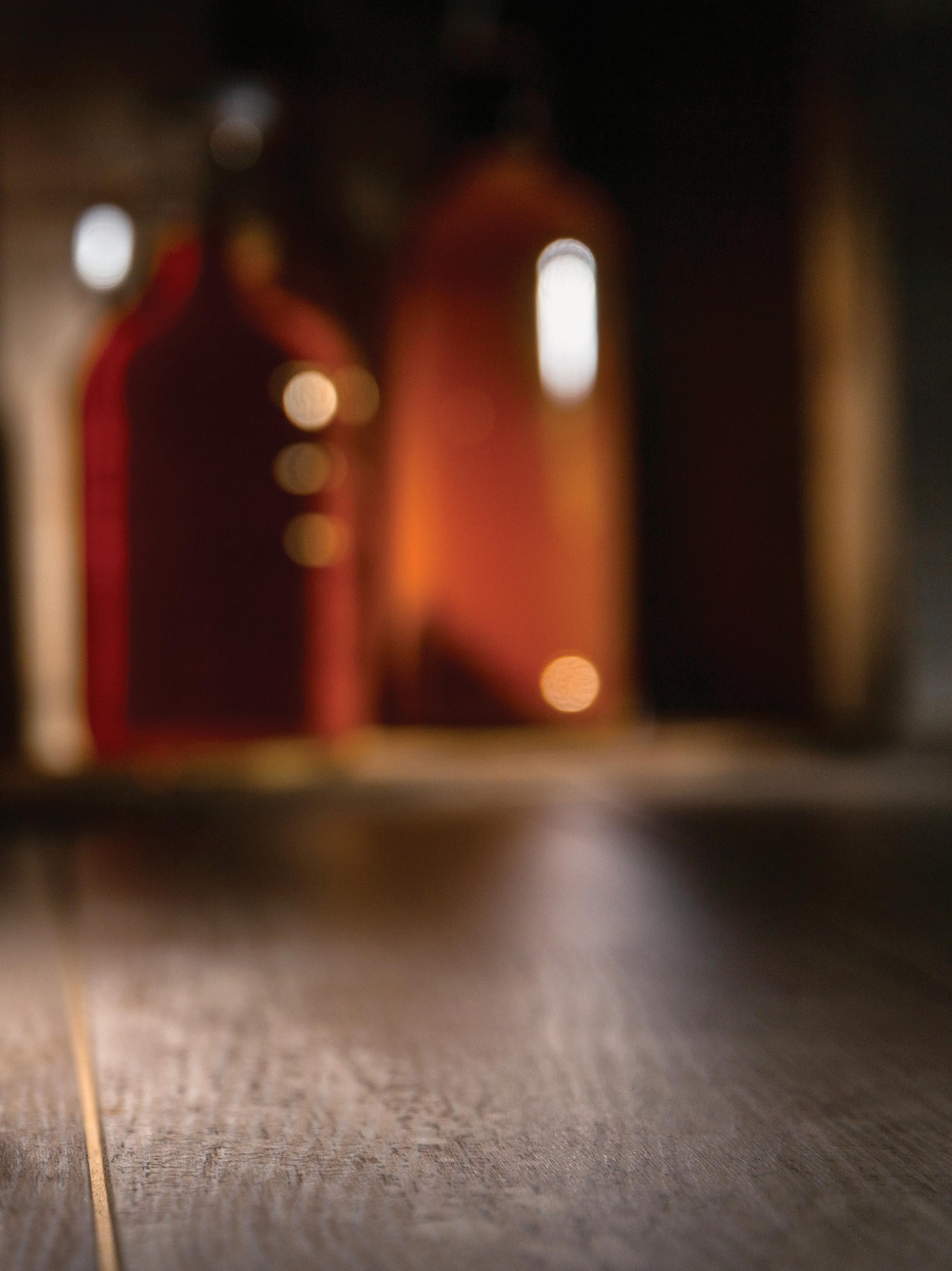
All Bourbon is Whiskey, but not all Whiskey is Bourbon
by Chef Wes Tyler CEC, CCA, WCMC
Growing up in a small town in Kentucky, I can remember waking up in the mornings to the smell of sour mash fermenting in the humid air, and barrels of bourbon aging in the rickhouses all across the countryside as the sun rose. It was an inescapable, breathtaking aroma so thick I could taste it as it encompassed the small city’s everyday life dating back hundreds of years. Consuming the senses, it defined the roots that have run deep for so long in my hometown, and to this day serves as a reminder of the heritage left behind from a long line of distillers passed down through generations pre-dating the prohibition era. From a young age, I have been surrounded by all facets of this industry.
It’s a surprising fact that there are more barrels of bourbon in Kentucky than there are people, which eludes to the immense number of jobs created throughout the state relative to bourbon. Many of my childhood friends are now involved in all corners of the market, and continue to honor this proud tradition today. Some were born into a long lineage of bourbon makers and now influence the future of the spirit, and others joined forces with the many thousands of people propelling the workforce across the sector. Reflecting on my past, I owe a fair amount of my own personal journey to the history of bourbon, and sincerely appreciate the liquid gold that has become even more popular in recent years. With the modern day “bourbon boom”, you can now find an unprecedented amount of new varietals, blends, and craft selections that are surfacing across the state and country as everyone makes their mark. New distilleries are popping up everywhere, and as a Chef this enthuses me even more then thinking of the foods that parallel bourbon so perfectly.
Deemed the bourbon capital of the world, Bardstown’s history has long been known for producing some of the best bourbons across the globe. Although bourbon can be made virtually anywhere, to be considered a true bourbon, most will contend that it has to be made in Kentucky. There are several misconceptions surrounding this ideology, however there are a few rules that clarify what bourbon is and has to be. According to Alcohol and Tobacco Tax and Trade Bureau (TTB), “these are the only requirements for the production of “authentic” bourbon: that it’s produced in the United States, made with a minimum 51% corn content, distilled to no higher than 160 proof, and barreled at no higher than 62.5% ABV in charred, new oak containers.” Arguably, Kentucky is proclaimed as being the sole source of true bourbon due to the use of its natural limestone filtered spring water that runs throughout the state, and the perfect soil mix and climate conditions that are present allowing bourbon to reach its “peak” during the aging process. That being said, if you ask any native Kentuckians, most will stand by the statement that if it’s not made in Kentucky it’s not true bourbon.
The uniquely layered flavor profiles associated with bourbon open up a blank canvas when it comes to culinary applications. Soft notes of vanilla, oak, caramelized sugars, and butterscotch bode well for a wide variety of confections like bourbon balls and bread pudding. Hints of corn, mushrooms, rosemary, and black pepper lend themselves to more savory applications. Much like wine, each bourbon presents its own set of distinctive flavors and characteristics influenced by a range of variabilities introduced at any given point during the production process. Each bourbon is tailored to stand out from the rest in one or many ways. As a chef, this platform provides a spring board for culinary inspiration. Whether utilizing bourbon as a component or ingredient in a dish, or simply pairing it with a meal, it has long been a highlight of my career. For me personally, the heritage that goes along with this spirit offers a story and direct connection with the food, and the versatility it offers leaves endless opportunities.
If you are new to bourbon, approach it as you would any other drink or ingredient and keep an open mind. Welcome the nuances and find the flavors that appeal to you. I would encourage you to explore this versatile liquor and dive in to the endless potential as you become educated. There are a variety of sources with an abundance of information, and tapping into these will only expand the possibilities associated with such. If you ever find yourself in Kentucky, take it upon yourself to visit the distilleries or travel the bourbon trail which highlights all of the best bourbons produced throughout the state. One can only ever be expected to know as much as they are willing to learn.
Golf Kitchen Magazine 124
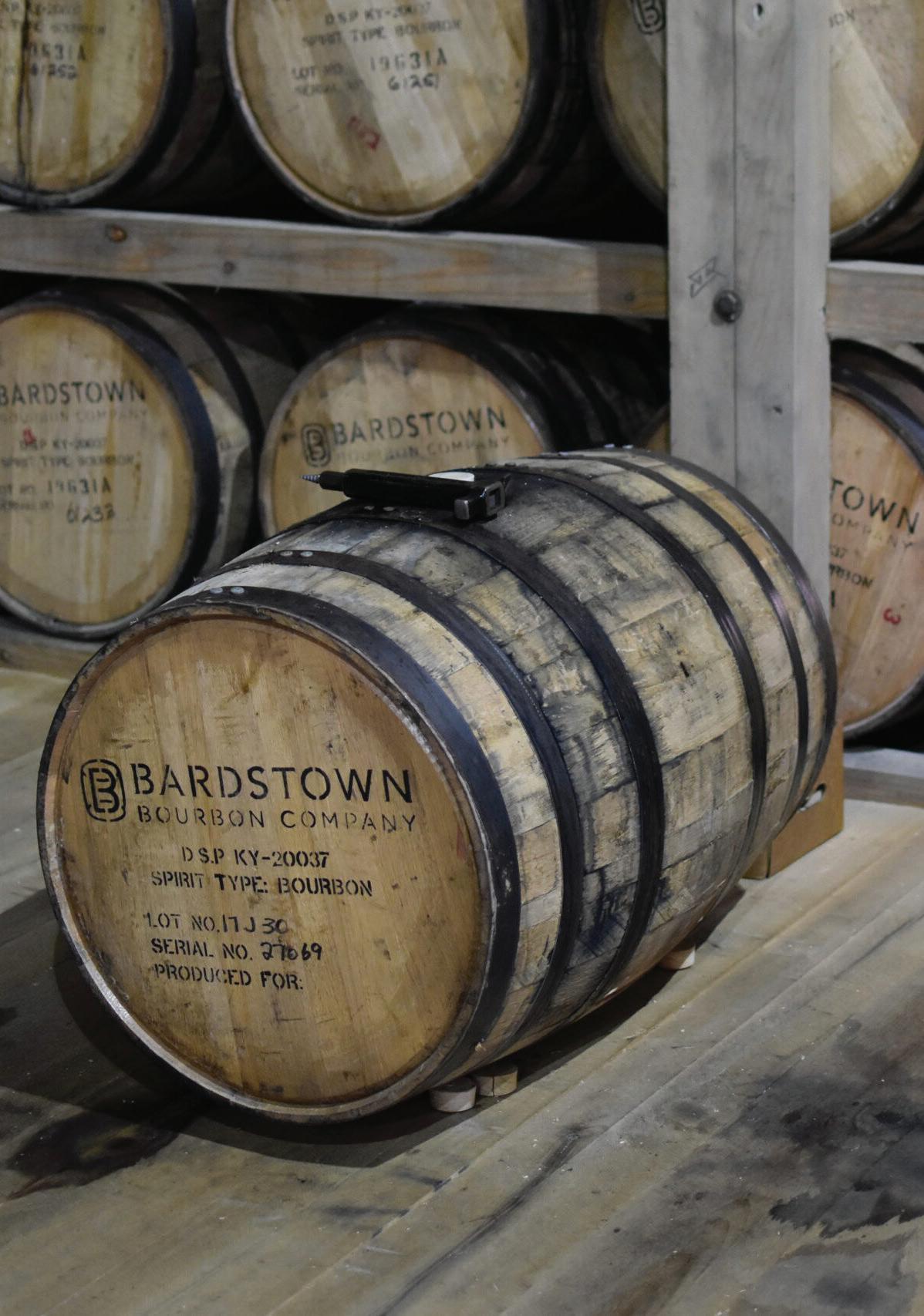

Simply put, bourbon is a favorite drink and ingredient of mine that’s good for just about any occasion. I enjoy cooking with it or sipping it on the rocks after a long shift, drinking it as a cocktail alongside a meal, or simply savoring the flavors neat as a night cap while winding down for the day. I find that a nice bourbon can take me to a place in my childhood and bring on a rush of memories that might otherwise be buried or forgotten. At the end of the day, each person will have their own preferences when it comes to the spirit, and will hopefully have their own stories that provoke some of the same familiarities and warm feelings that can be brought to life. The best part about enjoying bourbon is that anyone can unlock an enjoyable experience and create a memorable moment.
As a Chef, Kentucky native, and bourbon enthusiast, I will leave you with a final thought as you continue to develop your journey. Bourbon is Americas spirit, and whether you’re new to the craft or an old aficionado, it is what you want it to be…and remember…
”All bourbon is whiskey, but not all whiskey is bourbon.”
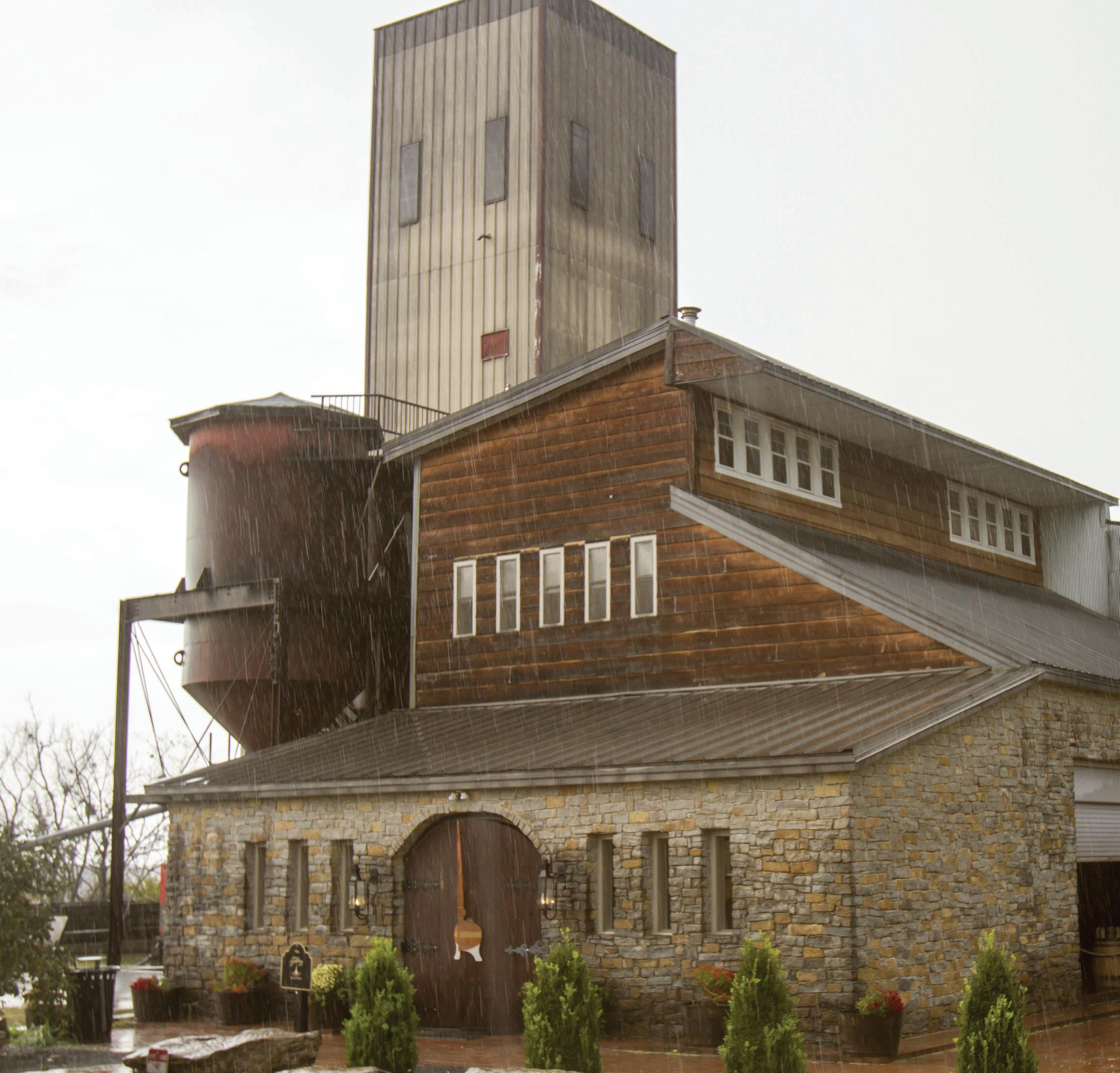 Wes Tyler CEC, CCA, WCMC
Willett Distillery
Wes Tyler CEC, CCA, WCMC
Willett Distillery
Clubhouse Cocktails CAMPFIRE OLD FASHIONED
Yield: One Ingredients
2 ounces Woodford Reserve Bourbon
2 ounces Orange Bitters
3 dashes Chocolate Bitters
5 ounces Maple Syrup
Garnish
Cinnamon Stick
Lemon Curl Luxardo Cherry
Preparation
In a rocks glass, stir the bourbon, orange bitters, chocolate bitters and maple syrup over a square or spherical ice cube and then garnish with a cinnamon stick, lemon curl and Luxardo cherry.
Smoke with maple chips in a High Order Drink Smoker: https://www.drinksmokers.com

Serve immediately.
Recipe by Jeremy Bland
The Club at Carlton Woods, The Woodlands, Texas, USA
Golf Kitchen Magazine 128


VIOLET SAGE SOUR
Yield: One
Ingredients
1 ounce Hendrix Gin
1/4 ounce Empress Gin
1 ounce Lemon Juice (fresh squeezed)
1 Egg White
1/2 ounce Sage Simple Syrup
Sage Simple Syrup
Yields: 2 cups
1 cup Water
1 cup Sugar
6 Sage Leaves
Garnish
Orange Peel Mint leaves
Preparation
Sage Simple Syrup
In a small saucepot over medium heat, combine all the ingredients and bring to a simmer. Let simmer for 5 minutes, stirring occasionally. Remove from heat, strain, let cool.
Assembly
Combine all of the ingredients into bar shaker Dry shake for 30 seconds (no ice) Wet shake (with ice) Strain into coupe glass Garnish with orange peel and mint leaves
Serve immediately.
Recipe by Alex Peltz, Lead Mixologist The Club at Carlton Woods, The Woodlands, Texas, USA
Clubhouse Cocktails 131
MELON MULE
Yield: One Ingredients
2 ounces Grey Goose Le Melon Vodka
4 ounces Barritt’s Ginger Beer
1 Lime Wedge
3 Mint Sprigs
Garnish
1 Lime Wedge
3 Mint Leaves
Fresh Honeydew (melon balls)
Preparation
Place the lime wedge and mint leaves into a bar shaker and muddle well. Add the vodka, then proceed to shake until thoroughly mixed. Remove muddled lime wedge, then pour into a copper mug or rocks glass and top with ice. Add the ginger beer, then garnish with a melon ball skewer and fresh mint sprig, or as otherwise desired.
Recipe by Shawn Olah Executive Chef at Highlands Falls Country Club Highlands, North Carolina
Golf Kitchen Magazine 132
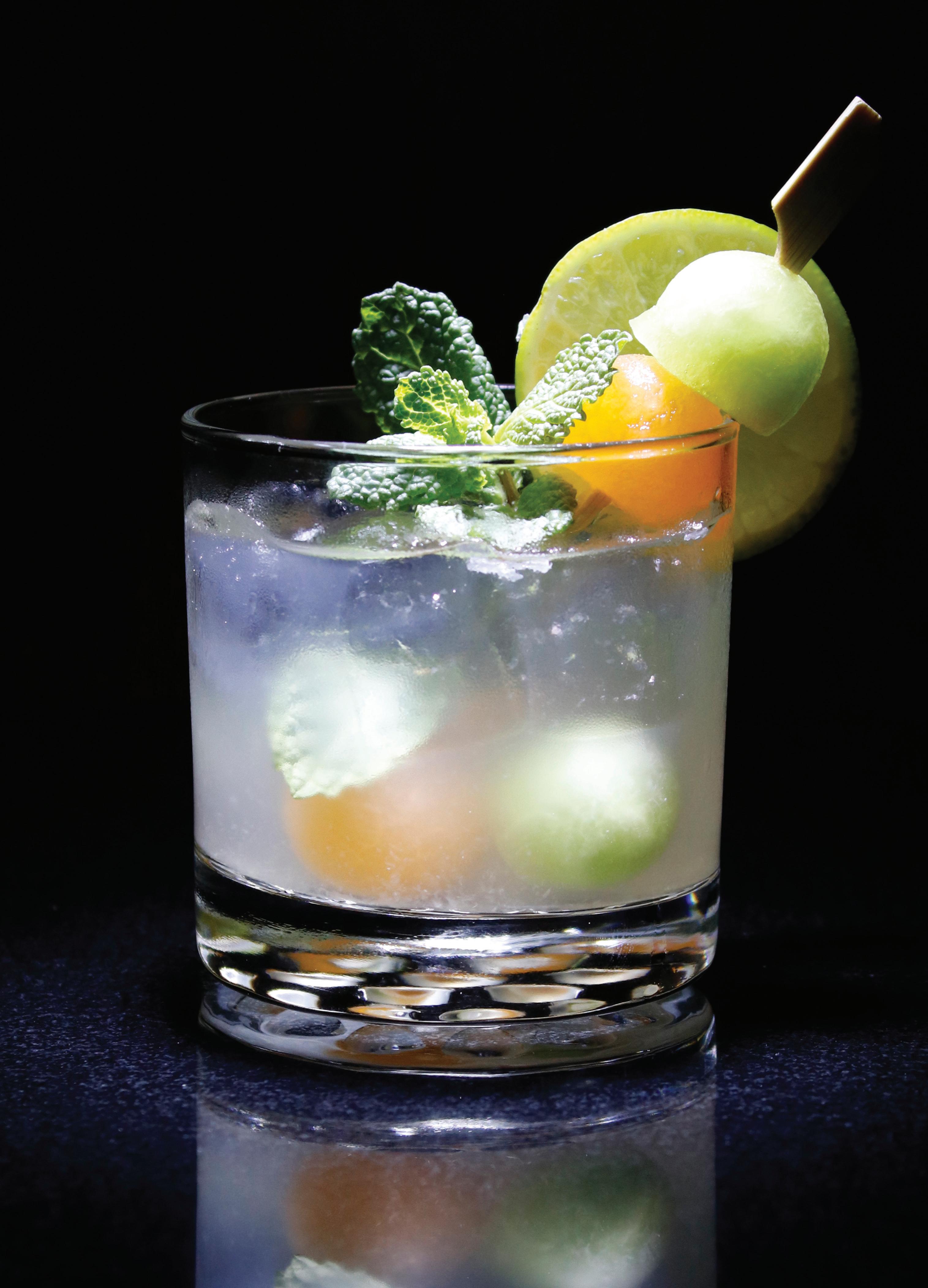

BLUEBERRY JAM
Yield: One
Ingredients
1 Meyer Lemon Wedge
1/2 ounce of Almond Syrup (see recipe)
2 1/2 ounces Midnight Moon Moonshine (80 proof)
1 ounce E&J XO Brandy
3 teaspoons Bonne Maman Blueberry Preserves
Almond Syrup
1 cup Water
1 cup Sugar
2 teaspoons Pure Almond Extract
Garnish
Meyer Lemon Wedge
Beet Blush Leaf (The Chef’s Garden)
Popcorn Shoots (The Chef’s Garden)
Blueberry
Preparation
Place lemon wedges, almond syrup and blueberry preserves in shaker. Muddle ingredients well, then add in moonshine, brandy and fill shaker with ice. Shake well to ensure blueberry preserves are broken up, then strain into a rocks or tulip glass. Garnish with Meyer lemon wedge, fresh blueberry and Chef’s Garden Beet Blush and Popcorn shoots. Serve immediately.
Recipe by Shawn Olah Executive Chef at Highlands Falls Country Club Highlands, North Carolina
Clubhouse Cocktails 135
22* SOUTH, 43* WEST (Rio de Janeiro)
~Inspired by Chuck Sapper, Mixologist~
Cherry Samba
Yield: One
Ingredients
1 1/2 Leblon Cachaca
1/2 Lime
4 Maraschino Cherries (destemmed)
½1/2 ounce Heering Cherry Liqueur
3/4 ounce Brown Sugar Syrup
Garnish
Maraschino Cherry (skewered over standing lime wedge)
Preparation
Quarter half a lime and add it to a bar tin. Add the maraschino cherries, Heering Cherry Liqueur, brown sugar syrup, and muddle. Add the Leblon Cachaca and ice. Shake to incorporate. Pour into a tall Collins glass. Finish if needed with additional ice and club soda.
Golf Kitchen Magazine 136
Image by Ben Volandt Dogwood Creative Studios
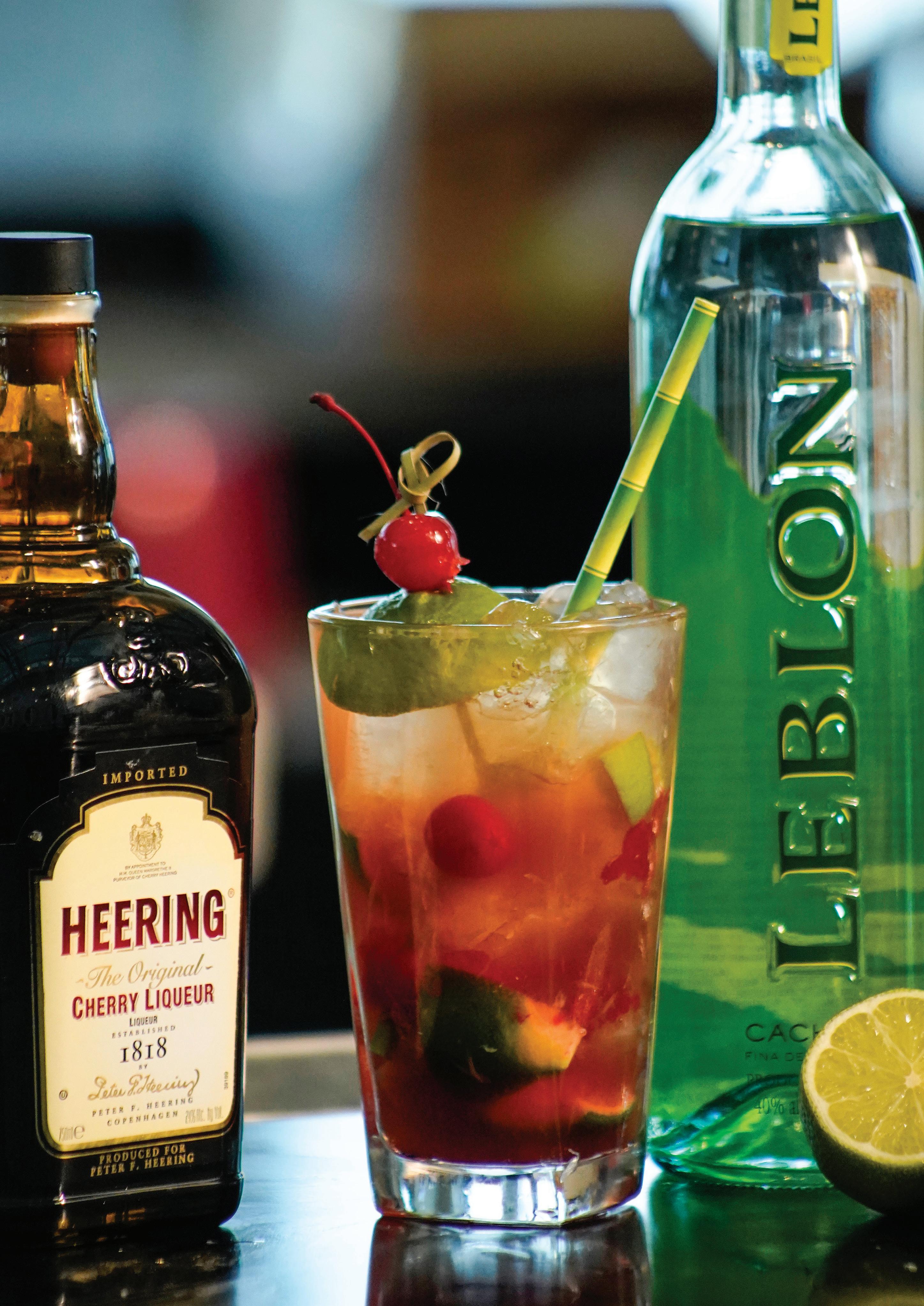

43* North, 11* East (Florence)
~Inspired by Chuck Spencer, Mixologist~
Lorenzo The Magnificen-Tini
Yield: One
Ingredients
1 ounce Tuaca Originale Italiano Liqueur
1 ounce Wheatley Craft Distilled Vodka
1 ounce Disaronno Amaretto
1.5 ounces Pineapple Juice (fresh juiced)
Garnish
Luxardo Cherry Pineapple (caramelized and diced)
Preparation
Fill a bar shaker with ice. Add the Wheatley Vodka, Tuaca, Amaretto, and Pineapple Juice. Shake vigorously and strain. Garnish with a Luxardo cherry and pineapple skewer.
Serve immediately!
Image by Ben Volandt Dogwood Creative Studios
Clubhouse Cocktails 139
Ten Top Club Chefs
Jonathan Hancock, 36 Executive Chef at Richland Country Club Nashville, Tennessee
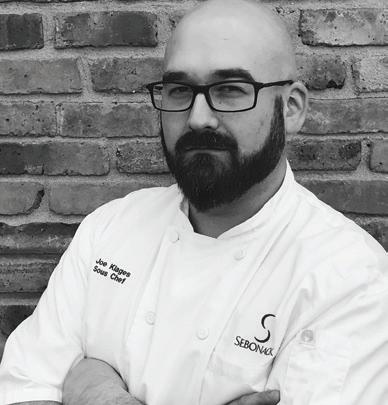


Wes Tyler, 34 Executive Chef at The Club at Carlton Woods The Woodlands, Texas
Shawn Olah, 34 Executive Chef at Highlands Falls Country Club

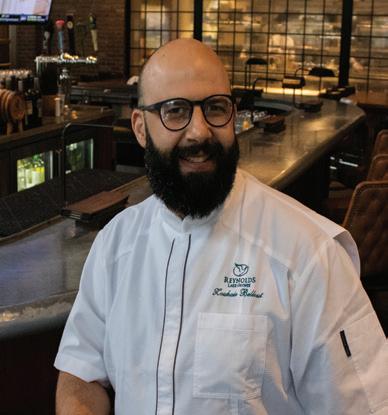
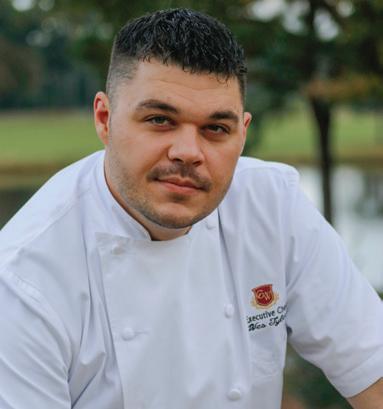
Highlands, North Carolina
Zouhair Bellout, 40 Executive Chef at Reynolds Lake Oconee
Greensboro, Georgia
Joseph Klages, 35
Executive Sous Chef at Sebonack Golf Club
Southampton, New York
Golf Kitchen Magazine 140
40 and Under, 2022
Callie Meyer, 39 Executive Pastry Chef at Wycliffe Golf & Country Club Wellington, Florida
Matt O’Connor, 40 Executive Chef at Wee Burn Country Club Darien, Connecticut

Marisa Hernandez, 33 Executive Pastry Chef at GlenArbor Golf Club Bedford Hills, New York


Juan Pablo de la Sota Riva, 40 Executive Chef at Royal Poinciana Golf Club Naples, Florida

Dan Hess, 24 Chef de Cuisine at Westchester Hills Golf Club White Plains, New York
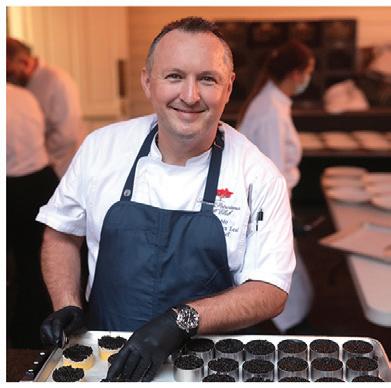 by Diana DeLucia
by Diana DeLucia
Golf Kitchen Magazine 141
Notes





































 Main Clubhouse and Hole #10
Image by Michelle Muraco
Main Clubhouse and Hole #10
Image by Michelle Muraco







 Clubhouse deck overlooking trout-stocked ponds on hole #10
Image by Traci Rhoads Interiors, LLC
Clubhouse deck overlooking trout-stocked ponds on hole #10
Image by Traci Rhoads Interiors, LLC





 RECIPE BY SHAWN OLAH
RECIPE BY SHAWN OLAH

 Jessica Emery, Associate Sommelier, CMS 2019
Scenic hole #10 presents a challenging 150ft. vertical drop to the green. Image by Michelle Muraco
Jessica Emery, Associate Sommelier, CMS 2019
Scenic hole #10 presents a challenging 150ft. vertical drop to the green. Image by Michelle Muraco
 RECIPE BY SHAWN OLAH
RECIPE BY SHAWN OLAH

 Holes #14 & 16 make up the heart of the course and what's affectionately known as 'Mayhem Corner'
Image by Michelle Muraco
Holes #14 & 16 make up the heart of the course and what's affectionately known as 'Mayhem Corner'
Image by Michelle Muraco


 The Clubhouse and updated Fitness Center over looking hole #17.
Image by Michelle Muraco
The Clubhouse and updated Fitness Center over looking hole #17.
Image by Michelle Muraco
















 Arista, Chardonnay, Ritchie Vineyard, Russian River Valley, California 2018
Poggio Antico, Altero, Brunello di Montalcino, Tuscany, Italy 2016
Arista, Chardonnay, Ritchie Vineyard, Russian River Valley, California 2018
Poggio Antico, Altero, Brunello di Montalcino, Tuscany, Italy 2016




 Nicklaus Clubhouse Lobby
Image courtesy The Club at Carlton Woods
Nicklaus Clubhouse Lobby
Image courtesy The Club at Carlton Woods

 Hole 3 at the Fazio Course
Image courtesy The Club at Carlton Woods
RECIPE BY WES TYLER AND VANESSA TRISTAN
Hole 3 at the Fazio Course
Image courtesy The Club at Carlton Woods
RECIPE BY WES TYLER AND VANESSA TRISTAN

 Tuscany Room
Image courtesy The Club at Carlton Woods
Tuscany Room
Image courtesy The Club at Carlton Woods
 ~ Kyle Holmes, CS, CMS
~ Kyle Holmes, CS, CMS


 Fazio Wine Room
Image courtesy The Club at Carlton Woods
Fazio Wine Room
Image courtesy The Club at Carlton Woods
 ~ Kyle Holmes, CS, CMS
~ Kyle Holmes, CS, CMS


 Nicklaus Founder’s Lounge Bar
Image courtesy The Club at Carlton Woods
Nicklaus Founder’s Lounge Bar
Image courtesy The Club at Carlton Woods
 Kyle Holmes, CS, CMS
Kyle Holmes, CS, CMS
 RECIPE WES TYLER, ADAM JEMMOTT, JEREMY BLAND
RECIPE WES TYLER, ADAM JEMMOTT, JEREMY BLAND


 Vineyard ploughing at Joseph Drouhin Clos des Mouches
RECIPE BY WES TYLER
Vineyard ploughing at Joseph Drouhin Clos des Mouches
RECIPE BY WES TYLER


 The 7th hole at the Nicklaus course Image courtesy The Club at Carlton Woods
RECIPE BY WES TYLER, VANESSA TRISTAN
The 7th hole at the Nicklaus course Image courtesy The Club at Carlton Woods
RECIPE BY WES TYLER, VANESSA TRISTAN

















 Richland Pointe Restaurant
Image courtesy Reynolds Lake Oconee
Richland Pointe Restaurant
Image courtesy Reynolds Lake Oconee



 ~ Reuben Atkinson, Cellar Wine Manager
~ Reuben Atkinson, Cellar Wine Manager
 The Creek Club Restaurant
Image courtesy Reynolds Lake Oconee
RECIPE BY ZOUHAIR BELLOUT
The Creek Club Restaurant
Image courtesy Reynolds Lake Oconee
RECIPE BY ZOUHAIR BELLOUT



 The Creek Club course, hole #5
Image courtesy Reynolds Lake Oconee
The Creek Club course, hole #5
Image courtesy Reynolds Lake Oconee

 Image courtesy Reynolds Lake Oconee
RECIPE BY ZOUHAIR BELLOUT
Image courtesy Reynolds Lake Oconee
RECIPE BY ZOUHAIR BELLOUT



 Image courtesy Reynolds Lake Oconee
RECIPE BY ZOUHAIR BELLOUT
Image courtesy Reynolds Lake Oconee
RECIPE BY ZOUHAIR BELLOUT



 RECIPE BY ZOUHAIR BELLOUT
RECIPE BY ZOUHAIR BELLOUT







 Wes Tyler CEC, CCA, WCMC
Willett Distillery
Wes Tyler CEC, CCA, WCMC
Willett Distillery
















 by Diana DeLucia
by Diana DeLucia
